Codan 2110 2110 SSB Transceiver User Manual 15 04135 EN 1
Codan Limited 2110 SSB Transceiver 15 04135 EN 1
Codan >
Contents
Reference Manual a
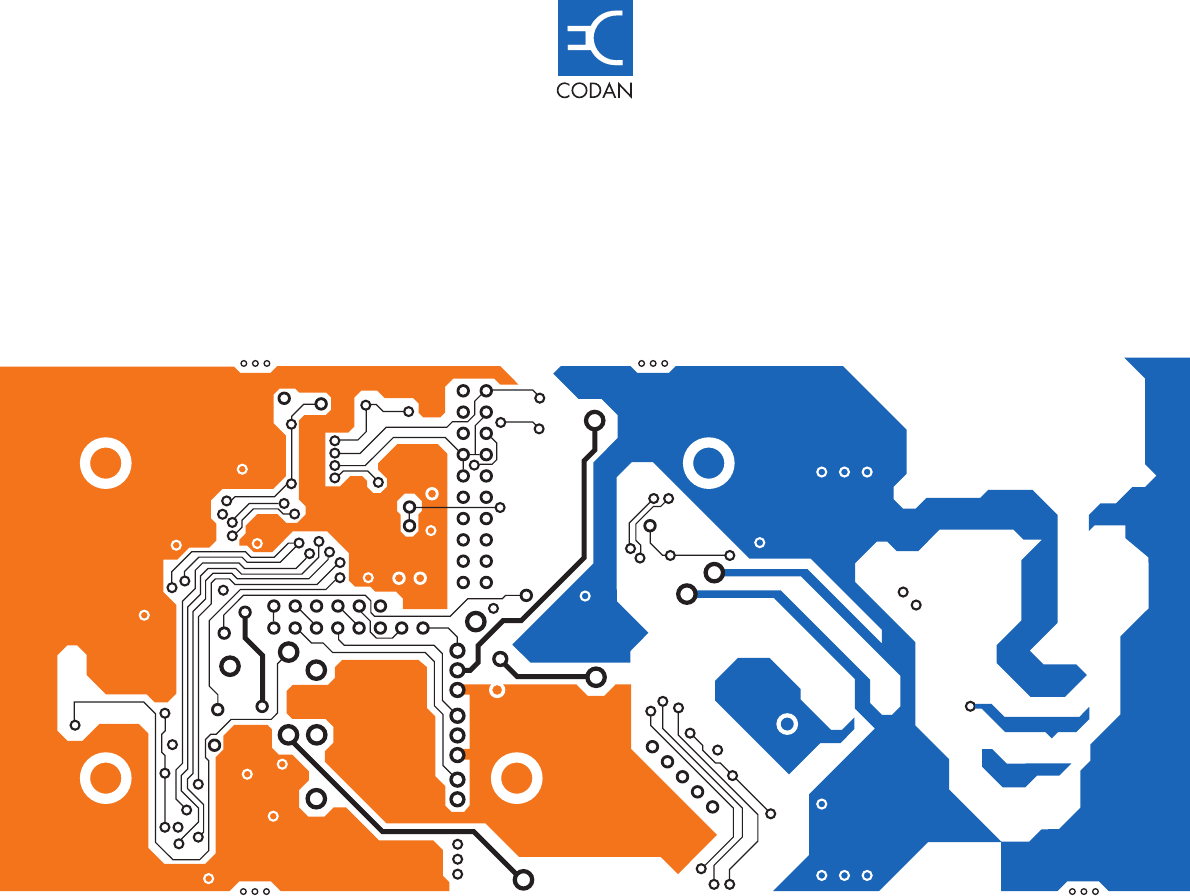
H F R A D I O C O M M U N I C A T I O N S
REFERENCE MANUALREFERENCE MANUAL
SSB Transceiver
2110
No part of this reference manual may be reproduced, transcribed, translated into any
language or transmitted in any form whatsoever without the prior written consent of
Codan Limited.
© Copyright 2004 Codan Limited.
Codan part number 15-04135-EN Issue 1, November 2004
CALM® is a registered trademark of Codan Limited. Other brand, product, and company
names mentioned in this document are trademarks or registered trademarks of their
respective holders.
The English version takes precedence over any translated versions.

2110 SSB Transceiver Reference Manual i
CODAN
Table of contents
1 About this manual
Standards and icons . . . . . . . . . . . . . . . . . . . . . . . . . . . . . . . . . . . . . . . . . . . . . . . . . . . . . . . . . . . . . . .3
Definitions . . . . . . . . . . . . . . . . . . . . . . . . . . . . . . . . . . . . . . . . . . . . . . . . . . . . . . . . . . . . . . . . . . . . . .4
Acronyms and abbreviations . . . . . . . . . . . . . . . . . . . . . . . . . . . . . . . . . . . . . . . . . . . . . . . . . . . . . .4
Glossary . . . . . . . . . . . . . . . . . . . . . . . . . . . . . . . . . . . . . . . . . . . . . . . . . . . . . . . . . . . . . . . . . . . . . .6
Units. . . . . . . . . . . . . . . . . . . . . . . . . . . . . . . . . . . . . . . . . . . . . . . . . . . . . . . . . . . . . . . . . . . . . . . .10
Unit multipliers . . . . . . . . . . . . . . . . . . . . . . . . . . . . . . . . . . . . . . . . . . . . . . . . . . . . . . . . . . . . . . .10
About this issue . . . . . . . . . . . . . . . . . . . . . . . . . . . . . . . . . . . . . . . . . . . . . . . . . . . . . . . . . . . . . . . . .11
2 2110 SSB Transceiver compliance
Introduction . . . . . . . . . . . . . . . . . . . . . . . . . . . . . . . . . . . . . . . . . . . . . . . . . . . . . . . . . . . . . . . . . . . .14
European Radio and Telecommunications Terminal Equipment Directive. . . . . . . . . . . . . . . . . . . .15
Electromagnetic compatibility and safety notices . . . . . . . . . . . . . . . . . . . . . . . . . . . . . . . . . . . . . . .16
C-tick approval . . . . . . . . . . . . . . . . . . . . . . . . . . . . . . . . . . . . . . . . . . . . . . . . . . . . . . . . . . . . . . . . . .18
Care and safety information . . . . . . . . . . . . . . . . . . . . . . . . . . . . . . . . . . . . . . . . . . . . . . . . . . . . . . . .19
3 HF radio transmission
HF radio transmission. . . . . . . . . . . . . . . . . . . . . . . . . . . . . . . . . . . . . . . . . . . . . . . . . . . . . . . . . . . . .22
Frequency, distance and time of day . . . . . . . . . . . . . . . . . . . . . . . . . . . . . . . . . . . . . . . . . . . . . . .23
Channels and modes . . . . . . . . . . . . . . . . . . . . . . . . . . . . . . . . . . . . . . . . . . . . . . . . . . . . . . . . . . .23
Networks and scanning . . . . . . . . . . . . . . . . . . . . . . . . . . . . . . . . . . . . . . . . . . . . . . . . . . . . . . . . .24
Etiquette for the use of HF radio . . . . . . . . . . . . . . . . . . . . . . . . . . . . . . . . . . . . . . . . . . . . . . . . . . . .25
4 The 2110 SSB Transceiver
The front panel . . . . . . . . . . . . . . . . . . . . . . . . . . . . . . . . . . . . . . . . . . . . . . . . . . . . . . . . . . . . . . . . . .28
User controls . . . . . . . . . . . . . . . . . . . . . . . . . . . . . . . . . . . . . . . . . . . . . . . . . . . . . . . . . . . . . . . . .28
Interface connectors. . . . . . . . . . . . . . . . . . . . . . . . . . . . . . . . . . . . . . . . . . . . . . . . . . . . . . . . . . . .29
Antennas . . . . . . . . . . . . . . . . . . . . . . . . . . . . . . . . . . . . . . . . . . . . . . . . . . . . . . . . . . . . . . . . . . . .29
Hot keys . . . . . . . . . . . . . . . . . . . . . . . . . . . . . . . . . . . . . . . . . . . . . . . . . . . . . . . . . . . . . . . . . . . . . . .30
Handset . . . . . . . . . . . . . . . . . . . . . . . . . . . . . . . . . . . . . . . . . . . . . . . . . . . . . . . . . . . . . . . . . . . . . . . .32
5 Preparing the 2110 SSB Transceiver for use
Charging a battery . . . . . . . . . . . . . . . . . . . . . . . . . . . . . . . . . . . . . . . . . . . . . . . . . . . . . . . . . . . . . . .34
Connecting a battery to the transceiver . . . . . . . . . . . . . . . . . . . . . . . . . . . . . . . . . . . . . . . . . . . . . . .36
Inserting the transceiver into a backpack . . . . . . . . . . . . . . . . . . . . . . . . . . . . . . . . . . . . . . . . . . . . . .36
Selecting an appropriate antenna . . . . . . . . . . . . . . . . . . . . . . . . . . . . . . . . . . . . . . . . . . . . . . . . . . . .37
Troubleshooting the transceiver . . . . . . . . . . . . . . . . . . . . . . . . . . . . . . . . . . . . . . . . . . . . . . . . . . . . .41
Testing the installation . . . . . . . . . . . . . . . . . . . . . . . . . . . . . . . . . . . . . . . . . . . . . . . . . . . . . . . . . . . .42
Voltage standing wave ratio . . . . . . . . . . . . . . . . . . . . . . . . . . . . . . . . . . . . . . . . . . . . . . . . . . . . .42
On-air testing . . . . . . . . . . . . . . . . . . . . . . . . . . . . . . . . . . . . . . . . . . . . . . . . . . . . . . . . . . . . . . . . .43

Table of contents
ii 2110 SSB Transceiver Reference Manual
6 Operating the transceiver
Switching on the transceiver . . . . . . . . . . . . . . . . . . . . . . . . . . . . . . . . . . . . . . . . . . . . . . . . . . . . . . . 46
The front panel screen . . . . . . . . . . . . . . . . . . . . . . . . . . . . . . . . . . . . . . . . . . . . . . . . . . . . . . . . . . . . 47
The channel screen . . . . . . . . . . . . . . . . . . . . . . . . . . . . . . . . . . . . . . . . . . . . . . . . . . . . . . . . . . . . . . 48
Battery status indicator . . . . . . . . . . . . . . . . . . . . . . . . . . . . . . . . . . . . . . . . . . . . . . . . . . . . . . . . . 50
External power supply indicator . . . . . . . . . . . . . . . . . . . . . . . . . . . . . . . . . . . . . . . . . . . . . . . . . . 51
Selecting a channel . . . . . . . . . . . . . . . . . . . . . . . . . . . . . . . . . . . . . . . . . . . . . . . . . . . . . . . . . . . . 51
Entering and editing text . . . . . . . . . . . . . . . . . . . . . . . . . . . . . . . . . . . . . . . . . . . . . . . . . . . . . . . . . . 52
The editable screens . . . . . . . . . . . . . . . . . . . . . . . . . . . . . . . . . . . . . . . . . . . . . . . . . . . . . . . . . . . 52
Editing a screen. . . . . . . . . . . . . . . . . . . . . . . . . . . . . . . . . . . . . . . . . . . . . . . . . . . . . . . . . . . . . . . 53
Quick Start. . . . . . . . . . . . . . . . . . . . . . . . . . . . . . . . . . . . . . . . . . . . . . . . . . . . . . . . . . . . . . . . . . . . . 57
Muting the transceiver . . . . . . . . . . . . . . . . . . . . . . . . . . . . . . . . . . . . . . . . . . . . . . . . . . . . . . . . . . . . 61
Scanning channels . . . . . . . . . . . . . . . . . . . . . . . . . . . . . . . . . . . . . . . . . . . . . . . . . . . . . . . . . . . . . . . 62
Using the microphone . . . . . . . . . . . . . . . . . . . . . . . . . . . . . . . . . . . . . . . . . . . . . . . . . . . . . . . . . . . . 63
Finding words and values . . . . . . . . . . . . . . . . . . . . . . . . . . . . . . . . . . . . . . . . . . . . . . . . . . . . . . . . . 64
Setting the basics . . . . . . . . . . . . . . . . . . . . . . . . . . . . . . . . . . . . . . . . . . . . . . . . . . . . . . . . . . . . . . . . 67
Setting the time and date. . . . . . . . . . . . . . . . . . . . . . . . . . . . . . . . . . . . . . . . . . . . . . . . . . . . . . . . 67
Displaying the local time and date . . . . . . . . . . . . . . . . . . . . . . . . . . . . . . . . . . . . . . . . . . . . . . . . 69
Entering your station self address . . . . . . . . . . . . . . . . . . . . . . . . . . . . . . . . . . . . . . . . . . . . . . . . . 69
Changing the screen contrast . . . . . . . . . . . . . . . . . . . . . . . . . . . . . . . . . . . . . . . . . . . . . . . . . . . . 74
Changing the screen brightness . . . . . . . . . . . . . . . . . . . . . . . . . . . . . . . . . . . . . . . . . . . . . . . . . . 74
Using hot keys . . . . . . . . . . . . . . . . . . . . . . . . . . . . . . . . . . . . . . . . . . . . . . . . . . . . . . . . . . . . . . . . . . 75
Tuning the antenna . . . . . . . . . . . . . . . . . . . . . . . . . . . . . . . . . . . . . . . . . . . . . . . . . . . . . . . . . . . . . . 76
Automatic tuning . . . . . . . . . . . . . . . . . . . . . . . . . . . . . . . . . . . . . . . . . . . . . . . . . . . . . . . . . . . . . 76
Manual tuning . . . . . . . . . . . . . . . . . . . . . . . . . . . . . . . . . . . . . . . . . . . . . . . . . . . . . . . . . . . . . . . . 77
Using the clarifier . . . . . . . . . . . . . . . . . . . . . . . . . . . . . . . . . . . . . . . . . . . . . . . . . . . . . . . . . . . . . . . 78
Reducing background noise with Easitalk. . . . . . . . . . . . . . . . . . . . . . . . . . . . . . . . . . . . . . . . . . . . . 79
Using the voice encryptor . . . . . . . . . . . . . . . . . . . . . . . . . . . . . . . . . . . . . . . . . . . . . . . . . . . . . . . . . 80
Using the voice encryptor . . . . . . . . . . . . . . . . . . . . . . . . . . . . . . . . . . . . . . . . . . . . . . . . . . . . . . . 80
Setting up the voice encryptor . . . . . . . . . . . . . . . . . . . . . . . . . . . . . . . . . . . . . . . . . . . . . . . . . . . 84
7 Using lists
The Main Menu . . . . . . . . . . . . . . . . . . . . . . . . . . . . . . . . . . . . . . . . . . . . . . . . . . . . . . . . . . . . . . . . . 88
Selecting a list . . . . . . . . . . . . . . . . . . . . . . . . . . . . . . . . . . . . . . . . . . . . . . . . . . . . . . . . . . . . . . . . . . 90
The List Manager. . . . . . . . . . . . . . . . . . . . . . . . . . . . . . . . . . . . . . . . . . . . . . . . . . . . . . . . . . . . . . . . 91
Using the List Manager. . . . . . . . . . . . . . . . . . . . . . . . . . . . . . . . . . . . . . . . . . . . . . . . . . . . . . . . . 91
Entries in the List Manager. . . . . . . . . . . . . . . . . . . . . . . . . . . . . . . . . . . . . . . . . . . . . . . . . . . . . . 92
Setting a marker. . . . . . . . . . . . . . . . . . . . . . . . . . . . . . . . . . . . . . . . . . . . . . . . . . . . . . . . . . . . . . . . . 94
Setting the home screen. . . . . . . . . . . . . . . . . . . . . . . . . . . . . . . . . . . . . . . . . . . . . . . . . . . . . . . . . . . 95
Changing a setting in the Control List. . . . . . . . . . . . . . . . . . . . . . . . . . . . . . . . . . . . . . . . . . . . . . . . 96
Making changes to all other lists . . . . . . . . . . . . . . . . . . . . . . . . . . . . . . . . . . . . . . . . . . . . . . . . . . . . 97
Hiding and showing settings . . . . . . . . . . . . . . . . . . . . . . . . . . . . . . . . . . . . . . . . . . . . . . . . . . . . . . 101

Table of contents
2110 SSB Transceiver Reference Manual iii
Grouping and ungrouping entries . . . . . . . . . . . . . . . . . . . . . . . . . . . . . . . . . . . . . . . . . . . . . . . . . . .103
Restricting access to information . . . . . . . . . . . . . . . . . . . . . . . . . . . . . . . . . . . . . . . . . . . . . . . . . . .108
Logging into admin level . . . . . . . . . . . . . . . . . . . . . . . . . . . . . . . . . . . . . . . . . . . . . . . . . . . . . . . . .110
Displaying full and normal view . . . . . . . . . . . . . . . . . . . . . . . . . . . . . . . . . . . . . . . . . . . . . . . . . . .112
Hiding and showing information . . . . . . . . . . . . . . . . . . . . . . . . . . . . . . . . . . . . . . . . . . . . . . . . . . .113
Locking and unlocking information . . . . . . . . . . . . . . . . . . . . . . . . . . . . . . . . . . . . . . . . . . . . . . . . .115
8 The Channel List
About channels . . . . . . . . . . . . . . . . . . . . . . . . . . . . . . . . . . . . . . . . . . . . . . . . . . . . . . . . . . . . . . . . .118
Settings in the Channel List . . . . . . . . . . . . . . . . . . . . . . . . . . . . . . . . . . . . . . . . . . . . . . . . . . . . . . .118
Programming the Channel List. . . . . . . . . . . . . . . . . . . . . . . . . . . . . . . . . . . . . . . . . . . . . . . . . . . . .119
9 The Network List
About networks . . . . . . . . . . . . . . . . . . . . . . . . . . . . . . . . . . . . . . . . . . . . . . . . . . . . . . . . . . . . . . . .122
Settings in the Network List . . . . . . . . . . . . . . . . . . . . . . . . . . . . . . . . . . . . . . . . . . . . . . . . . . . . . . .123
Special network names . . . . . . . . . . . . . . . . . . . . . . . . . . . . . . . . . . . . . . . . . . . . . . . . . . . . . . . . . . .127
Programming the Network List . . . . . . . . . . . . . . . . . . . . . . . . . . . . . . . . . . . . . . . . . . . . . . . . . . . .128
10 The NET List
About NETs . . . . . . . . . . . . . . . . . . . . . . . . . . . . . . . . . . . . . . . . . . . . . . . . . . . . . . . . . . . . . . . . . . .132
Settings in the NET List . . . . . . . . . . . . . . . . . . . . . . . . . . . . . . . . . . . . . . . . . . . . . . . . . . . . . . . . . .134
Programming the NET List . . . . . . . . . . . . . . . . . . . . . . . . . . . . . . . . . . . . . . . . . . . . . . . . . . . . . . .138
11 The Phone Link List
About phone links. . . . . . . . . . . . . . . . . . . . . . . . . . . . . . . . . . . . . . . . . . . . . . . . . . . . . . . . . . . . . . .142
Settings in the Phone Link List . . . . . . . . . . . . . . . . . . . . . . . . . . . . . . . . . . . . . . . . . . . . . . . . . . . .142
Programming the Phone Link List . . . . . . . . . . . . . . . . . . . . . . . . . . . . . . . . . . . . . . . . . . . . . . . . . .143
12 The Address List
About the Address List. . . . . . . . . . . . . . . . . . . . . . . . . . . . . . . . . . . . . . . . . . . . . . . . . . . . . . . . . . .146
Settings in the Address List . . . . . . . . . . . . . . . . . . . . . . . . . . . . . . . . . . . . . . . . . . . . . . . . . . . . . . .147
Setting up the emergency key. . . . . . . . . . . . . . . . . . . . . . . . . . . . . . . . . . . . . . . . . . . . . . . . . . . . . .150
Programming the Address List. . . . . . . . . . . . . . . . . . . . . . . . . . . . . . . . . . . . . . . . . . . . . . . . . . . . .154
13 Making and receiving calls
Calls you can make and receive . . . . . . . . . . . . . . . . . . . . . . . . . . . . . . . . . . . . . . . . . . . . . . . . . . . .158
Special ALE address syntaxes . . . . . . . . . . . . . . . . . . . . . . . . . . . . . . . . . . . . . . . . . . . . . . . . . . .158
Summary of the special ALE address syntaxes . . . . . . . . . . . . . . . . . . . . . . . . . . . . . . . . . . . . . .164
Call types . . . . . . . . . . . . . . . . . . . . . . . . . . . . . . . . . . . . . . . . . . . . . . . . . . . . . . . . . . . . . . . . . . .165
Group calls in a Codan Selcall network. . . . . . . . . . . . . . . . . . . . . . . . . . . . . . . . . . . . . . . . . . . .170
Special AMD messaging features . . . . . . . . . . . . . . . . . . . . . . . . . . . . . . . . . . . . . . . . . . . . . . . .171
Recognised variable expansion . . . . . . . . . . . . . . . . . . . . . . . . . . . . . . . . . . . . . . . . . . . . . . . . . .172

Table of contents
iv 2110 SSB Transceiver Reference Manual
Making a call . . . . . . . . . . . . . . . . . . . . . . . . . . . . . . . . . . . . . . . . . . . . . . . . . . . . . . . . . . . . . . . . . . 173
Listen Before Transmit Mode. . . . . . . . . . . . . . . . . . . . . . . . . . . . . . . . . . . . . . . . . . . . . . . . . . . 173
Testing the quality of a channel in a Codan Selcall network . . . . . . . . . . . . . . . . . . . . . . . . . . . 174
Replacing LQA information for all channels in an ALE/CALM network . . . . . . . . . . . . . . . . . 175
Making a manual sounding operation in an ALE/CALM network . . . . . . . . . . . . . . . . . . . . . . 177
Selecting the best channel in an ALE/CALM network . . . . . . . . . . . . . . . . . . . . . . . . . . . . . . . 178
Other ways to make calls . . . . . . . . . . . . . . . . . . . . . . . . . . . . . . . . . . . . . . . . . . . . . . . . . . . . . . 179
Calling methods . . . . . . . . . . . . . . . . . . . . . . . . . . . . . . . . . . . . . . . . . . . . . . . . . . . . . . . . . . . . . 181
The Calls Out Log. . . . . . . . . . . . . . . . . . . . . . . . . . . . . . . . . . . . . . . . . . . . . . . . . . . . . . . . . . . . 187
Receiving a call . . . . . . . . . . . . . . . . . . . . . . . . . . . . . . . . . . . . . . . . . . . . . . . . . . . . . . . . . . . . . . . . 190
The Calls In Log . . . . . . . . . . . . . . . . . . . . . . . . . . . . . . . . . . . . . . . . . . . . . . . . . . . . . . . . . . . . . 192
Detecting transmissions from other stations . . . . . . . . . . . . . . . . . . . . . . . . . . . . . . . . . . . . . . . . . . 196
14 The Control List
Entries in the Control List . . . . . . . . . . . . . . . . . . . . . . . . . . . . . . . . . . . . . . . . . . . . . . . . . . . . . . . . 200
ALE entries . . . . . . . . . . . . . . . . . . . . . . . . . . . . . . . . . . . . . . . . . . . . . . . . . . . . . . . . . . . . . . . . . . . 209
Auto Resume entries . . . . . . . . . . . . . . . . . . . . . . . . . . . . . . . . . . . . . . . . . . . . . . . . . . . . . . . . . . . . 215
Devices entry . . . . . . . . . . . . . . . . . . . . . . . . . . . . . . . . . . . . . . . . . . . . . . . . . . . . . . . . . . . . . . . . . . 216
Accessing lists from the Devices entry. . . . . . . . . . . . . . . . . . . . . . . . . . . . . . . . . . . . . . . . . . . . 220
GPS Screen entry. . . . . . . . . . . . . . . . . . . . . . . . . . . . . . . . . . . . . . . . . . . . . . . . . . . . . . . . . . . . . . . 222
LQA Screen entry . . . . . . . . . . . . . . . . . . . . . . . . . . . . . . . . . . . . . . . . . . . . . . . . . . . . . . . . . . . . . . 224
Messages entry . . . . . . . . . . . . . . . . . . . . . . . . . . . . . . . . . . . . . . . . . . . . . . . . . . . . . . . . . . . . . . . . 225
15 The Keypad List
16 The Mode List
17 Using the transceiver in free tune and Amateur Mode
Using the transceiver in free tune . . . . . . . . . . . . . . . . . . . . . . . . . . . . . . . . . . . . . . . . . . . . . . . . . . 232
Using the transceiver in Amateur Mode . . . . . . . . . . . . . . . . . . . . . . . . . . . . . . . . . . . . . . . . . . . . . 235
18 Hot keys
About hot keys. . . . . . . . . . . . . . . . . . . . . . . . . . . . . . . . . . . . . . . . . . . . . . . . . . . . . . . . . . . . . . . . . 238
Full-time and part-time hot keys . . . . . . . . . . . . . . . . . . . . . . . . . . . . . . . . . . . . . . . . . . . . . . . . . . . 238
Assigning several macros to one key . . . . . . . . . . . . . . . . . . . . . . . . . . . . . . . . . . . . . . . . . . . . . . . 239
Automating several tasks with one macro. . . . . . . . . . . . . . . . . . . . . . . . . . . . . . . . . . . . . . . . . . . . 239
Troubleshooting macros . . . . . . . . . . . . . . . . . . . . . . . . . . . . . . . . . . . . . . . . . . . . . . . . . . . . . . . . . 239
Storing macros. . . . . . . . . . . . . . . . . . . . . . . . . . . . . . . . . . . . . . . . . . . . . . . . . . . . . . . . . . . . . . . . . 240
Ideas for creating macros. . . . . . . . . . . . . . . . . . . . . . . . . . . . . . . . . . . . . . . . . . . . . . . . . . . . . . . . . 240
Creating a macro and assigning it to a hot key . . . . . . . . . . . . . . . . . . . . . . . . . . . . . . . . . . . . . . . . 241
Copying a macro . . . . . . . . . . . . . . . . . . . . . . . . . . . . . . . . . . . . . . . . . . . . . . . . . . . . . . . . . . . . . . . 244
Moving a macro. . . . . . . . . . . . . . . . . . . . . . . . . . . . . . . . . . . . . . . . . . . . . . . . . . . . . . . . . . . . . . . . 245
Renaming a macro . . . . . . . . . . . . . . . . . . . . . . . . . . . . . . . . . . . . . . . . . . . . . . . . . . . . . . . . . . . . . . 246

Table of contents
2110 SSB Transceiver Reference Manual v
Deleting a macro. . . . . . . . . . . . . . . . . . . . . . . . . . . . . . . . . . . . . . . . . . . . . . . . . . . . . . . . . . . . . . . .246
Creating a macro to perform two or more tasks . . . . . . . . . . . . . . . . . . . . . . . . . . . . . . . . . . . . . . . .247
Special macros . . . . . . . . . . . . . . . . . . . . . . . . . . . . . . . . . . . . . . . . . . . . . . . . . . . . . . . . . . . . . . . . .249
19 Operating the transceiver from a computer
About CICS . . . . . . . . . . . . . . . . . . . . . . . . . . . . . . . . . . . . . . . . . . . . . . . . . . . . . . . . . . . . . . . . . . .252
Using CICS. . . . . . . . . . . . . . . . . . . . . . . . . . . . . . . . . . . . . . . . . . . . . . . . . . . . . . . . . . . . . . . . . . . .252
Setting up CICS . . . . . . . . . . . . . . . . . . . . . . . . . . . . . . . . . . . . . . . . . . . . . . . . . . . . . . . . . . . . . . . .258
Terms used in CICS and the 2110 SSB Transceiver . . . . . . . . . . . . . . . . . . . . . . . . . . . . . . . . . . . .259
CICS commands. . . . . . . . . . . . . . . . . . . . . . . . . . . . . . . . . . . . . . . . . . . . . . . . . . . . . . . . . . . . . . . .260
alebeacon command. . . . . . . . . . . . . . . . . . . . . . . . . . . . . . . . . . . . . . . . . . . . . . . . . . . . . . . . . . .261
alecall command . . . . . . . . . . . . . . . . . . . . . . . . . . . . . . . . . . . . . . . . . . . . . . . . . . . . . . . . . . . . .262
aletelcall command . . . . . . . . . . . . . . . . . . . . . . . . . . . . . . . . . . . . . . . . . . . . . . . . . . . . . . . . . . .263
amd command . . . . . . . . . . . . . . . . . . . . . . . . . . . . . . . . . . . . . . . . . . . . . . . . . . . . . . . . . . . . . . .264
beacon command . . . . . . . . . . . . . . . . . . . . . . . . . . . . . . . . . . . . . . . . . . . . . . . . . . . . . . . . . . . . .264
call command. . . . . . . . . . . . . . . . . . . . . . . . . . . . . . . . . . . . . . . . . . . . . . . . . . . . . . . . . . . . . . . .265
chan command . . . . . . . . . . . . . . . . . . . . . . . . . . . . . . . . . . . . . . . . . . . . . . . . . . . . . . . . . . . . . . .266
echo command . . . . . . . . . . . . . . . . . . . . . . . . . . . . . . . . . . . . . . . . . . . . . . . . . . . . . . . . . . . . . . .266
freq command . . . . . . . . . . . . . . . . . . . . . . . . . . . . . . . . . . . . . . . . . . . . . . . . . . . . . . . . . . . . . . .267
gpsbeacon command . . . . . . . . . . . . . . . . . . . . . . . . . . . . . . . . . . . . . . . . . . . . . . . . . . . . . . . . . .268
gpsposition command . . . . . . . . . . . . . . . . . . . . . . . . . . . . . . . . . . . . . . . . . . . . . . . . . . . . . . . . .269
hangup command. . . . . . . . . . . . . . . . . . . . . . . . . . . . . . . . . . . . . . . . . . . . . . . . . . . . . . . . . . . . .269
help command . . . . . . . . . . . . . . . . . . . . . . . . . . . . . . . . . . . . . . . . . . . . . . . . . . . . . . . . . . . . . . .270
lbt command . . . . . . . . . . . . . . . . . . . . . . . . . . . . . . . . . . . . . . . . . . . . . . . . . . . . . . . . . . . . . . . .270
link command . . . . . . . . . . . . . . . . . . . . . . . . . . . . . . . . . . . . . . . . . . . . . . . . . . . . . . . . . . . . . . .270
lock command . . . . . . . . . . . . . . . . . . . . . . . . . . . . . . . . . . . . . . . . . . . . . . . . . . . . . . . . . . . . . . .271
lqa command . . . . . . . . . . . . . . . . . . . . . . . . . . . . . . . . . . . . . . . . . . . . . . . . . . . . . . . . . . . . . . . .272
mode command . . . . . . . . . . . . . . . . . . . . . . . . . . . . . . . . . . . . . . . . . . . . . . . . . . . . . . . . . . . . . .273
pagecall command . . . . . . . . . . . . . . . . . . . . . . . . . . . . . . . . . . . . . . . . . . . . . . . . . . . . . . . . . . . .274
prompt command . . . . . . . . . . . . . . . . . . . . . . . . . . . . . . . . . . . . . . . . . . . . . . . . . . . . . . . . . . . . .275
ptt command . . . . . . . . . . . . . . . . . . . . . . . . . . . . . . . . . . . . . . . . . . . . . . . . . . . . . . . . . . . . . . . .276
scan command . . . . . . . . . . . . . . . . . . . . . . . . . . . . . . . . . . . . . . . . . . . . . . . . . . . . . . . . . . . . . . .277
secure command . . . . . . . . . . . . . . . . . . . . . . . . . . . . . . . . . . . . . . . . . . . . . . . . . . . . . . . . . . . . .278
selbeacon command. . . . . . . . . . . . . . . . . . . . . . . . . . . . . . . . . . . . . . . . . . . . . . . . . . . . . . . . . . .279
selcall command . . . . . . . . . . . . . . . . . . . . . . . . . . . . . . . . . . . . . . . . . . . . . . . . . . . . . . . . . . . . .280
selfid command . . . . . . . . . . . . . . . . . . . . . . . . . . . . . . . . . . . . . . . . . . . . . . . . . . . . . . . . . . . . . .280
set command . . . . . . . . . . . . . . . . . . . . . . . . . . . . . . . . . . . . . . . . . . . . . . . . . . . . . . . . . . . . . . . .281
sideband command . . . . . . . . . . . . . . . . . . . . . . . . . . . . . . . . . . . . . . . . . . . . . . . . . . . . . . . . . . .282
sound command . . . . . . . . . . . . . . . . . . . . . . . . . . . . . . . . . . . . . . . . . . . . . . . . . . . . . . . . . . . . . .283
statusack command . . . . . . . . . . . . . . . . . . . . . . . . . . . . . . . . . . . . . . . . . . . . . . . . . . . . . . . . . . .284
statuscall command . . . . . . . . . . . . . . . . . . . . . . . . . . . . . . . . . . . . . . . . . . . . . . . . . . . . . . . . . . .284
statustime command . . . . . . . . . . . . . . . . . . . . . . . . . . . . . . . . . . . . . . . . . . . . . . . . . . . . . . . . . .285

Table of contents
vi 2110 SSB Transceiver Reference Manual
telcall command . . . . . . . . . . . . . . . . . . . . . . . . . . . . . . . . . . . . . . . . . . . . . . . . . . . . . . . . . . . . . 286
ver command. . . . . . . . . . . . . . . . . . . . . . . . . . . . . . . . . . . . . . . . . . . . . . . . . . . . . . . . . . . . . . . . 286
Summary of command syntax . . . . . . . . . . . . . . . . . . . . . . . . . . . . . . . . . . . . . . . . . . . . . . . . . . . . . 287
CICS response messages . . . . . . . . . . . . . . . . . . . . . . . . . . . . . . . . . . . . . . . . . . . . . . . . . . . . . . . . . 291
CICS error messages . . . . . . . . . . . . . . . . . . . . . . . . . . . . . . . . . . . . . . . . . . . . . . . . . . . . . . . . . . . . 295
20 Connectors
Front panel. . . . . . . . . . . . . . . . . . . . . . . . . . . . . . . . . . . . . . . . . . . . . . . . . . . . . . . . . . . . . . . . . . . . 302
Bottom panel . . . . . . . . . . . . . . . . . . . . . . . . . . . . . . . . . . . . . . . . . . . . . . . . . . . . . . . . . . . . . . . . . . 306
Battery pack. . . . . . . . . . . . . . . . . . . . . . . . . . . . . . . . . . . . . . . . . . . . . . . . . . . . . . . . . . . . . . . . . . . 307
21 System messages
22 Accessories and hardware options
23 Specifications
Accessories . . . . . . . . . . . . . . . . . . . . . . . . . . . . . . . . . . . . . . . . . . . . . . . . . . . . . . . . . . . . . . . . . 325
Appendix A—Hot key examples
Appendix B—Get Status calls
Appendix C—Forgotten passwords
Appendix D—Limiting user access
Introduction . . . . . . . . . . . . . . . . . . . . . . . . . . . . . . . . . . . . . . . . . . . . . . . . . . . . . . . . . . . . . . . . . . . 340
Syntax for the Message 10 entry . . . . . . . . . . . . . . . . . . . . . . . . . . . . . . . . . . . . . . . . . . . . . . . . . . . 340
Activating configuration commands in the Message 10 entry . . . . . . . . . . . . . . . . . . . . . . . . . . . . 341
Restricting access to the List Manager . . . . . . . . . . . . . . . . . . . . . . . . . . . . . . . . . . . . . . . . . . . . . . 341
Restricting access to admin level. . . . . . . . . . . . . . . . . . . . . . . . . . . . . . . . . . . . . . . . . . . . . . . . . . . 342
Restricting access to call types . . . . . . . . . . . . . . . . . . . . . . . . . . . . . . . . . . . . . . . . . . . . . . . . . . . . 342
Enabling the automatic removal of the incoming call pop-up. . . . . . . . . . . . . . . . . . . . . . . . . . . . . 343
Restricting access to holding CALL . . . . . . . . . . . . . . . . . . . . . . . . . . . . . . . . . . . . . . . . . . . . . . . . 343
Restricting access to Voice Encryptor features . . . . . . . . . . . . . . . . . . . . . . . . . . . . . . . . . . . . . . . . 344
Index

2110 SSB Transceiver Reference Manual vii
CODAN
List of figures
Figure 1: The reflective properties of the ionosphere . . . . . . . . . . . . . . . . . . . . . . . . . . . . . . . .22
Figure 2: The 2110 SSB Transceiver . . . . . . . . . . . . . . . . . . . . . . . . . . . . . . . . . . . . . . . . . . . . .27
Figure 3: The front panel . . . . . . . . . . . . . . . . . . . . . . . . . . . . . . . . . . . . . . . . . . . . . . . . . . . . . .28
Figure 4: The handset . . . . . . . . . . . . . . . . . . . . . . . . . . . . . . . . . . . . . . . . . . . . . . . . . . . . . . . . .32
Figure 5: Typical front panel of a battery charger . . . . . . . . . . . . . . . . . . . . . . . . . . . . . . . . . . .34
Figure 6: Transceiver with battery pack connected . . . . . . . . . . . . . . . . . . . . . . . . . . . . . . . . . .36
Figure 7: The front panel screen. . . . . . . . . . . . . . . . . . . . . . . . . . . . . . . . . . . . . . . . . . . . . . . . .47
Figure 8: The front panel screen displaying a value. . . . . . . . . . . . . . . . . . . . . . . . . . . . . . . . . .47
Figure 9: The channel screen in the Channel List . . . . . . . . . . . . . . . . . . . . . . . . . . . . . . . . . . .48
Figure 10: The scanning screen . . . . . . . . . . . . . . . . . . . . . . . . . . . . . . . . . . . . . . . . . . . . . . . . . .49
Figure 11: Battery status indicator . . . . . . . . . . . . . . . . . . . . . . . . . . . . . . . . . . . . . . . . . . . . . . . .50
Figure 12: External power supply indicator . . . . . . . . . . . . . . . . . . . . . . . . . . . . . . . . . . . . . . . . .51
Figure 13: Editable screen showing upper-case text entry. . . . . . . . . . . . . . . . . . . . . . . . . . . . . .52
Figure 14: Editable screen showing lower-case text entry. . . . . . . . . . . . . . . . . . . . . . . . . . . . . .52
Figure 15: Editable screen showing numeric text entry . . . . . . . . . . . . . . . . . . . . . . . . . . . . . . . .52
Figure 16: Editable screen showing slider . . . . . . . . . . . . . . . . . . . . . . . . . . . . . . . . . . . . . . . . . .53
Figure 17: The contents of the Main Menu . . . . . . . . . . . . . . . . . . . . . . . . . . . . . . . . . . . . . . . . .88
Figure 18: Examples of entries, settings and values. . . . . . . . . . . . . . . . . . . . . . . . . . . . . . . . . . .89
Figure 19: The Address List with settings shown . . . . . . . . . . . . . . . . . . . . . . . . . . . . . . . . . . .101
Figure 20: The Address List with settings hidden . . . . . . . . . . . . . . . . . . . . . . . . . . . . . . . . . . .101
Figure 21: Ungrouped entries in a list . . . . . . . . . . . . . . . . . . . . . . . . . . . . . . . . . . . . . . . . . . . .103
Figure 22: Grouped entries in a list, level one . . . . . . . . . . . . . . . . . . . . . . . . . . . . . . . . . . . . . .103
Figure 23: Grouped entries in a list, levels one and two . . . . . . . . . . . . . . . . . . . . . . . . . . . . . .103
Figure 24: Ungrouped and grouped entries . . . . . . . . . . . . . . . . . . . . . . . . . . . . . . . . . . . . . . . .104
Figure 25: Locking and hiding grouped entries . . . . . . . . . . . . . . . . . . . . . . . . . . . . . . . . . . . . .107
Figure 26: Full view . . . . . . . . . . . . . . . . . . . . . . . . . . . . . . . . . . . . . . . . . . . . . . . . . . . . . . . . . .112
Figure 27: An example of information stored in the Network List . . . . . . . . . . . . . . . . . . . . . .122
Figure 28: An example of information stored in the NET List . . . . . . . . . . . . . . . . . . . . . . . . .133
Figure 29: The front panel screen during a chain call . . . . . . . . . . . . . . . . . . . . . . . . . . . . . . . .152
Figure 30: LQA screen showing the most recent response . . . . . . . . . . . . . . . . . . . . . . . . . . . .175
Figure 31: The Calls Out Log showing a Selective call made . . . . . . . . . . . . . . . . . . . . . . . . . .187
Figure 32: The Calls Out Log showing a Message call made . . . . . . . . . . . . . . . . . . . . . . . . . .187
Figure 33: The Calls Out Log showing a NET call made . . . . . . . . . . . . . . . . . . . . . . . . . . . . .188
Figure 34: An incoming call screen for a Selective call. . . . . . . . . . . . . . . . . . . . . . . . . . . . . . .191
Figure 35: An incoming call screen for a Message call . . . . . . . . . . . . . . . . . . . . . . . . . . . . . . .191
Figure 36: An incoming call screen for a NET call . . . . . . . . . . . . . . . . . . . . . . . . . . . . . . . . . .192
Figure 37: The Calls In Log showing a Selective call received. . . . . . . . . . . . . . . . . . . . . . . . .193
Figure 38: The Calls In Log showing a Message call received . . . . . . . . . . . . . . . . . . . . . . . . .193
Figure 39: The Calls In Log showing a Get Status call received . . . . . . . . . . . . . . . . . . . . . . . .193

List of figures
viii 2110 SSB Transceiver Reference Manual
Figure 40: The Calls In Log showing a NET call received. . . . . . . . . . . . . . . . . . . . . . . . . . . . 193
Figure 41: The Last Heard Log . . . . . . . . . . . . . . . . . . . . . . . . . . . . . . . . . . . . . . . . . . . . . . . . . 196
Figure 42: The Devices entry in the Control List . . . . . . . . . . . . . . . . . . . . . . . . . . . . . . . . . . . 216
Figure 43: Lists as they are displayed in the Main Menu and under the Devices entry in
the Control List . . . . . . . . . . . . . . . . . . . . . . . . . . . . . . . . . . . . . . . . . . . . . . . . . . . . 220
Figure 44: The GPS Screen entry in the Control List . . . . . . . . . . . . . . . . . . . . . . . . . . . . . . . . 222
Figure 45: The LQA Screen entry in the Control List. . . . . . . . . . . . . . . . . . . . . . . . . . . . . . . . 224
Figure 46: Using a hot key to which several macros have been assigned. . . . . . . . . . . . . . . . . 239
Figure 47: Front panel of the transceiver unit . . . . . . . . . . . . . . . . . . . . . . . . . . . . . . . . . . . . . . 302
Figure 48: Front view of the handset connector . . . . . . . . . . . . . . . . . . . . . . . . . . . . . . . . . . . . 303
Figure 49: Front view of the 19-way GPIO connector . . . . . . . . . . . . . . . . . . . . . . . . . . . . . . . 304
Figure 50: Bottom panel of the transceiver unit . . . . . . . . . . . . . . . . . . . . . . . . . . . . . . . . . . . . 306
Figure 51: Front view of the battery connector on the transceiver unit . . . . . . . . . . . . . . . . . . 306
Figure 52: Top panel of the battery pack. . . . . . . . . . . . . . . . . . . . . . . . . . . . . . . . . . . . . . . . . . 307
Figure 53: Front view of the battery connector on the battery pack . . . . . . . . . . . . . . . . . . . . . 307

2110 SSB Transceiver Reference Manual ix
CODAN
List of tables
Table 1: Earth symbol . . . . . . . . . . . . . . . . . . . . . . . . . . . . . . . . . . . . . . . . . . . . . . . . . . . . . . . .17
Table 2: Battery storage times. . . . . . . . . . . . . . . . . . . . . . . . . . . . . . . . . . . . . . . . . . . . . . . . . .19
Table 3: Examples of channels and modes . . . . . . . . . . . . . . . . . . . . . . . . . . . . . . . . . . . . . . . .23
Table 4: The phonetic alphabet . . . . . . . . . . . . . . . . . . . . . . . . . . . . . . . . . . . . . . . . . . . . . . . . .26
Table 5: Standard hot keys . . . . . . . . . . . . . . . . . . . . . . . . . . . . . . . . . . . . . . . . . . . . . . . . . . . .30
Table 6: Selection guide for antennas . . . . . . . . . . . . . . . . . . . . . . . . . . . . . . . . . . . . . . . . . . . .37
Table 7: Advantages and limitations of a vertical whip antenna . . . . . . . . . . . . . . . . . . . . . . .38
Table 8: Advantages and limitations of a long wire antenna and adaptor . . . . . . . . . . . . . . . .39
Table 9: Advantages and limitations of a end-fed broadband antenna . . . . . . . . . . . . . . . . . . .39
Table 10: Advantages and limitations of a broadband dipole antenna . . . . . . . . . . . . . . . . . . . .40
Table 11: Advantages and limitations of a wire dipole antenna . . . . . . . . . . . . . . . . . . . . . . . . .40
Table 12: General troubleshooting . . . . . . . . . . . . . . . . . . . . . . . . . . . . . . . . . . . . . . . . . . . . . . .41
Table 13: List Manager entries and their functions . . . . . . . . . . . . . . . . . . . . . . . . . . . . . . . . . .92
Table 14: Restricting access to information at user and admin levels . . . . . . . . . . . . . . . . . . .109
Table 15: Hiding items at user and admin levels . . . . . . . . . . . . . . . . . . . . . . . . . . . . . . . . . . .113
Table 16: Locking items at user and admin levels . . . . . . . . . . . . . . . . . . . . . . . . . . . . . . . . . .115
Table 17: Call icons for Selective calls made or received using a special ALE address
syntax . . . . . . . . . . . . . . . . . . . . . . . . . . . . . . . . . . . . . . . . . . . . . . . . . . . . . . . . . . . .158
Table 18: Call types and icons . . . . . . . . . . . . . . . . . . . . . . . . . . . . . . . . . . . . . . . . . . . . . . . . .166
Table 19: Special AMD messaging syntax . . . . . . . . . . . . . . . . . . . . . . . . . . . . . . . . . . . . . . . .171
Table 20: Recognised variables and their associated information . . . . . . . . . . . . . . . . . . . . . .172
Table 21: Call types and alert tones . . . . . . . . . . . . . . . . . . . . . . . . . . . . . . . . . . . . . . . . . . . . .190
Table 22: Entries in the Control List. . . . . . . . . . . . . . . . . . . . . . . . . . . . . . . . . . . . . . . . . . . . .200
Table 23: Types of readings on the GPS screen . . . . . . . . . . . . . . . . . . . . . . . . . . . . . . . . . . . .222
Table 24: Entries in the Keypad List. . . . . . . . . . . . . . . . . . . . . . . . . . . . . . . . . . . . . . . . . . . . .227
Table 25: Examples of modes . . . . . . . . . . . . . . . . . . . . . . . . . . . . . . . . . . . . . . . . . . . . . . . . . .229
Table 26: Amateur bands in the 2110 SSB Transceiver . . . . . . . . . . . . . . . . . . . . . . . . . . . . . .235
Table 27: Full-time and part-time hot keys. . . . . . . . . . . . . . . . . . . . . . . . . . . . . . . . . . . . . . . .238
Table 28: Macro options . . . . . . . . . . . . . . . . . . . . . . . . . . . . . . . . . . . . . . . . . . . . . . . . . . . . . .242
Table 29: Macros assigned to the Special entry in the Keypad List . . . . . . . . . . . . . . . . . . . . .250
Table 30: Editing keys used in CICS . . . . . . . . . . . . . . . . . . . . . . . . . . . . . . . . . . . . . . . . . . . .253
Table 31: Variable expansion in a command . . . . . . . . . . . . . . . . . . . . . . . . . . . . . . . . . . . . . .256
Table 32: CICS commands and the equivalent 2110 SSB Transceiver terms . . . . . . . . . . . . .259
Table 33: CICS commands and their functions . . . . . . . . . . . . . . . . . . . . . . . . . . . . . . . . . . . .260
Table 34: Variations in message length . . . . . . . . . . . . . . . . . . . . . . . . . . . . . . . . . . . . . . . . . .274
Table 35: Summary of CICS command syntax. . . . . . . . . . . . . . . . . . . . . . . . . . . . . . . . . . . . .287
Table 36: CICS response messages. . . . . . . . . . . . . . . . . . . . . . . . . . . . . . . . . . . . . . . . . . . . . .291
Table 37: CICS error messages. . . . . . . . . . . . . . . . . . . . . . . . . . . . . . . . . . . . . . . . . . . . . . . . .295
Table 38: Pinouts of the handset connector . . . . . . . . . . . . . . . . . . . . . . . . . . . . . . . . . . . . . . .303

List of tables
x2110 SSB Transceiver Reference Manual
Table 39: Pinouts of the 19-way GPIO connector . . . . . . . . . . . . . . . . . . . . . . . . . . . . . . . . . . 304
Table 40: Pinouts of the battery connector on the transceiver unit . . . . . . . . . . . . . . . . . . . . . 306
Table 41: Pinouts of the battery connector on the battery pack. . . . . . . . . . . . . . . . . . . . . . . . 307
Table 42: System messages . . . . . . . . . . . . . . . . . . . . . . . . . . . . . . . . . . . . . . . . . . . . . . . . . . . 309
Table 43: List of accessories and hardware options. . . . . . . . . . . . . . . . . . . . . . . . . . . . . . . . . 321
Table 44: Specifications for the 2110 SSB Transceiver . . . . . . . . . . . . . . . . . . . . . . . . . . . . . 323
Table 45: Physical specifications of accessories . . . . . . . . . . . . . . . . . . . . . . . . . . . . . . . . . . . 325
Table 46: Diagnostic information from a Get Status call made to a Codan transceiver . . . . . 335
Table 47: Configuration information from a Get Status call made to a Codan transceiver. . . 336
Table 48: Codes for restricting access to the List Manager . . . . . . . . . . . . . . . . . . . . . . . . . . . 341
Table 49: Codes for restricting access to call types . . . . . . . . . . . . . . . . . . . . . . . . . . . . . . . . . 342
Table 50: Codes for restricting access to Voice Encryptor features . . . . . . . . . . . . . . . . . . . . 344

2110 SSB Transceiver Reference Manual 1
CODAN
1 About this manual
This reference manual provides an overview of the 2110 SSB Transceiver, how to
deploy the antenna system, how to operate it, and how to perform advanced setup
procedures. This manual is for system administrators who set up and maintain HF
communication networks.
This manual contains:
Section 1 About this manual—explains the terms and abbreviations used in this
manual
Section 2 2110 SSB Transceiver compliance—compliance information and safety
notices
Section 3 HF radio transmission—provides an overview of HF communication
Section 4 The 2110 SSB Transceiver—explains the transceiver’s components,
standard features and options
Section 5 Preparing the 2110 SSB Transceiver for use—explains how to charge and
install a battery, insert the transceiver into a backpack, and select an
antenna
Section 6 Operating the transceiver—explains how to use the transceiver, set your
station self address, and set the time and date
Section 7 Using lists—explains the contents of the Main Menu, how to use lists, and
how to manage them using the List Manager
Section 8 The Channel List—explains the settings in the Channel List and how to
program a channel
Section 9 The Network List—explains the settings in the Network List and how to
program a network
Section 10 The NET List—explains the settings in the NET List and how to program a
NET
Section 11 The Phone Link List—explains the settings in the Phone Link List and how
to program a phone link
Section 12 The Address List—explains the settings in the Address List and how to
program the Address List
Section 13 Making and receiving calls—explains how to make and receive calls
Section 14 The Control List—explains the contents of the Control List
Section 15 The Keypad List—explains the Keypad List
Section 16 The Mode List—explains the Mode List
Section 17 Using the transceiver in free tune and Amateur Mode—explains how to use
the transceiver in free tune
Section 18 Hot keys—explains how to set up, manage and use hot keys
Section 19 Operating the transceiver from a computer—explains how to operate the
transceiver from a computer using CICS
Section 20 Connectors—explains the connectors on the 2110 SSB Transceiver
Section 21 System messages—explains the system messages that may be displayed on
the front panel screen

About this manual
22110 SSB Transceiver Reference Manual
Section 22 Accessories and hardware options—lists the accessories and hardware
options available for the 2110 SSB Transceiver
Section 23 Specifications—lists the specifications of the 2110 SSB Transceiver
Appendix A Hot key examples—provides examples of hot keys and how to create them
Appendix B Get Status calls—explains the information you can retrieve from another
transceiver by making a Get Status call to that transceiver
Appendix C Forgotten passwords—explains what to do if you have forgotten the
password for the transceiver
Appendix D Limiting user access—describes the Message 10 entries and how to use
them
There is an index at the end of this manual.

About this manual
2110 SSB Transceiver Reference Manual 3
Standards and icons
The following standards and icons are used in this manual:
This typeface Means...
Italic a cross-reference or text requiring emphasis
Bold a key on a computer keyboard
command a command that you can enter from a computer, for example, help
command
<variable>|
<variable>
a variable associated with a command that you enter using a computer,
for example, prompt off|<text string>|time means that
you may enter prompt off, prompt <text string> or
prompt time
command
[optional]
the information following the command in [] brackets is optional
This icon Means...
1a step within a task
NOTE the text beside this icon may be of interest to you
CAUTION proceed with caution as your actions may lead to loss of data, privacy
or signal quality
WARNING your actions may cause harm to yourself or the equipment

About this manual
42110 SSB Transceiver Reference Manual
Definitions
Acronyms and abbreviations
This term Means...
4WD four wheel drive
addr address
AGC automatic gain control
ALC automatic level control
ALE automatic link establishment
AM amplitude modulation
AMD automatic message display
ASCII American standard code for information interchange
BER bit error rate
CALM Codan automated link management
CB citizen band
CICS computer interface command set
CR carriage return
CTS clear to send
DC direct current
DSP digital signal processor
DTE data terminal equipment
DTR data terminal ready
ESN electronic serial number
ETSI European Telecommunications Standards Institute
GP general purpose
GPIO general purpose input/output
GPS global positioning system
HF high frequency
ICNIRP International Commission on Non-Ionizing Radiation
Protection
ID identification
IF intermediate frequency

About this manual
2110 SSB Transceiver Reference Manual 5
ISO internal sales order
LBT listen before transmit
LCD liquid crystal display
LED light emitting diode
LF line feed
LQA link quality analysis
LSB lower sideband
NiMh nickel metal hydride
NSP NGT system programmer
OTA over-the-air
PA power amplifier
PC personal computer
PEP peak envelope power
p–p peak to peak
PTT press-to-talk
rcvd received
RF radio frequency
R&TTE radio and telecommunications terminal equipment
RTS request to send
Rx receive
SB sideband
SINAD (signal + noise + distortion)-to-(noise + distortion) ratio
SLA sealed lead acid
SWR standing wave ratio
tcvr transceiver
TIS ALE keyword ‘this is’
TPE transmit program enable
TWAS ALE keyword ‘this was’
Tx transmit
TxD transmit disabled
TxE transmit enabled
TxP transmit prohibited
This term Means...

About this manual
62110 SSB Transceiver Reference Manual
Glossary
USB upper sideband
UTC universal time coordinated
UV ultraviolet
V firmware/software version
This term Means...
address The HF transceiver equivalent of a telephone number. Your
station self address is used by other stations to call you, and it is
sent when you make calls to identify you as the caller. It is
sometimes referred to as an ID, a station ID, or a self ID.
ALL call An ALE address syntax used to broadcast to any station that is
tuned to the same frequency in an ALE/CALM network or
scanning the network. The ALL call uses a special address
syntax @?@ that ALE stations recognise.
A selective ALL call addresses a subset of stations. A multiple
selective ALL call addresses these subsets within the one call.
The ALL address syntax may be used in Emergency, Message,
Phone, Selective, and Send Position calls if the FED-STD-1045
ALE/CALM option or MIL-STD-188-141B ALE option is
installed.
ANY call An ALE address syntax used to broadcast to any station that is
tuned to the same frequency in an ALE/CALM network or
scanning the network. The ANY call uses a special address
syntax @@? that ALE stations recognise.
A selective ANY call addresses a subset of stations. A multiple
selective ANY call addresses these subsets within the one call.
The ANY address syntax may be used in Emergency, Message,
Phone, Selective, and Send Position calls if the MIL-STD-188-
141B ALE option is installed.
automatic gain control
(AGC)
A process that automatically adjusts the gain with respect to the
input signal to provide a constant output level.
automatic level
control (ALC)
A process that automatically provides a constant output level as
the input level varies.
automatic tuning
antenna
An antenna designed for use with multichannel transceivers. It
uses a microcontrolled stepper motor to give continuous tuning
over the operating frequency range of the antenna.
This term Means...

About this manual
2110 SSB Transceiver Reference Manual 7
call detect time The length of time during scanning that the transceiver pauses
on each channel in order to detect an incoming call. It is the
inverse of the scan rate.
channel Frequencies programmed in the transceiver to transmit and
receive signals on air.
Channel Test call A call that enables you to test the quality of a channel. It is
sometimes referred to as a Beacon call. If you have the MIL-
STD-188-141B ALE option installed, Channel Test calls may be
made in an ALE/CALM network to replace information in the
LQA database, and to perform a manual sounding operation.
counterpoise A radial array or a grid network of metallic wires arranged
horizontally around the base of an antenna to provide an
effective earth plane.
Emergency call A call that enables you to trigger an emergency alert tone at a
specific station then speak to an operator there.
frequency The number of cycles per second of a radio wave, usually
expressed in kilohertz.
Get Position call A call that gets the GPS position of a specific station.
Get Status call A call that gets diagnostic information about the transceiver at a
specific station.
Group Selective call An ALE call that is sent to stations specifically addressed in the
call that are tuned to the same frequency in an ALE/CALM
network or scanning the network.
The Group Selective call may be used in Emergency, Message,
Phone, Selective, and Send Position calls if the MIL-STD-188-
141B ALE option is installed.
front panel The interface that is used to control the functions of the
2110 SSB Transceiver. It consists of a display, keypad and
connectors for the handset, antenna and earthing.
hot key A key on the front panel that is pre-programmed with a macro
that enables you to perform a task quickly.
Last Heard Log A log of the last 100 on-air transmissions detected by the current
station. The information gathered from each transmission
includes the self address of the heard station, the time/date of the
transmission, and the channel/mode used for the transmission.
The Last Heard Log is available if the MIL-STD-188-141B
ALE option is installed.
This term Means...

About this manual
82110 SSB Transceiver Reference Manual
link A link is established following a 3-way handshake process.
Scanning is off and a timeout, set using the Cfg In Call Timeout
entry in the Control List, will be active.
With ALL calls and NET calls that are set to link immediately,
the linking establishment process is 1-way.
listen before transmit
(LBT)
If enabled, the automatic process that the transceiver uses to
detect whether or not there is traffic on a channel and, when
necessary, select another channel or inform the user that the
channel is busy.
LQA beacon A Channel Test call made in an ALE/CALM network using a
Group Selective or NET address syntax. The LQA beacon tests
all channels within the network to determine the best channel
according to local and remote BER and SINAD measurements.
On completion of the beacon, the information collected replaces
the information for the channel stored in the LQA database. It is
sometimes referred to as an ALE beacon.
The LQA beacon is available if the MIL-STD-188-141B ALE
option is installed.
macro A short set of instructions to automate a task you perform with
the transceiver. When a macro is assigned to a key, the key
becomes a hot key.
manual sounding A Channel Test call made in an ALE/CALM network using the
text SOUNDING as the call address. The station performs a
sounding operation, which other stations use to update the
information in their LQA database.
Manual sounding is available if the MIL-STD-188-141B ALE
option is installed.
Message call A call that enables you to send a message to a specific station.
mode A type of reception or transmission you can use with a channel,
comprising a sideband and an IF filter.
NET call An ALE address syntax that is used to send a call from one
station to other stations that have the NET programmed in the
NET List. If these stations have their self address in the Member
Address setting they are members of this NET.
The NET address syntax may be used in Emergency, Message,
Phone, Selective, and Send Position calls if the MIL-STD-188-
141B ALE option is installed.
network Two or more stations that use the same frequencies and call
system to communicate.
Phone call A call that enables you to connect to a public telephone network.
This term Means...

About this manual
2110 SSB Transceiver Reference Manual 9
PTT button Press-to-talk button, located on the left side of the handset. This
button enables you to communicate during voice calls, switch
mute off temporarily, cancel voice calls prior to the point where
voice can be transmitted, cancel calls where data is being
transmitted, and exit out of editable screens without saving
changes.
revertive A signal sent by a station in response to a call.
transceiver unit The unit that modulates audio signals onto radio frequencies
that can be transmitted on air, and that demodulates the radio
frequencies it receives into audio signals.
Selective call A call that enables you to contact a specific station then speak to
an operator.
Send Position call A call that sends your GPS position to a specific station.
sideband A band of frequencies that is above or below a modulated
carrier frequency.
standing wave ratio
(SWR)
The ratio of forward and reflected powers between a transmitter
and its antenna load, which can be measured by an SWR meter.
station A point of communication consisting of a transceiver, a power
supply, an antenna, control and accessory devices, ancillary
equipment, and appropriate connecting cables.
transceiver A transceiver unit with speaker, handset, and battery.
Wildcard call An ALE address syntax used to broadcast to any station that is
tuned to the same frequency in an ALE/CALM network or
scanning the network. The Wildcard address syntax, which ALE
stations recognise, uses the wildcard character ? as a placeholder
for characters within a self address of a receiving station.
A multiple Wildcard call addresses matching subsets within the
one call.
The Wildcard address syntax may be used in Emergency,
Message, Selective, and Send Position calls if the MIL-STD-
188-141B ALE option is installed.
This term Means...

About this manual
10 2110 SSB Transceiver Reference Manual
Units
Unit multipliers
NOTE Imperial dimensions are in United States Customary Units.
Measurement Unit Abbreviation
Area American wire gauge AWG
Capacitance farad F
Current amp A
Frequency hertz Hz
Impedance ohm Ω
Length metre (inch/feet/yard/mile) m (in/ft/yd/mi)
Power watt W
Power ratio decibel dB
Temperature degrees Celsius (Fahrenheit) °C (°F)
Time second s
hour h
Voltage volt V
Weight gram (pound) g (lb)
NOTE Units are expressed in accordance with ISO 1000:1992 ‘SI units and
recommendations for the use of their multiples and of certain other units’.
Unit Name Multiplier
M mega 1000000
k kilo 1000
m milli 0.001
n nano 0.000000001

About this manual
2110 SSB Transceiver Reference Manual 11
About this issue
This is the first issue of the 2110 SSB Transceiver Reference Manual.
Associated documents
This manual is one of a series of publications related to the 2110 SSB Transceiver.
Associated documents are:
• 2110 SSB Transceiver Getting Started Guide (Codan part number 15-04136-EN)
• NGT System Programmer Help (Codan part number 15-04105-EN)
• Antenna Matrix (Codan part number 12-50133)
• 2110 SSB Transceiver Technical Service Manual (Codan part number
15-02071-EN)
• 2110 SSB Transceiver Repair Guide (Codan part number 15-04139-EN)
• Declaration of Conformity for the 2110 SSB Transceiver (Codan part number
19-40157)

About this manual
12 2110 SSB Transceiver Reference Manual
This page has been left blank intentionally.

2110 SSB Transceiver Reference Manual 13
CODAN
2 2110 SSB Transceiver compliance
This section contains the following topics:
Introduction (14)
European Radio and Telecommunications Terminal Equipment Directive (15)
Electromagnetic compatibility and safety notices (16)
C-tick approval (18)
Care and safety information (19)

2110 SSB Transceiver compliance
14 2110 SSB Transceiver Reference Manual
Introduction
This section describes how to ensure the 2110 SSB Transceiver complies with the
European Electromagnetic Compatibility Directive 89/336/EEC and the European Low
Voltage Directive 73/23/EEC as called up in the European Radio and
Telecommunications Terminal Equipment Directive 1999/5/EC.
The CE Declaration of Conformity and Expert Letter of Opinion for the product is listed
on page 11, Associated documents. This document can be made available upon request to
Codan or a Codan-authorised supplier.
This section also contains the requirements for C-tick.
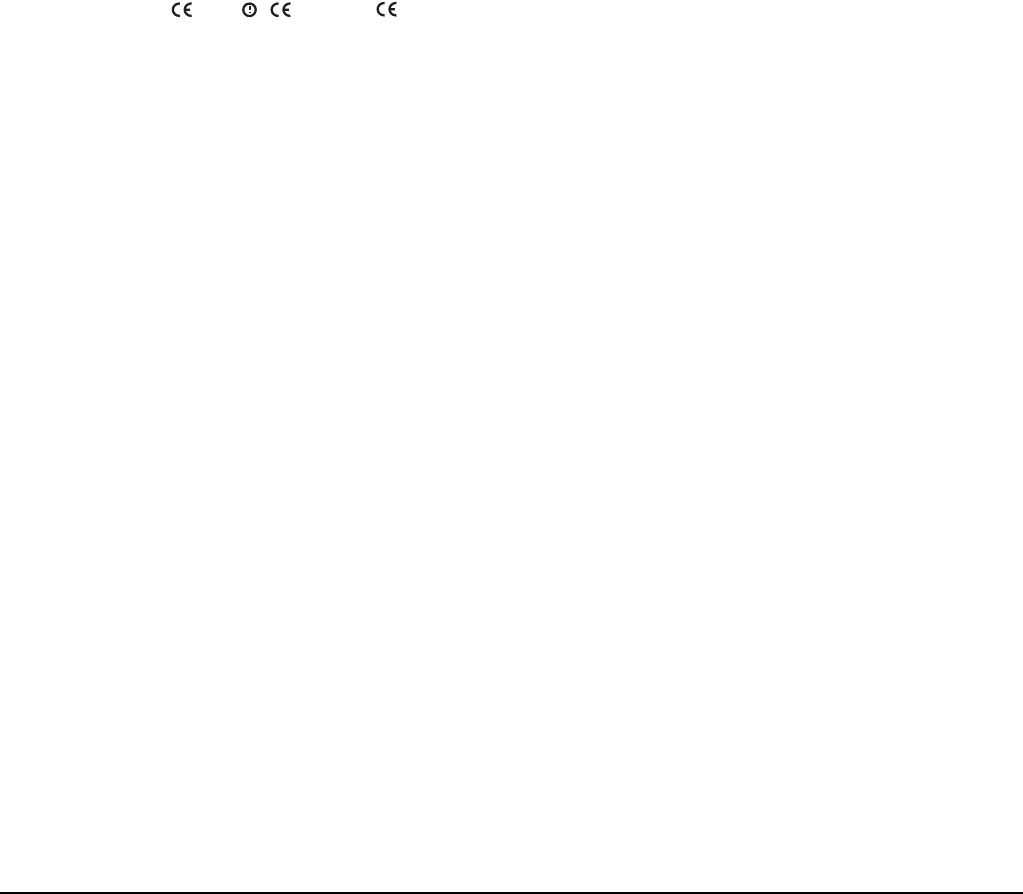
2110 SSB Transceiver compliance
2110 SSB Transceiver Reference Manual 15
European Radio and Telecommunications Terminal
Equipment Directive
The 2110 SSB Transceiver has been tested and complies with the following standards
and requirements (articles of the R&TTE Directive):
• Article 3.1b: ETSI EN 301 489-1
• Article 3.1b: ETSI EN 301 489-15
• Article 3.2: Australian type approval according to AZ/NZS 4770:2003
• Article 3.1a: assessed against ICNIRP requirements
• Article 3.1a: EN 60950
Compliance with these standards is deemed sufficient to fulfil the requirements of the
R&TTE Directive 1999/5/EC.
Product marking and labelling
Any equipment supplied by Codan that satisfies these requirements is identified by the
, , or markings on the model label of the product.
Declaration of Conformity and Expert Letter of Opinion
The CE Declaration of Conformity and Expert Letter of Opinion for this product is listed
on page 11, Associated documents. This document can be made available upon request to
Codan or a Codan-authorised supplier.
Protection of the radio spectrum
CAUTION
Most countries restrict the use of HF radio communications equipment to
certain frequency bands and/or require such equipment to be licensed. It is
the user’s responsibility to check the specific requirements with the
appropriate communications authorities. If necessary, contact Codan for
more information.
0191 0191

2110 SSB Transceiver compliance
16 2110 SSB Transceiver Reference Manual
Electromagnetic compatibility and safety notices
Radiation safety
To ensure optimal transceiver performance and to avoid exposure to excessive
electromagnetic fields, the antenna system must be installed according to the instructions
provided.
Safe working distance is based on continuous exposure to CW type transmissions, as set
out in the ICNIRP Exposure Guidelines 1998 for occupational exposure. Safe working
distance can be reduced with normal voice communication.
Electromagnetic compatibility
To ensure compliance with the EMC Directive is maintained, you must:
1Cover unused connectors with the protective caps supplied to prevent electrostatic
discharge passing through your equipment.
Electrical safety
To ensure compliance with the European Low Voltage Directive is maintained, you must
deploy and use the 2110 SSB Transceiver and antennas in accordance with the
instructions in the 2110 SSB Transceiver Getting Started Guide, the Quick Reference
Cards supplied with each antenna, and the 2110 SSB Transceiver Reference Manual.
When using equipment that is connected directly to the AC mains these precautions must
be followed and checked before apply AC power to the unit:
1Use the standard AC mains cable supplied.
1Ensure the covers for the equipment are fitted correctly.
The 3121 AC Battery Charger is double insulated and marked with .
WARNING High voltages exist on the antenna during transmission and tuning. Do not
touch the antenna during these activities. RF burns may result.
WARNING Install the grounding system or counterpoise as directed to prevent RF
burns from any metal part of the transceiver.
WARNING
You should not transmit from your transceiver or tune the antenna unless
people are beyond the safe working distance of:
• 0.2 m (8 in) from a long wire, end-fed broadband, broadband dipole,
or wire dipole antenna
• 0.6 m (2 ft) from any whip antenna
CAUTION
If it is necessary to remove the covers during service by a qualified
electronics technician, they must be refitted correctly before using the
equipment.
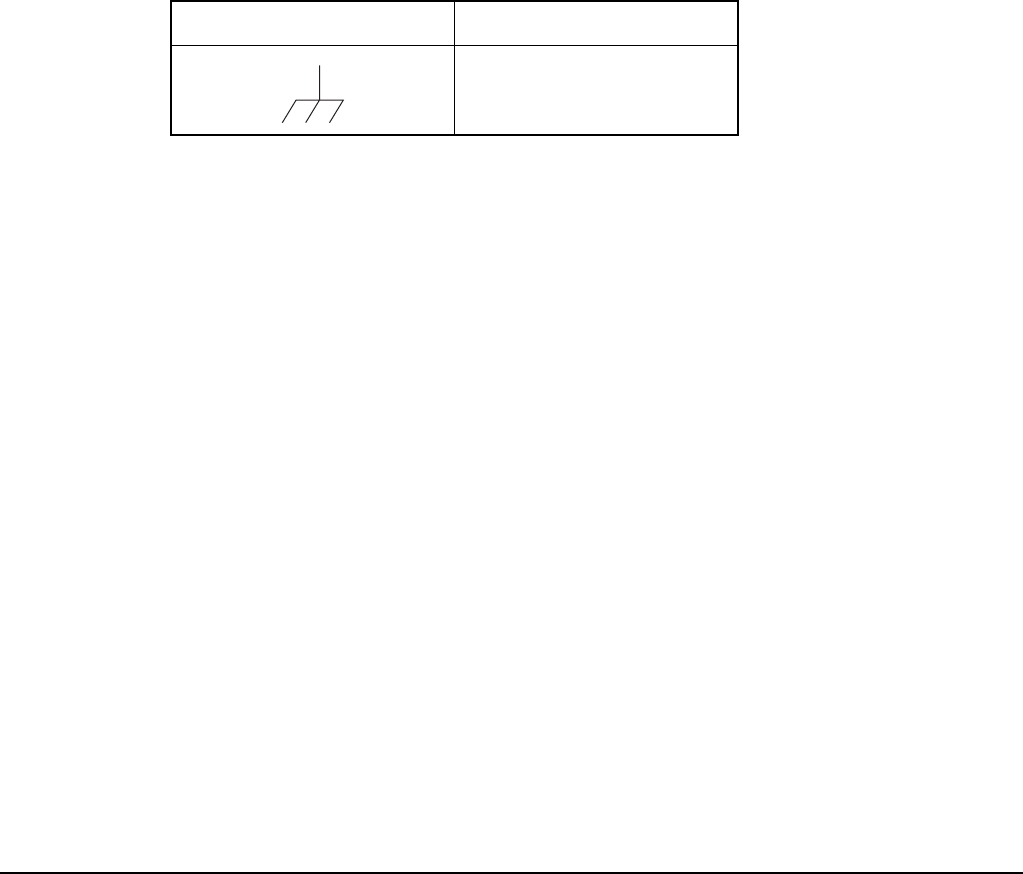
2110 SSB Transceiver compliance
2110 SSB Transceiver Reference Manual 17
Batteries
Battery cells are electrically live at all times and must be treated with extreme caution.
They may supply high short-circuit currents even if they appear to be damaged or
inoperable.
Batteries should be used to provide power to the transceiver only, using the supplied
connectors.
The batteries will not charge at temperatures higher than 40°C.
Earth symbols
An antenna earth connection point is provided on the 2110 SSB Transceiver. The symbol
shown in Table 1 is used to identify the earth on the equipment.
WARNING The protective cover must always be fitted when the 3121 AC
Battery Charger is connected to the AC mains.
Table 1: Earth symbol
Symbol Meaning
Antenna earth

2110 SSB Transceiver compliance
18 2110 SSB Transceiver Reference Manual
C-tick approval
The 2110 SSB Transceiver meets the requirements of the Australian Communications
Authority Radiocommunications (MF and HF Radiotelephone equipment—Land Mobile
Services) Standard 2003 (AS/NZS 4770).

2110 SSB Transceiver compliance
2110 SSB Transceiver Reference Manual 19
Care and safety information
Storage of batteries
Codan recommends that batteries are fully charged prior to storage. The length of time
that they can be stored before recharging is necessary is dependent on the type of battery
and the average storage temperature.
Disposal of batteries
Batteries must be recycled. They should not be burnt or disposed of in landfill.
Immersion of the transceiver in water
The transceiver unit and battery pack are designed to be waterproof to IP68. The units
can withstand immersion in 1 m (3 ft) of water for up to 1 h. Prolonged immersion may
cause damage to the units.
If the units are immersed in water, drain any water from the front panel speaker and
keypad, then wipe and air dry the connectors on the units prior to use or charging the
battery.
If the units are exposed to salt water, they should be washed with fresh water as soon as
possible.
Deploying antennas
Table 2: Battery storage times
Type Storage time @ 20°C (70°F) Storage time @ 30°C (85°F)
NiMh 12 months 6 months
SLA 15 months 10 months
WARNING Do not expose the connector on the battery pack to salt water. This will
damage the connector.
WARNING Do not deploy the antenna at sites with overhead power cables.
WARNING Do not deploy or use any antenna if there is lightning in the area.

2110 SSB Transceiver compliance
20 2110 SSB Transceiver Reference Manual
This page has been left blank intentionally.

HF radio transmission
22 2110 SSB Transceiver Reference Manual
HF radio transmission
The HF band is the range of frequencies between 3 and 30 MHz. HF transceivers usually
cover a frequency range of 1.6 to 30 MHz.
Codan HF transceivers transmit on single sidebands. This reduces the power required to
send HF signals and increases the number of channels available within the HF spectrum.
HF transceivers are primarily used for long-range communication where distances of
3000 km (1800 mi) and more are possible. Obstructions such as buildings and
mountains have little effect on long-range communication. HF radio can cover such large
distances because of the way the transmitted radio signal propagates.
HF radio waves propagate in three ways simultaneously:
• ground wave
• direct wave
• sky wave
Ground wave
The ground wave travels near the ground for short distances, typically up to 100 km
(60 mi) over land and 300 km (190 mi) over sea. The distance covered depends upon the
operating frequency, transmission power and type of terrain.
Direct wave
The direct wave travels in a direct line-of-sight from the transmitter to the receiver.
Sky wave
The sky wave is the most important form of HF propagation. The radio wave is
transmitted toward the sky and is reflected by the ionosphere to a distant receiver on
earth.
The reflective properties of the ionosphere change throughout the day, from season to
season, and yearly.
Figure 1: The reflective properties of the ionosphere
ionosphere
transmitter receiver
emitted
HF wave
reflected
HF wave

HF radio transmission
2110 SSB Transceiver Reference Manual 23
Frequency, distance and time of day
The extent to which a radio wave is reflected depends on the frequency that is used. If
the frequency is too low the signal is absorbed by the ionosphere. If the frequency is too
high the signal passes straight through the ionosphere. Within the HF band, low
frequencies are generally considered to be in the range of 2 to 10 MHz. High frequencies
are above 10 MHz.
A frequency chosen for daytime transmission may not necessarily be suitable for night-
time use. During the day the layers of the ionosphere are thick. The layers absorb lower
frequencies and reflect higher frequencies. At night, the ionosphere becomes very thin.
The low frequencies that were absorbed during the day are reflected and the high
frequencies that were reflected during the day pass straight through.
Summer HF communications usually operate on higher frequencies than those used in
winter over the same distance.
Solar activity varies over an 11 year cycle. Higher frequencies need to be used during
periods of peak activity.
It is important to remember that you may need to change the frequency you are using to
achieve the best communication. The general rules of thumb for HF communication are:
• the higher the sun, the higher the frequency
• the further the distance, the higher the frequency
Channels and modes
A channel is a name that is given to a frequency or a pair of frequencies, for example,
‘Channel 1’, ‘4500’ and ‘Headquarters’. The frequencies may be any frequencies within
the HF range.
Each channel has one or more modes associated with it. Each mode indicates a sideband
that can be used with the channel, such as USB or LSB. When you make a call you need
to specify the channel and the mode you want to use.
Table 3 shows examples of channels and the information associated with them.
Table 3: Examples of channels and modes
Channel Receive frequency
(kHz)
Transmit frequency
(kHz)
Modes
Channel 1 10600 10600 LSB, USB
4500 4500 – AM
Headquarters 22758 23000 USB

HF radio transmission
24 2110 SSB Transceiver Reference Manual
Networks and scanning
A network is two or more stations that use the same frequencies and call system to
communicate.
The frequencies are allocated by a government authority and enable the network to
maintain HF communication throughout the day and night.
The call system is the method the network uses to make and receive calls. For example,
in networks that use the Codan Selcall call system to make calls, the user enters the
address of the station they want to call, then selects the channel/mode on which to make
the call. In networks that use the ALE/CALM call system, the transceiver selects the best
channel/mode for the call.
The transceiver can be set to scan the channel/modes used by your network to detect
incoming calls. It is recommended that when you are not using the transceiver to
communicate you switch scanning on. This ensures that you can receive calls from
stations in your network.
The FED-STD-1045 ALE/CALM option
If you want to use the ALE/CALM call system to automate the selection of channels you
must install the FED-STD-1045 ALE/CALM option in the transceiver. CALM stands for
Codan Automated Link Management.
The FED-STD-1045 ALE/CALM option enables the transceiver to test the signal
propagation qualities of your channels using soundings, and build a profile of each
channel’s suitability for use at different times of the day and night. The BER and SINAD
information collected during sounding activity is stored in the transceiver using a
24-hour period LQA database. With this information, the transceiver is able to select the
most suitable channel/mode for you when you make a call.
You are able to make ALE ALL calls with this option.
CALM is interoperable with FED-STD-1045 ALE.
The MIL-STD-188-141B ALE option
The MIL-STD-188-141B ALE option includes the FED-STD-1045 ALE/CALM option.
It also provides the capability to make ALE calls using ALL, ANY, Group Selective,
NET, and Wildcard address syntaxes. These calls connect one station to many stations at
the same time. The MIL-STD-188-141B ALE option also provides advanced link quality
analysis, advanced messaging, and access to a Heard List.
The MIL-STD-188-141B ALE option is interoperable with FED-STD-1045 ALE and
MIL-STD-188-141B.

HF radio transmission
2110 SSB Transceiver Reference Manual 25
Etiquette for the use of HF radio
There is a standard procedure for communicating over HF radio. Before you begin
transmitting, switch off scanning, select a channel, then press PTT to initiate tuning of
the antenna. Listen to the channel that you are going to use and ensure that there is no
voice or data communication taking place. You may need to wait until the channel is
clear or select another channel.
When you first establish communication with another station it is customary to state their
call sign and then your own using the phonetic alphabet (see Table 4 on page 26). For
example:
‘Alpha Bravo One, this is Alpha Bravo Two. Do you receive me? Over.’
In this example your call sign is AB2 and you are calling a station with the call sign
AB1. A call sign is a group of letters and numbers issued by a government authority to
identify a station. The phonetic alphabet is used to ensure that your call sign is
understood.
The word ‘over’ is used to signify the end of your transmission. The transceiver may be
set up to transmit a short beep when you release the PTT button on the handset. When
your conversation with the other party is finished, the party that speaks last should say
‘out’.
Swearing or foul language should not be used—heavy penalties can apply.
Keep communication as short as possible.
NOTE
If you have the Cfg LBT Mode set to Enabled or Override allowed, the
transceiver searches for a channel that is not being used; you do not need
to check any channels first.

HF radio transmission
26 2110 SSB Transceiver Reference Manual
Table 4: The phonetic alphabet
Letter Word Letter Word
A Alpha N November
B Bravo O Oscar
C Charlie P Papa
D Delta Q Quebec
EEchoRRomeo
F Foxtrot S Sierra
G Golf T Tango
H Hotel U Uniform
I India V Victor
J Juliet W Whiskey
K Kilo X X-ray
L Lima Y Yankee
M Mike Z Zulu
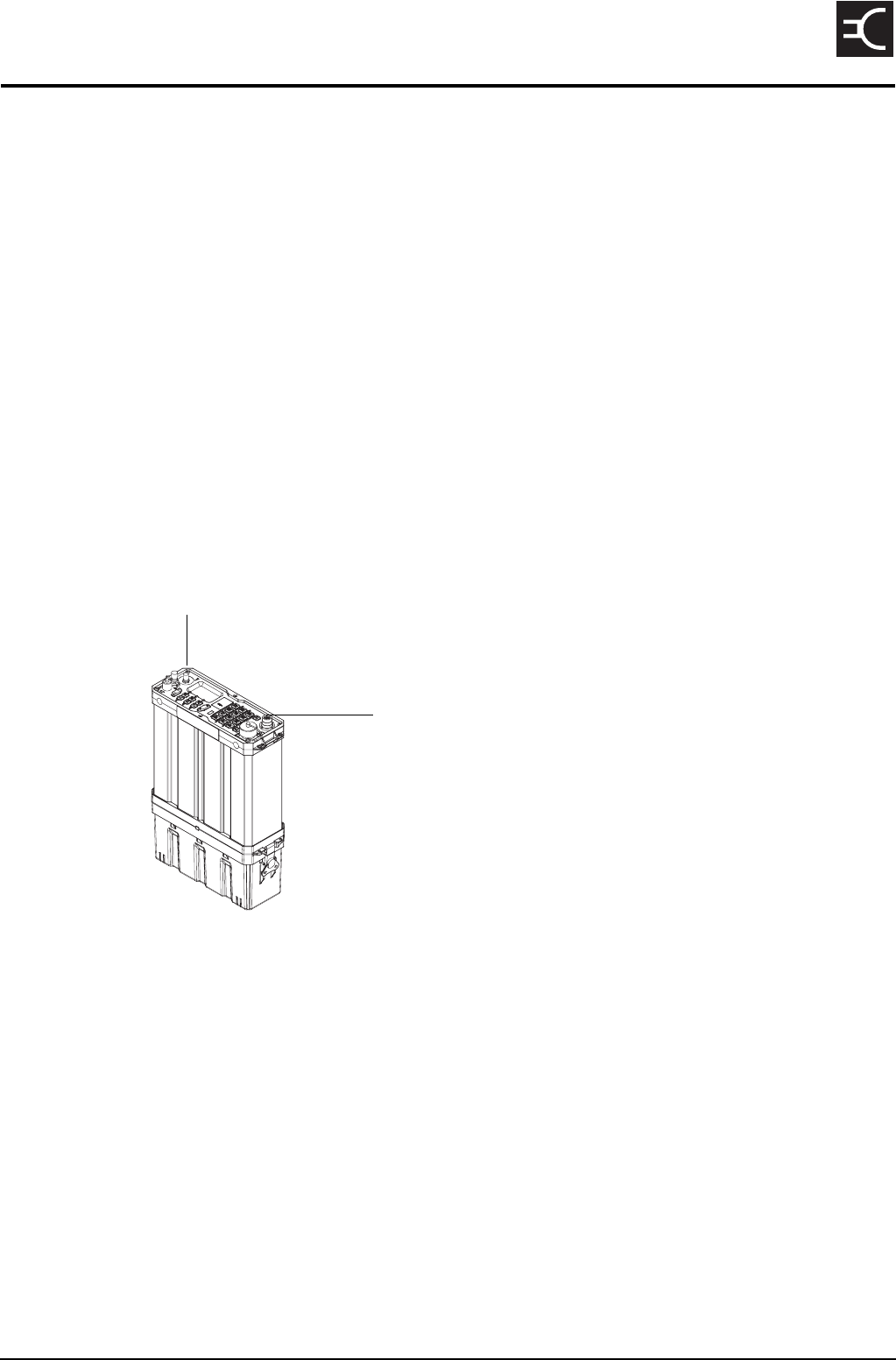
2110 SSB Transceiver Reference Manual 27
CODAN
4 The 2110 SSB Transceiver
The 2110 SSB Transceiver consists of a:
• handset
• 2110 transceiver unit
• battery pack
• antenna and earthing equipment
The handset is a hand-held device that has a microphone, and PTT button. The
microphone and PTT button are used for voice communication.
The transceiver unit modulates audio signals onto radio frequencies that can be
transmitted on air, and demodulates the radio frequencies it receives into audio signals.
The keypad on the front panel of the transceiver unit enables you to control and
configure the 2110 SSB Transceiver. The handset connects to the front panel.
Figure 2: The 2110 SSB Transceiver
to handset
to antenna
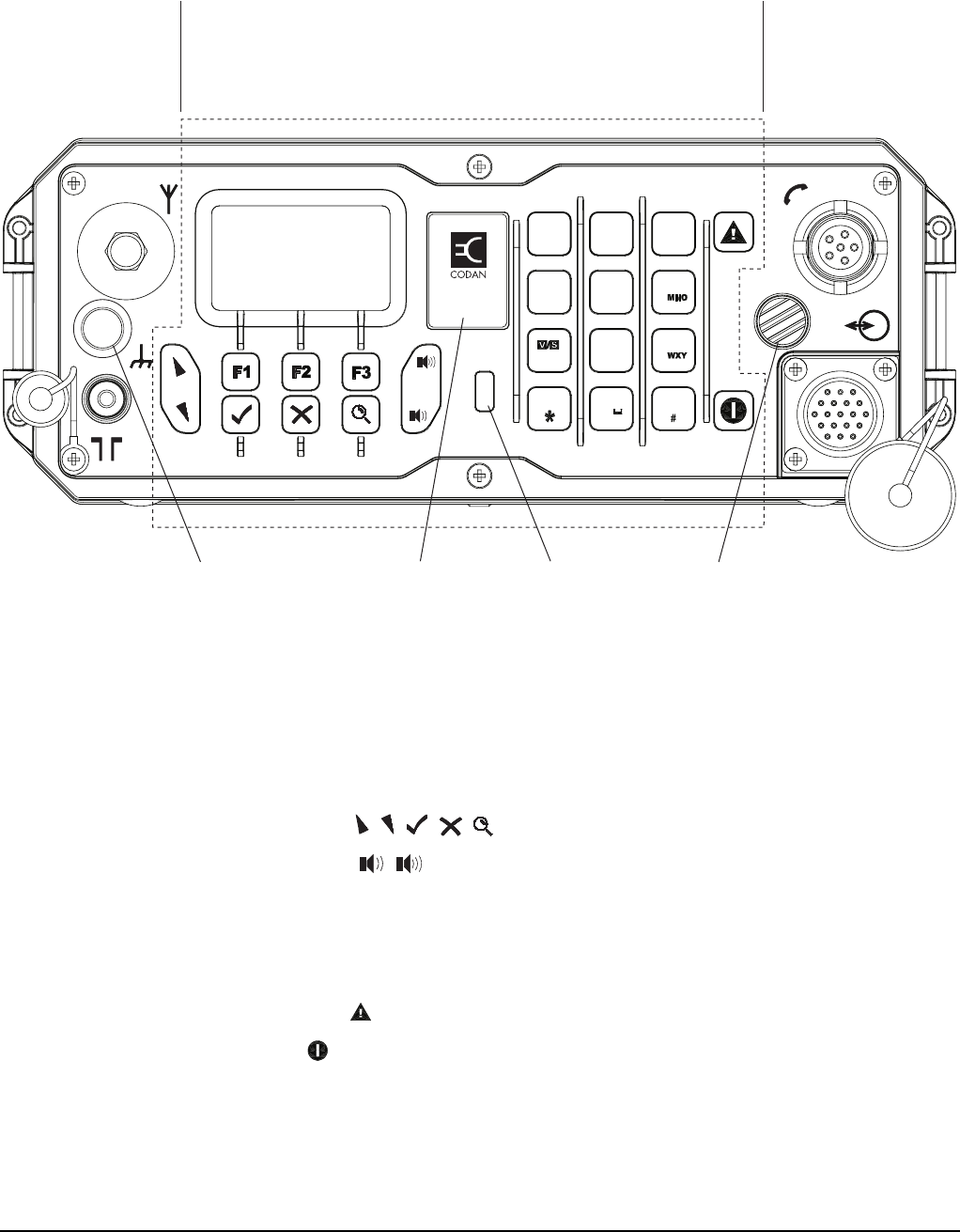
The 2110 SSB Transceiver
28 2110 SSB Transceiver Reference Manual
The front panel
Figure 3: The front panel
User controls
The user control area comprises:
• an LCD
• navigation keys ( , , , , )
• volume controls ( , )
• soft function keys (F1, F2, F3) corresponding to the function displayed on the front
panel screen
• alphanumeric keys (0–9, *, #)
• emergency key ( )
• power key ( )
There are two ways to use the keys on the front panel. You can:
• press a key, briefly
•hold a key for 2 seconds
interface
connectorsuser controlsantennas
infrared
window
location of
internal
GPS
antenna
internal
speaker
earth
terminal
VIEW
0
1QZ
TUNE
2ABC
CLAR MODE
DEF
3
Rx
FREE
4GHI
5
JKL
Tx
PWR
6
7PRS 8TUV
SEC GPS
9
CALL
LOGS
EASI
TALK
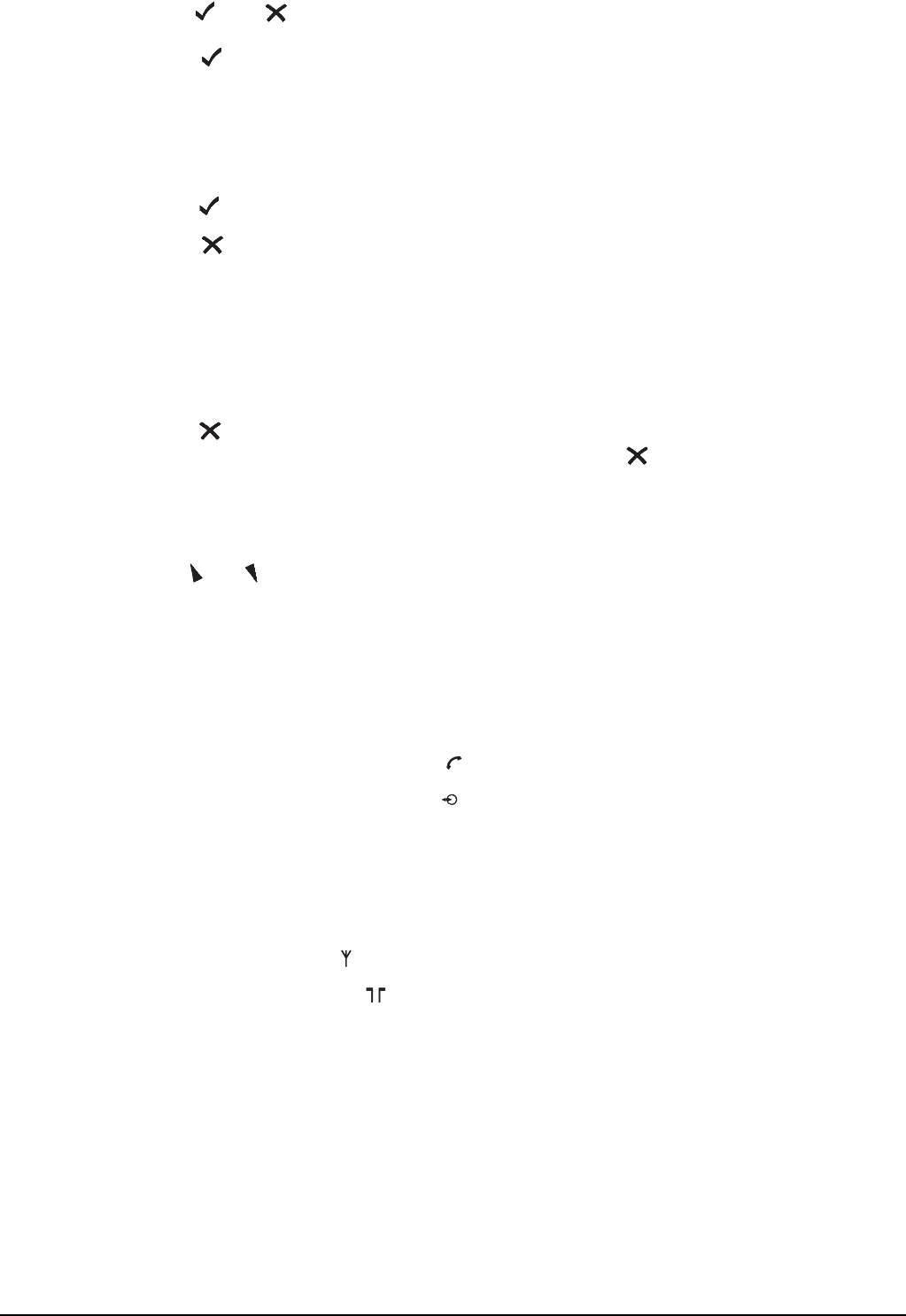
The 2110 SSB Transceiver
2110 SSB Transceiver Reference Manual 29
The and keys
Press to:
• select the item on the active line in the list
• save changes
• answer ‘yes’ to prompts
Hold to edit settings.
Press to:
• backspace over text
• remove messages on the screen
• cancel changes
• answer ‘no’ to prompts
Hold to go from any location to the home screen. If you have entered text into a
setting and want to discard the changes you made, hold .
The scroll keys
The and keys are the scroll keys. Use these keys to scroll up or down through any
kind of list, to scroll left or right over text, and to increase or decrease a value.
Interface connectors
The interface connector area comprises:
• the 6-way handset connector ( )
• the 19-way GPIO connector ( )
Antennas
The antenna area comprises:
• the antenna stud ( ) for whip antennas and the long wire antenna adaptor
• the 50 Ω connector ( ) for broadband and dipole antennas

The 2110 SSB Transceiver
30 2110 SSB Transceiver Reference Manual
Hot keys
Hot keys enable you to perform a task quickly. The transceiver comes with some
standard hot keys programmed; the keys are labelled with the corresponding task
performed.
Table 5: Standard hot keys
Hot key Function
F1 Pressing F1 performs the macro assigned to this soft function key. By
default, MUTE is assigned to this key, so pressing F1 toggles mute on
or off.
F2 Pressing F2 performs the macro assigned to this soft function key. By
default, CALL is assigned to this key, so pressing F2 starts a call.
F3 Pressing F3 performs the macro assigned to this soft function key. By
default, SCAN is assigned to this key, so pressing F3 switches off
scanning, or if you were in a call, ends the call and switches scanning
on.
Hold MUTE Holding MUTE toggles the front panel speaker on or off.
TUNE Pressing TUNE displays the PTT tunes screen so you can manually
tune the antenna. For more information see page 77, Manual tuning.
CLAR Pressing CLAR enables you to adjust the receive frequency to
compensate for any frequency offset between your transceiver and the
remote transceiver. For more information see page 78, Using the
clarifier.
MODE Pressing MODE selects the next allowable mode programmed for the
channel, usually USB or LSB.
FREE Rx Pressing FREE Rx enters Free Tune mode in which you can adjust or
enter a receive frequency. For more information see page 232, Using
the transceiver in free tune.
Tx PWR Pressing Tx PWR toggles the transmission power of the transceiver
between Hi (25 W) and Lo (5 W).
V/S Pressing V/S toggles the mute type between Voice mute and Selcall
mute. For more information see page 61, Muting the transceiver.
SEC Pressing or holding SEC enters Secure mode, if the hardware option
is fitted, and special firmware is programmed into the transceiver and
enabled. For more information see page 80, Using the voice
encryptor.
GPS Pressing GPS displays your current GPS position, if the hardware
option is fitted and enabled. For more information see page 222, GPS
Screen entry.
EASITALK Pressing EASITALK toggles the DSP noise reduction algorithm on
or off. For more information see page 79, Reducing background noise
with Easitalk.
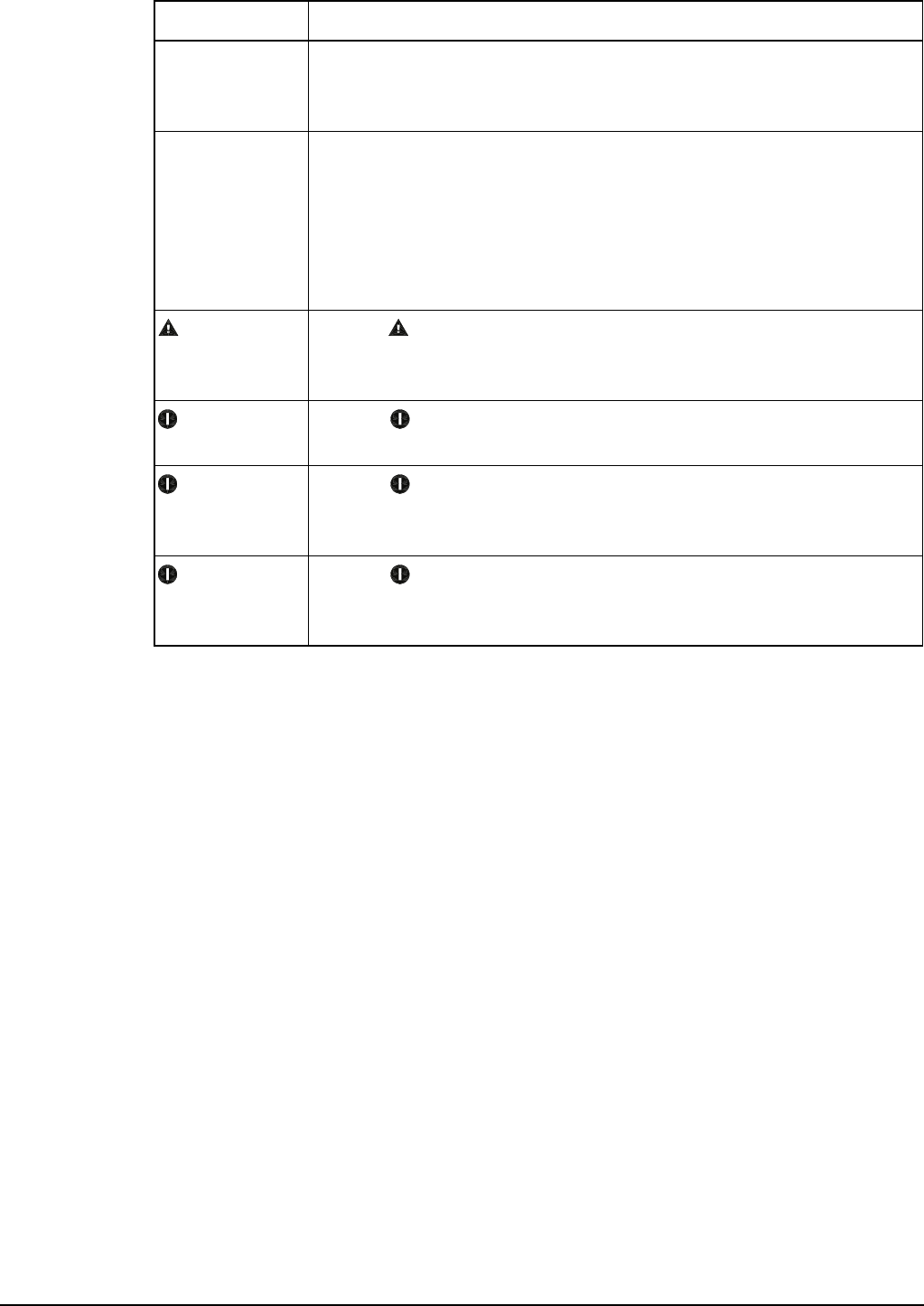
The 2110 SSB Transceiver
2110 SSB Transceiver Reference Manual 31
VIEW Pressing VIEW toggles between the channel screen and the Address
List. If you are in any other list, pressing VIEW displays the channel
screen.
CALL LOGS Pressing CALL LOGS repeatedly steps through a number of call
logs: Calls Out, Calls In, Last Heard, then back to the screen from
which you began. In these logs, you can view the details of the calls
or detected stations.
The Last Heard log is only available if you have the MIL-STD-188-
141B ALE option installed.
(Emergency) Holding starts an automatic Emergency call transmission using
call information contained in the Emergency entries in the Address
List (see page 152, Making several different types of calls).
(Power) Pressing cycles the screen and keypad backlighting through the
brightness settings.
+ 9 Pressing + 9 enables you to change the default setting for the
screen contrast. For more information see page 74, Changing the
screen contrast.
+ 0 Pressing + 0 enables you to change the default setting for the
screen and keypad backlighting. For more information see page 74,
Changing the screen brightness.
Table 5: Standard hot keys (cont.)
Hot key Function
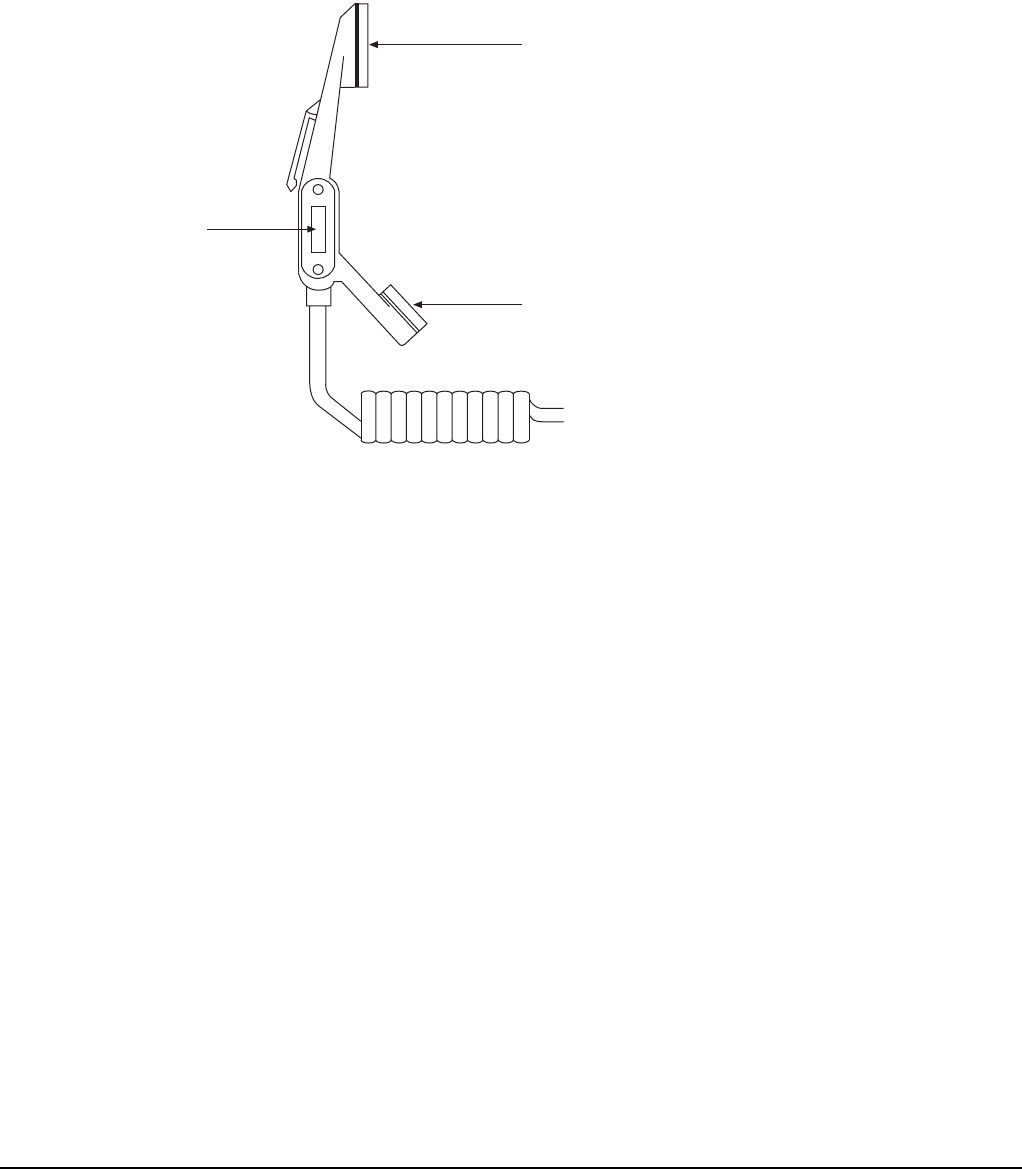
The 2110 SSB Transceiver
32 2110 SSB Transceiver Reference Manual
Handset
The 2110 SSB Transceiver supports standard audio accessories using H-229 type
connectors. The handset is a standard issue, lightweight, tactical H-250/U type, with
built-in earphone, noise-cancelling microphone, and PTT button. It is connected to the
6-way connector on the front panel of the transceiver.
Figure 4: The handset
earphone
microphone
PTT

2110 SSB Transceiver Reference Manual 33
CODAN
5 Preparing the 2110 SSB Transceiver for use
This section contains the following topics:
Charging a battery (34)
Connecting a battery to the transceiver (36)
Inserting the transceiver into a backpack (36)
Selecting an appropriate antenna (37)
Troubleshooting the transceiver (41)
Testing the installation (42)
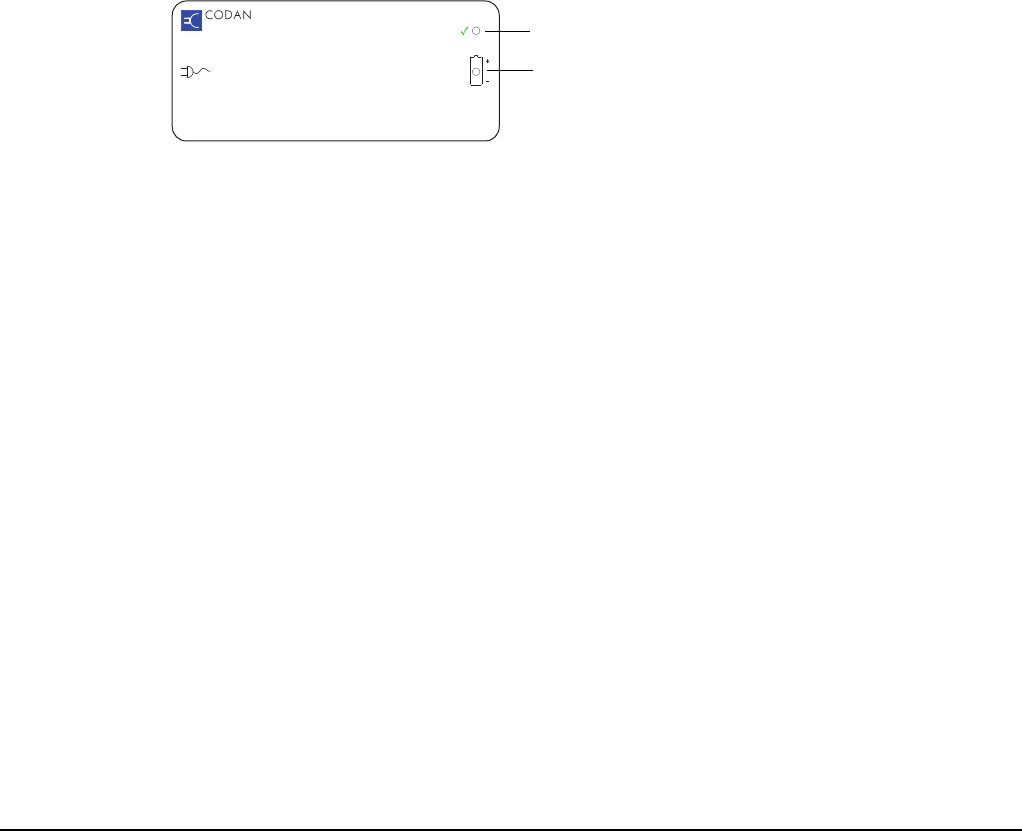
Preparing the 2110 SSB Transceiver for use
34 2110 SSB Transceiver Reference Manual
Charging a battery
Before using your transceiver, you must ensure that the supplied battery is fully charged.
You may use an AC–DC or DC–DC charger with the battery. The AC–DC charger (Type
3121) uses a universal AC mains input of 90–264 V AC. The DC–DC battery charger
(Type 3122) may be powered from any 12–60 V DC source, for example, from a vehicle
12 V DC outlet, or from a 24 V vehicle battery.
The Codan battery chargers are specially designed for low-noise operation, so receiver
performance remains optimal while charging the battery via the front panel. You can
continue to use your transceiver during battery charging.
Figure 5: Typical front panel of a battery charger
To charge a battery:
1Do one of the following:
• If the battery is attached to the transceiver, use cable 08-06215-001 to connect
the output of the charger to the 19-way connector on the front panel of the
transceiver.
• If the battery is detached from the transceiver, use cable 08-06214-001 to
connect the output of the charger to the 6-way connector on the top of the
battery pack.
1Connect the charger to an appropriate power source.
CAUTION
Charging is recommended between 0 and 40°C. The battery will not
commence charging if the temperature is at or above 40°C. If charging is
already in progress, and the temperature rises to 50°C, charging will be
stopped automatically.
CAUTION To prevent damage to the battery, Codan recommends the use of the
Codan battery chargers to charge the battery pack.
WARNING
The battery pack should be charged with the connector facing upward and
the vents clear of obstructions so that any gas created during the charging
process is released.
CAUTION Provide clear notification that charging is underway. Ensure there is
adequate ventilation around the battery during charging.
NOTE It will take approximately 16 seconds for charging to start.
3121 AC Battery Charger
INPUT OUTPUT
power on
(green)
charging
(orange, off when
charging complete)

Preparing the 2110 SSB Transceiver for use
2110 SSB Transceiver Reference Manual 35
If the transceiver is operational during charging, the battery status indicator on the
front panel screen will show that the battery is charging. When charging is complete,
the battery status indicator will be full.
Requirements for alternative chargers
The Codan battery packs may be charged using alternative supplies, for example, solar
panels or hand-crank generators. In this situation, the voltage level must not exceed
15.5 V and the current must be within 1–3 A. These chargers must be connected between
pin B (charge in) and pin A (ground) on the connector on the battery pack.
Notes on charging batteries
A battery will require 3–5 discharge/recharge cycles when new before it will reach its
full capacity. In order to increase the battery service life, it is recommended that the
battery is not fully discharged during each cycle. Full discharge should only be carried
out periodically as follows:
For the periodic full discharge cycle, run the battery down to zero capacity using the
transceiver. The transceiver will switch off automatically when the battery is fully
discharged.
The Codan battery packs have in-built monitoring, which is reported in the Battery entry
in the Control List. You should view the Battery Cycle setting for the number of times
the battery has received input current (that is, has been charged).
Type Full discharge
NiMh Two full discharge/recharge cycles every 20 charge cycles
SLA One full discharge/recharge cycle every 20 charge cycles
WARNING If you are using alternative means to discharge the battery, the battery
voltage must not go below 10 V.
WARNING An SLA battery must be charged immediately after discharge to prevent
damage to the battery.
NOTE You will need to log in as administrator to see the Control List (see
page 110, Logging into admin level from user level).

Preparing the 2110 SSB Transceiver for use
36 2110 SSB Transceiver Reference Manual
Connecting a battery to the transceiver
The battery is connected to the bottom of the transceiver. It is held in place by clips with
locking key latches (see Figure 6).
Figure 6: Transceiver with battery pack connected
Inserting the transceiver into a backpack
All backpacks come with adjustable straps that hold the transceiver firmly in position.
Some backpacks have an internal mounting frame.
To insert the transceiver into a backpack with an internal mounting frame:
1Open the rear of the backpack to expose the mounting frame.
1Push the transceiver between the foam mounts on the frame.
1Secure the transceiver with the two adjustable straps.
1Close the rear of the backpack.
To insert the transceiver into the soft backpack:
1Slide the transceiver into the backpack.
1Secure the transceiver with the adjustable strap on the outside of the backpack.
NOTE The battery connector on the base of the transceiver is on the same side of
the transceiver as the antenna connectors on the front panel.
key
clip
transceiver
battery pack
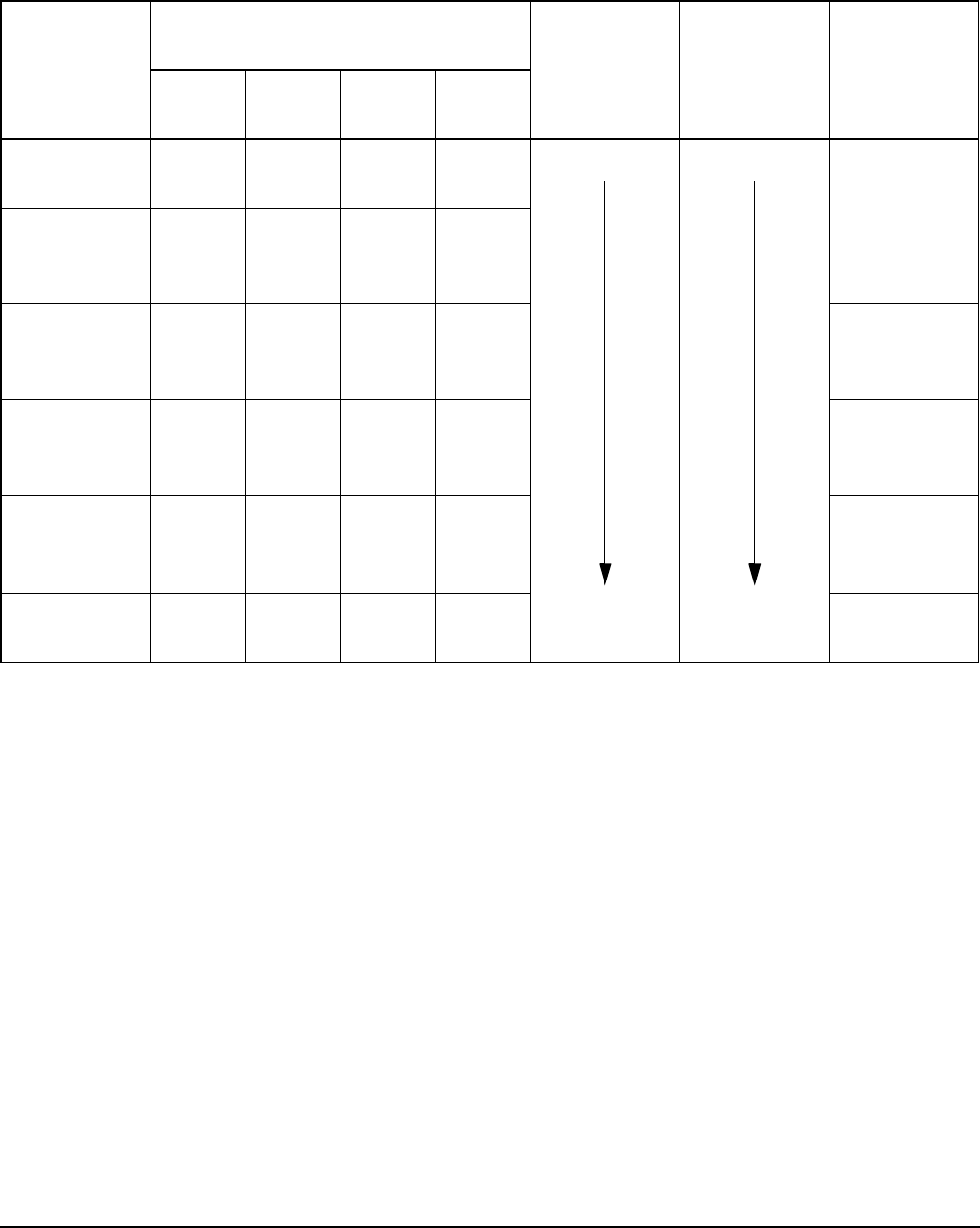
Preparing the 2110 SSB Transceiver for use
2110 SSB Transceiver Reference Manual 37
Selecting an appropriate antenna
Use the following table as a guide to selecting an antenna that is appropriate for your
communication requirements.
Whip antennas
There are three whip antennas available for use with the 2110 SSB Transceiver:
•tape whip
• knock-down whip
• 3 m (10 ft) collapsible whip
All whip antennas are omnidirectional in performance, therefore providing radiation
efficiency equally in all directions depending on the deployment position (for example,
vertical position for long distances and horizontal position for short distances). When
receiving, this omnidirectional performance may mean more unwanted signals are
picked up, which contributes to high levels of background noise or interference.
Table 6: Selection guide for antennas
Antenna Communication distance
(km)
Effort to
install
Antenna
performance
See...
0–100 100–500 up to
2000
up to
5000
Tape/Knock-
down whip
!Minimum Adequate page 37, Whip
antennas
3m (10ft)
collapsible
whip
!!
Long wire and
adaptor
!!! page 38, Long
wire antenna
and adaptor
End-fed
broadband
!!! page 39, End-
fed broadband
antenna
Broadband
dipole
!!!! page 39,
Broadband
dipole antenna
Wire dipole !!!!
Maximum Superior page 40, Wire
dipole antenna
NOTE For specific information on the deployment of an antenna see the Quick
Reference Card provided with the antenna.

Preparing the 2110 SSB Transceiver for use
38 2110 SSB Transceiver Reference Manual
The whip antennas are suitable for multifrequency operation. The built-in antenna tuner
automatically tunes the antenna on the first time a transmission occurs after selecting a
new channel. This occurs when your transceiver receives a call, or when you press PTT.
Alternatively, the antenna can be tuned to a frequency by pressing TUNE, then PTT. The
SWR of the antenna may be viewed by pressing TUNE. The whip antennas are suitable
for scanning ALE/CALM and Codan Selcall networks.
The whip antennas are designed for deployment on the antenna stud on the front panel of
the 2110 SSB Transceiver. The tape and knock-down whip antennas are suitable for
walking and listening for communication over short distances up to 100 km (60 mi),
using frequencies of 3–30 MHz. The 3 m (10 ft) collapsible whip antenna is suitable for
communication over short to medium distances up to 500 km (300 mi), using
frequencies of 2–30 MHz. Due to its length and rigidity, the collapsible whip antenna is
not suitable for walking and listening.
Long wire antenna and adaptor
The long wire antenna is suitable for multifrequency operation with the built-in antenna
tuner of the 2110 SSB Transceiver. It is approximately 10 m (11 yd) in length. The long
wire antenna is suitable for scanning ALE/CALM and Codan Selcall networks.
The long wire antenna and adaptor is designed for deployment on the antenna stud on the
front panel of the 2110 SSB Transceiver with the use of one support structure. The long
wire antenna is suitable for communication over short to long distances up to 5000 km
(3000 mi), using frequencies of 1.6–30 MHz. It is restricted to a fixed site for
transmission and reception.
Table 7: Advantages and limitations of a vertical whip antenna
Advantages Limitations
Quick and easy to deploy.
Tape and knock-down whips are suitable
for monitoring communications while
moving due to their flexibility and knock-
down properties.
Omnidirectional antenna, therefore it can
pick up signals equally in all directions.
Suitable for short-distance
communications.
Suitable for scanning applications.
Multifrequency operation.
Tape and knock-down whips unsuitable for
distances over 100 km (60 mi).
3 m (10 ft) collapsible whip unsuitable for
distances over 500 km (300 mi).
3 m (10 ft) collapsible whip unsuitable for
monitoring communications while
moving.
This antenna is more susceptible to noise
pickup such as that produced by welders,
electric motors, power lines etc. If used in
a noisy environment, degradation of the
received signal will occur.

Preparing the 2110 SSB Transceiver for use
2110 SSB Transceiver Reference Manual 39
End-fed broadband antenna
The end-fed broadband antenna is a multifrequency antenna that does not require tuning.
It is suitable for scanning ALE/CALM and Codan Selcall networks.
The end-fed broadband antenna is designed for deployment on the connector on the
front panel of the 2110 SSB Transceiver with the use of one support structure. The end-
fed broadband antenna is suitable for communication over short to long distances up to
5000 km (3000 mi), using frequencies of 2–30 MHz. It is restricted to a fixed site for
transmission and reception.
Broadband dipole antenna
The broadband dipole antenna is a multifrequency antenna that does not require tuning.
It is suitable for scanning ALE/CALM and Codan Selcall networks.
The broadband dipole antenna is designed for deployment on the connector on the
front panel of the 2110 SSB Transceiver with the use of at least one support structure.
The broadband dipole antenna is suitable for communication over short to long distances
up to 5000 km (3000 mi), using frequencies of 3–30 MHz. It is restricted to a fixed site
for transmission and reception.
Table 8: Advantages and limitations of a long wire antenna and adaptor
Advantages Limitations
Quick and easy to deploy.
Large in size therefore, is more efficient
than the whip antennas.
Suitable for scanning applications.
Multifrequency operation.
Requires a support structure and
appropriate space, oriented correctly for
the required direction of communication.
The length of the wire may need to be
varied to tune on all frequencies.
Table 9: Advantages and limitations of a end-fed broadband antenna
Advantages Limitations
Quick and easy to deploy.
Suitable for scanning applications.
Multifrequency operation.
Requires a support structure and
appropriate space, oriented correctly for
the required direction of communication.
Due to its broadband properties, it has a
low immunity to noise.
May be inefficient on some frequencies.

Preparing the 2110 SSB Transceiver for use
40 2110 SSB Transceiver Reference Manual
Wire dipole antenna
The wire dipole antenna is a single frequency antenna that is deployed to a particular
length corresponding to its operational frequency. It cannot be used in scanning
applications.
The wire dipole antenna is designed for deployment on the connector on the front
panel of the 2110 SSB Transceiver with three support structures. The wire dipole
antenna is suitable for communication over short to long distances up to 5000 km
(3000 mi), using frequencies of 3–30 MHz. It is restricted to a fixed site for transmission
and reception.
Table 10: Advantages and limitations of a broadband dipole antenna
Advantages Limitations
Suitable for scanning applications.
Multifrequency operation.
Generally, more efficient than the end-fed
broadband antenna.
Requires at least one support structure and
appropriate space, oriented correctly for
the required direction of communication.
Table 11: Advantages and limitations of a wire dipole antenna
Advantages Limitations
Good signal quality.
Suitable for medium to long-distance
communications.
Requires at least three support structures
and appropriate space, oriented correctly
for the required direction of
communication.
Single frequency operation, therefore not
suitable for scanning applications.
Length of antenna is specific to the desired
frequency of operation.
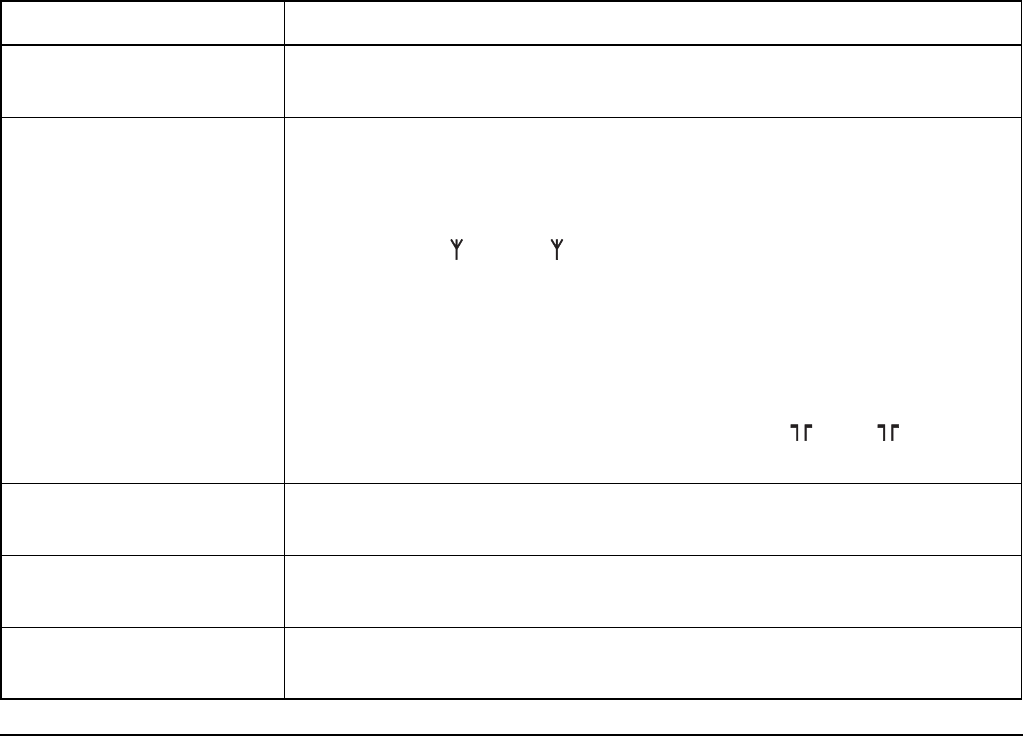
Preparing the 2110 SSB Transceiver for use
2110 SSB Transceiver Reference Manual 41
Troubleshooting the transceiver
Below is a checklist for basic troubleshooting.
Check that:
• all connectors are dry and free of dirt
• all connections are sound
• the battery is connected to the transceiver and has some charge
• the selected antenna is appropriate for the distance over which you want to
communicate
• the antenna is deployed correctly, oriented in a suitable direction, and connected to
the transceiver
• the grounding system is adequate as per instructions provided with the antenna
• the antenna selection icon on the front panel screen matches the type of antenna you
are using
If required, restart your transceiver to invoke self-testing. The self-test checks the
memory, hardware, LCD and keys.
If a serious fault is reported, contact your Codan representative.
Table 12 contains some general tips for troubleshooting your transceiver.
Table 12: General troubleshooting
Problem Solution
The sound from the front
panel speaker is muffled
Drain any moisture from the front panel of the transceiver by turning it
upside down.
Communications are not
clear
Try another channel.
Press PTT.
If you are using a whip or long wire antenna, check that the antenna
selection icon is ATU or ATU/50 (see Figure 9 on page 48).
If you are communicating over a short distance, try laying the whip
horizontally for near vertical incident skywave operation.
Change to a long wire antenna.
If communications are still not clear, change to a dipole or broadband
antenna and check that the antenna selection icon is 50 or ATU/50
(see Figure 9 on page 48).
There are no supports for a
wire antenna available
Lay the antenna wire on the ground. Lay the counterpoise in the opposite
direction.
I get a burn from the handset
when I press PTT
The transceiver is not adequately earthed. Attach a counterpoise as per the
instructions provided with the antenna.
GPS is not working Ensure that the front panel of the transceiver, and hence the GPS antenna, is
facing the sky so that it can receive signals from satellites.

Preparing the 2110 SSB Transceiver for use
42 2110 SSB Transceiver Reference Manual
Testing the installation
Following correct deployment, the station should be tested for correct operation prior to
use in the HF network.
Testing involves:
• measuring the SWR
• carrying out station-to-station on-air testing
Voltage standing wave ratio
The 2110 SSB Transceiver measures the forward and reflected powers between the
transceiver and its antenna load. To ensure correct installation, the power and SWR
assessment should be performed with the transceiver working in its normal antenna
system. Press TUNE to see the SWR, then press PTT to manually tune the antenna.
If the impedance of the antenna is equal to 50 Ω, there will be no power reflected. This is
the ideal situation, which gives an SWR reading of 1:1. An SWR equal to or lower than
2.5:1 is acceptable. If the SWR is greater than 3:1, the ALC circuitry in the transceiver
will reduce the output power. With some combinations of frequencies and antenna
design, it may not be possible to achieve the desired value on all channels.
Using SWR to test the transceiver
To test the transceiver:
1Select the channel with the highest operating frequency of the transceiver.
1Press TUNE.
1Press PTT to tune the transceiver.
If the antenna length and ground parameters are within satisfactory operating range,
tuning will be successful and the SWR reading will be less than 2:1.
1Select the channel with the lowest operating frequency of the transceiver and repeat
the test.
1If a particular channel frequency does not tune, check the:
• length of the antenna (for long wire antennas)
• effectiveness of the grounding system
• orientation of the antenna
Alter these slightly in an attempt to achieve better tuning.

Preparing the 2110 SSB Transceiver for use
2110 SSB Transceiver Reference Manual 43
On-air testing
On-air testing gives a better indication of antenna operation, particularly if the operator is
familiar with the signal strengths normally received within a network. Certain types of
test calls can be used to test the transceiver.
With on-air testing, the difference in equipment between stations must be taken into
account when determining the quality of the transmission.

Preparing the 2110 SSB Transceiver for use
44 2110 SSB Transceiver Reference Manual
This page has been left blank intentionally.

2110 SSB Transceiver Reference Manual 45
CODAN
6 Operating the transceiver
This section contains the following topics:
Switching on the transceiver (46)
The front panel screen (47)
The channel screen (48)
Entering and editing text (52)
Quick Start (57)
Muting the transceiver (61)
Scanning channels (62)
Using the microphone (63)
Finding words and values (64)
Setting the basics (67)
Using hot keys (75)
Tuning the antenna (76)
Using the clarifier (78)
Reducing background noise with Easitalk (79)
Using the voice encryptor (80)
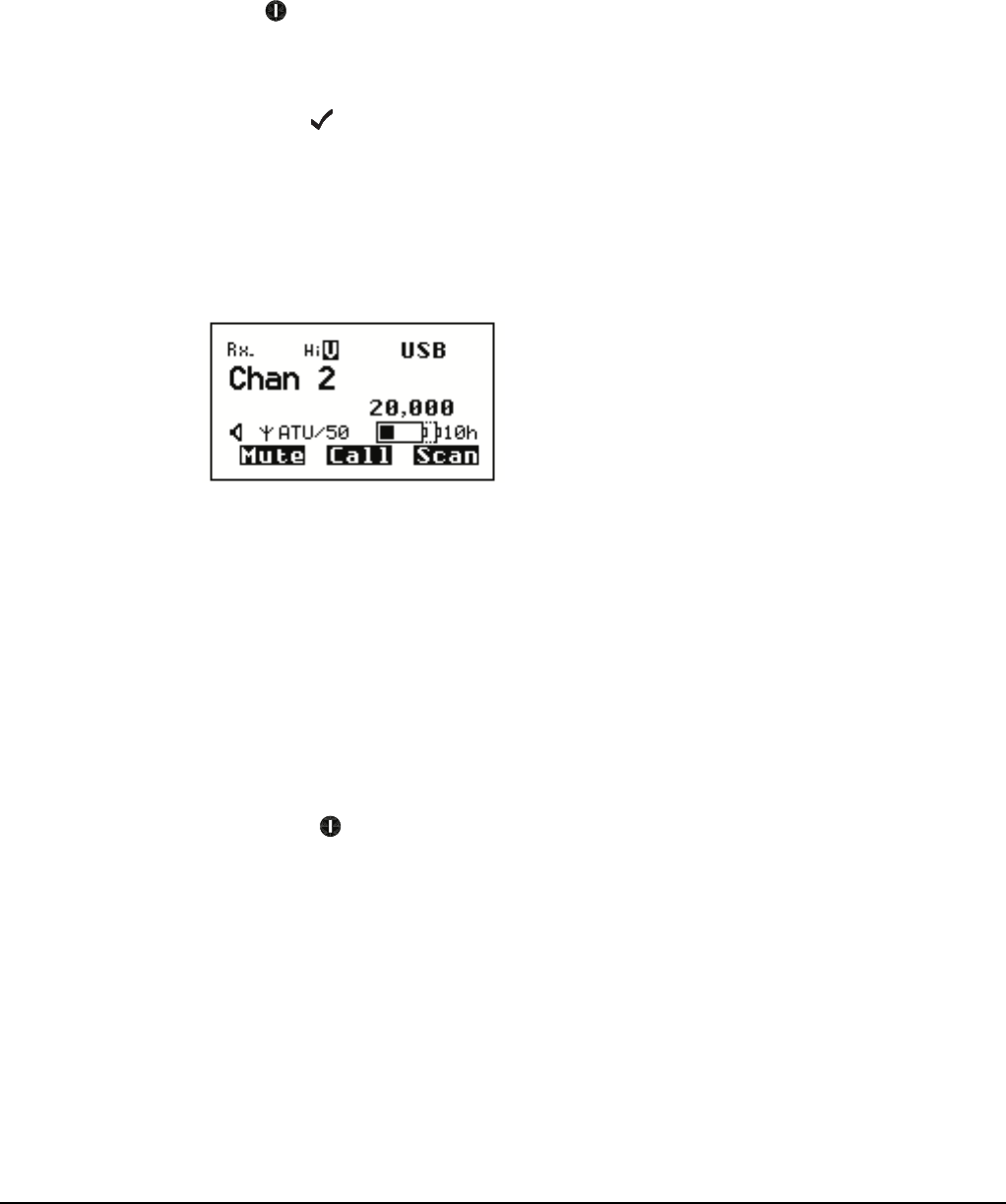
Operating the transceiver
46 2110 SSB Transceiver Reference Manual
Switching on the transceiver
To switch on the transceiver:
1Press .
The Codan logo screen is displayed.
1If you are prompted to enter a password, enter your user or administrator password,
then press .
If you enter an incorrect password it is automatically erased. If you enter an
incorrect password three times, the transceiver automatically switches off. If you
have forgotten your password see page 337, Forgotten passwords.
The welcome screen (if set) is briefly displayed, then the home screen is displayed.
For example:
The default home screen is the channel screen in the Channel List. If another screen
has been set as the home screen, it is displayed instead. For more information on the
home screen see page 95, Setting the home screen.
Switching off the transceiver
To switch off the transceiver:
1Hold down for 2 seconds, then release.
The transceiver is switched off.
NOTE
Prior to operational use, you should connect an antenna to the transceiver
(see page 37, Selecting an appropriate antenna, and the Quick Reference
Card supplied with the antenna).
NOTE If there are no channels programmed into the transceiver, Free Tune is
displayed.
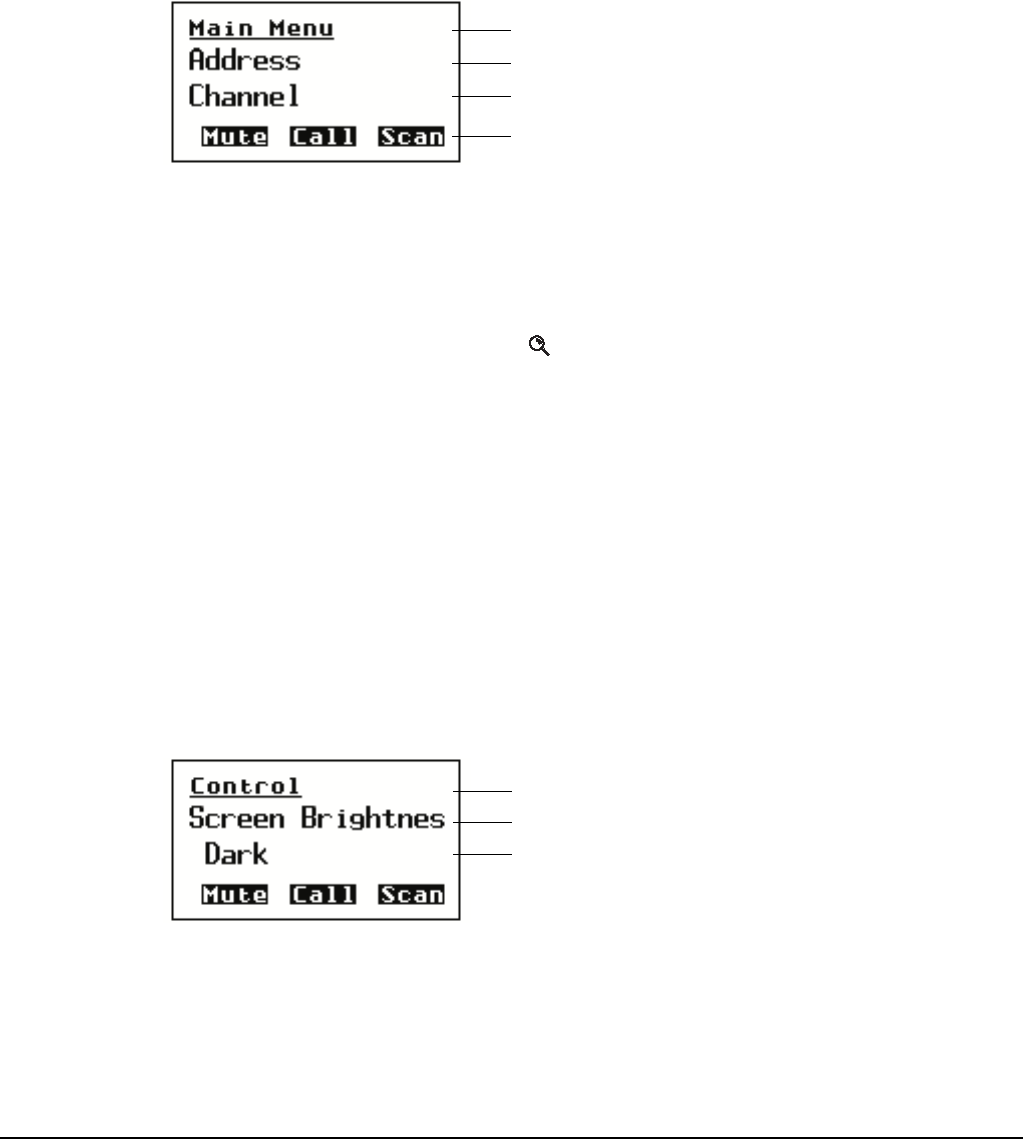
Operating the transceiver
2110 SSB Transceiver Reference Manual 47
The front panel screen
The screen on the front panel consists of three lines.
Figure 7: The front panel screen
The information displayed on the top line depends on the task you are performing. It can
display:
• the name of the list, entry or setting you are in
• the Find prompt when you press
The next line is called the active line. You can use this line to indicate the list or entry
you want to select, to enter text, and to change the value in a setting.
The third line is used when a list is displayed to show either the next item in the list
(Figure 7), or the value in the first or only setting for the entry that is displayed
(Figure 8). When a value is displayed it is indented under the name of the entry to which
it applies. In Figure 8 the value indicates that the Screen Brightness is set to Dark.
The name of each soft function key represents the action that will take place when the
corresponding F1, F2 or F3 key on the front panel of the transceiver is pressed.
Figure 8: The front panel screen displaying a value
The front panel screen also displays information screens such as the channel screen in
the Channel List, and the time screen in the Control List.
NOTE
In the following example, you will need to log in as administrator to see
the Main Menu (see page 110, Logging into admin level from user level
and page 88, The Main Menu).
top line
active line
next item
soft function keys
top line
active line
value
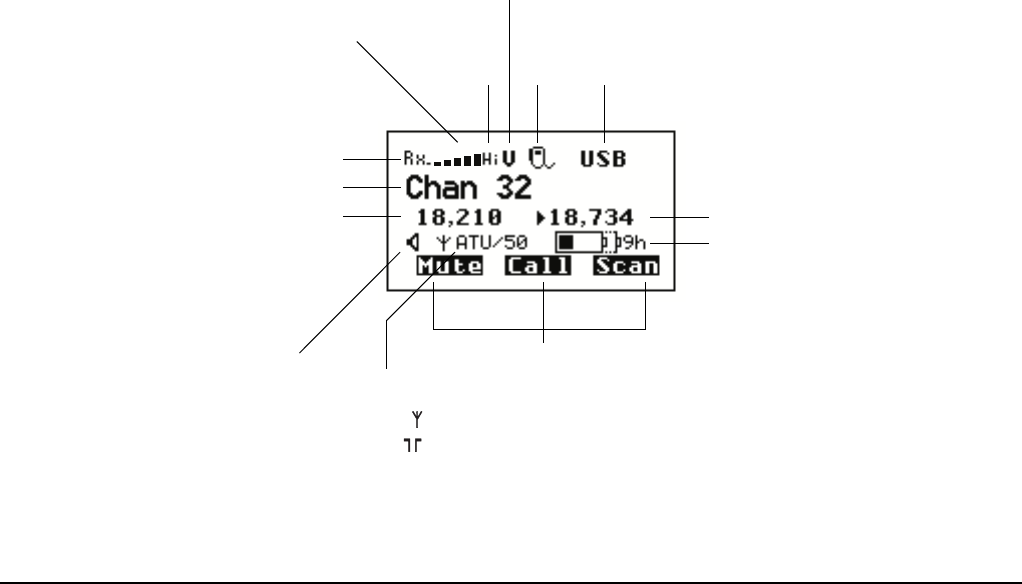
Operating the transceiver
48 2110 SSB Transceiver Reference Manual
The channel screen
The channel screen is the screen that is displayed when you open the Channel List. It
displays:
• the name of the currently selected channel
• a bar graph that indicates the signal strength on receive and the output power on
transmit
• the transmit power level indicator
• the mute type indicator
• the call type icon
• the mode
• the transmit and receive frequencies, if applicable
• an arrow that indicates whether the transceiver is receiving or transmitting
• the internal speaker icon
• the antenna selection icon
• the battery status indicator
• the soft function keys
Figure 9: The channel screen in the Channel List
soft function keys
antenna
battery status/
Tx power
indicator
(Hi/Lo)
channel name
call
Rx freq (kHz)
Rx/Tx indicator
mute type
indicator
internal speaker
signal
strength
(V/S,
type
icon
highlighted
when mute
is on)
mode
indicator
Tx freq (kHz)
(not shown if
Tx/Rx the same)
icon (shown when
speaker enabled)
(internal
50 ohm )
selection icon
power supply
indicator
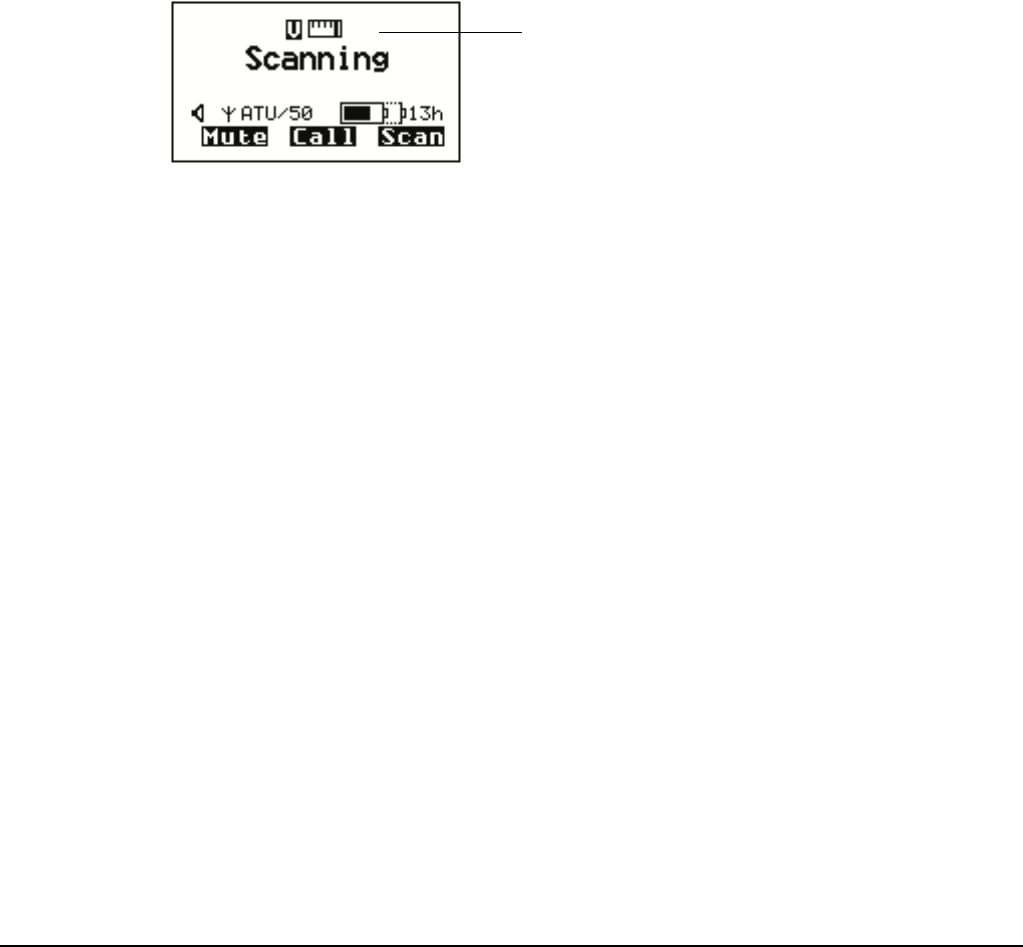
Operating the transceiver
2110 SSB Transceiver Reference Manual 49
If the transmit and receive frequencies are the same, the frequency is only displayed in
the receive frequency position on the right side of the screen and the Rx indicator arrow
is not used. The signal strength/output power indicator shows whether the transceiver is
receiving or transmitting.
Your transceiver has the option of selecting high or low power by pressing Tx PWR.
When low power is selected, Lo is displayed to the right of the signal strength indicator
(see Figure 9). When high power is selected, Hi is displayed in this location.
While a call is being established, the transceiver will show that calling activity is in
progress by flashing CALL in place of the scan indicator (see Figure 10). During a call,
this indicator is replaced with an icon showing the type of call being sent or received (see
Figure 9). These icons are listed in Table 17 on page 158 and Table 18 on page 166.
When the transceiver is scanning, the channel screen is replaced by the scanning screen
(see Figure 10).
Figure 10: The scanning screen
scan indicator
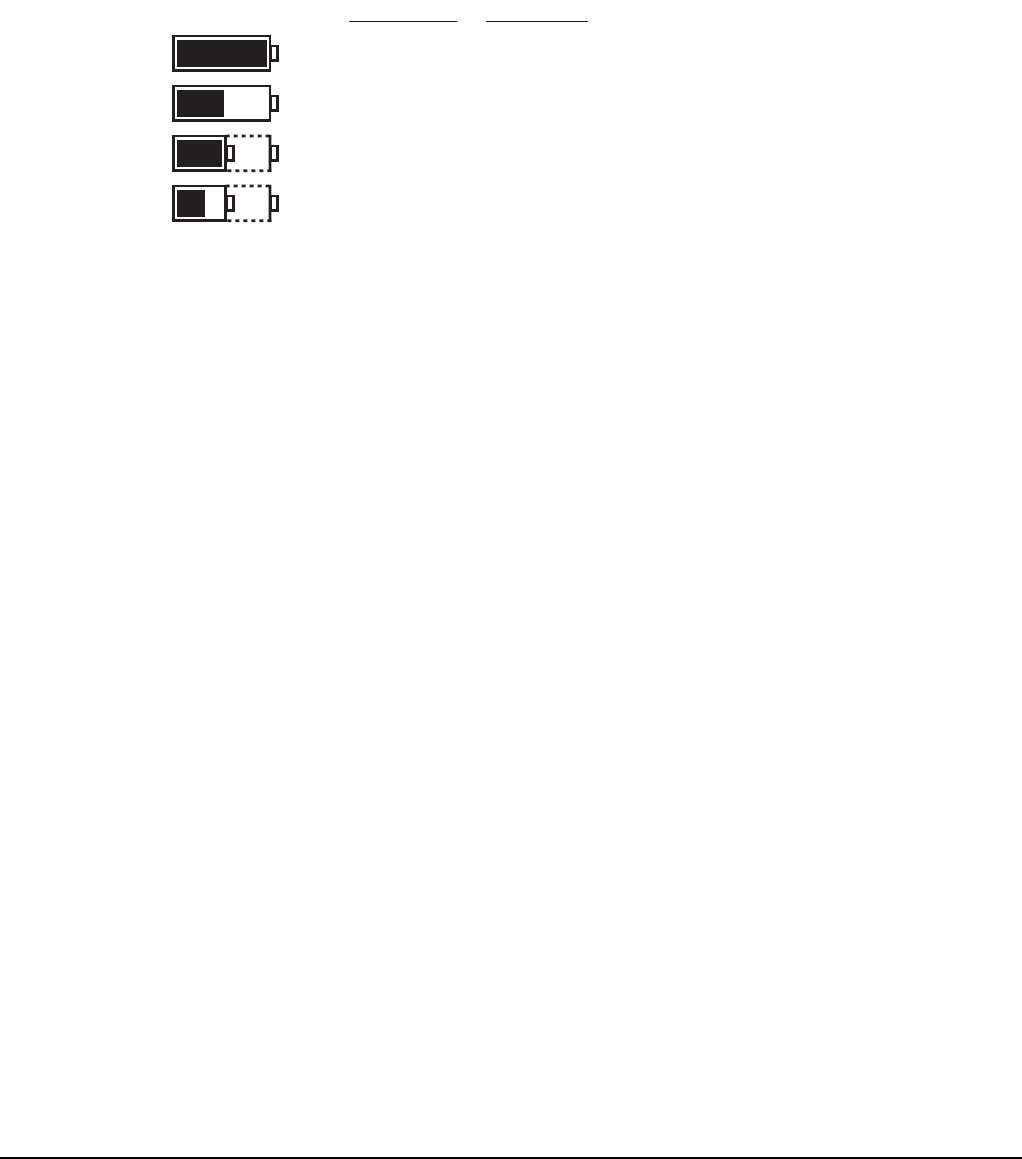
Operating the transceiver
50 2110 SSB Transceiver Reference Manual
Battery status indicator
The channel screen displays a battery status indicator. The indicator graphically shows
the:
• state of charge
• state of health
Figure 11: Battery status indicator
State of charge
The state of charge indicates graphically how much charge is remaining in the battery.
The battery continuously monitors the current consumption of the transceiver and
calculates the remaining hours of use assuming a Tx to Rx ratio of 1:9. Additional
battery information may be viewed in the Battery entry in the Control List.
State of health
Rechargeable batteries have a limited lifetime and a limited number of times that they
may be charged and discharged. Over time, the total amount of charge that a battery may
hold decreases. The state of health indicates graphically how much charge a battery can
still hold, relative to when it was new.
A low state of health indicates that the battery may need replacing.
NOTE You will need to log in as administrator to see the Control List (see
page 110, Logging into admin level from user level).
NOTE When charging a new battery it may show a low state of health until it has
been fully charged and discharged several times.
State of charge State of health
100%
50%
100%
100%
50%100%
50% 50%
32h
16h
16h
8h
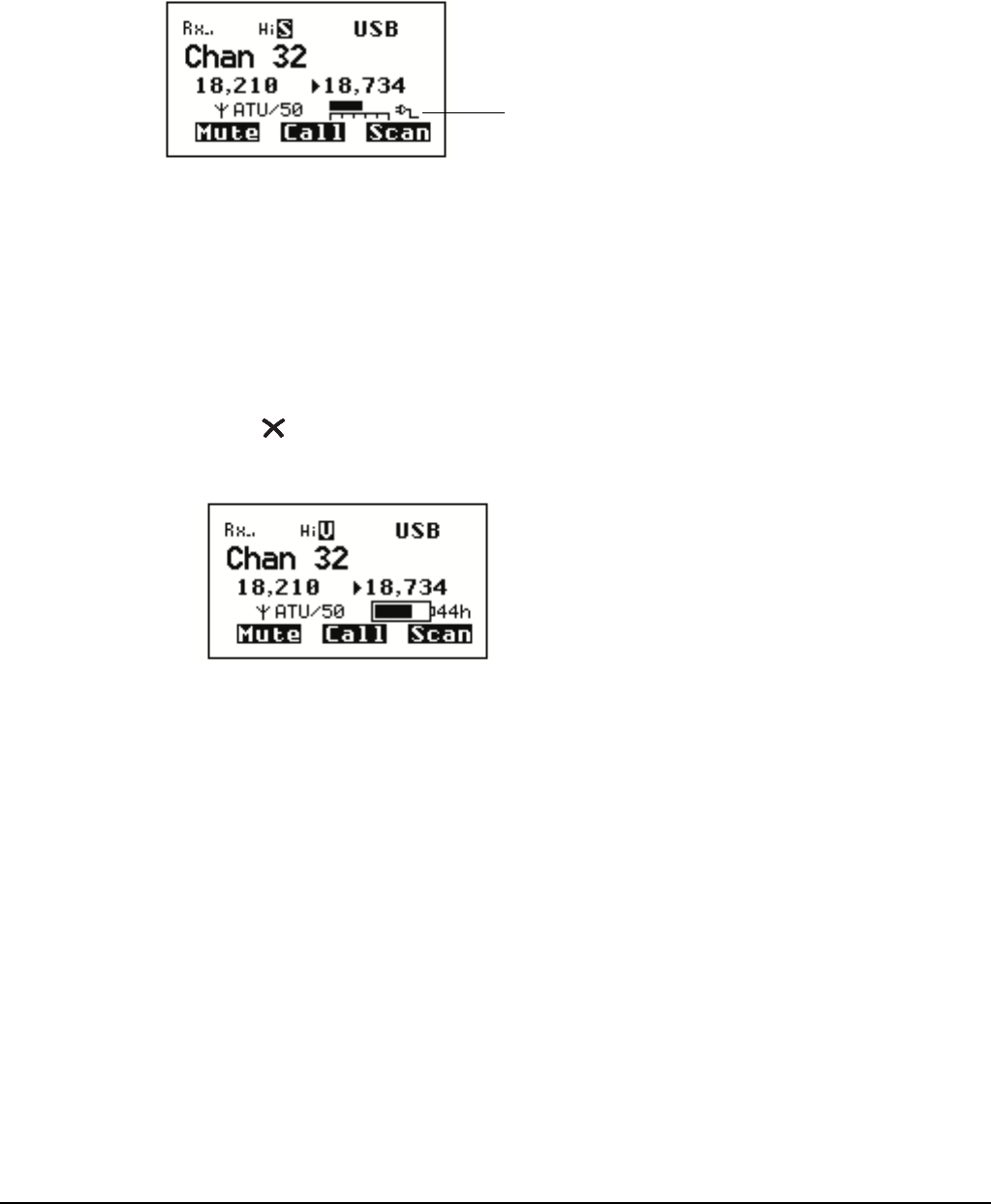
Operating the transceiver
2110 SSB Transceiver Reference Manual 51
External power supply indicator
If you supply 12 V DC power to your transceiver via the 6-way connector on the base of
the unit, the battery status indicator is replaced by the external power supply indicator.
Figure 12: External power supply indicator
The indicator shows the voltage supplied by the power source. The scale of the indicator
is 10–15 V. In the example above, the voltage is just below 13 V.
Selecting a channel
To select a channel:
1Press or VIEW until the channel screen is displayed.
1If the transceiver is scanning, press SCAN to switch off scanning.
1Scroll through the channels in the list. Stop scrolling when the channel you want is
displayed.
The channel is selected.
NOTE
If you want to change the sideband or IF filter settings, press MODE.
If the mode does not change there is only one mode for the channel.
You can also use the Find feature to find a channel (see page 64,
Finding words and values).
If you have an automatic antenna fitted, press PTT to tune the antenna
to the currently selected channel.
external power supply indicator
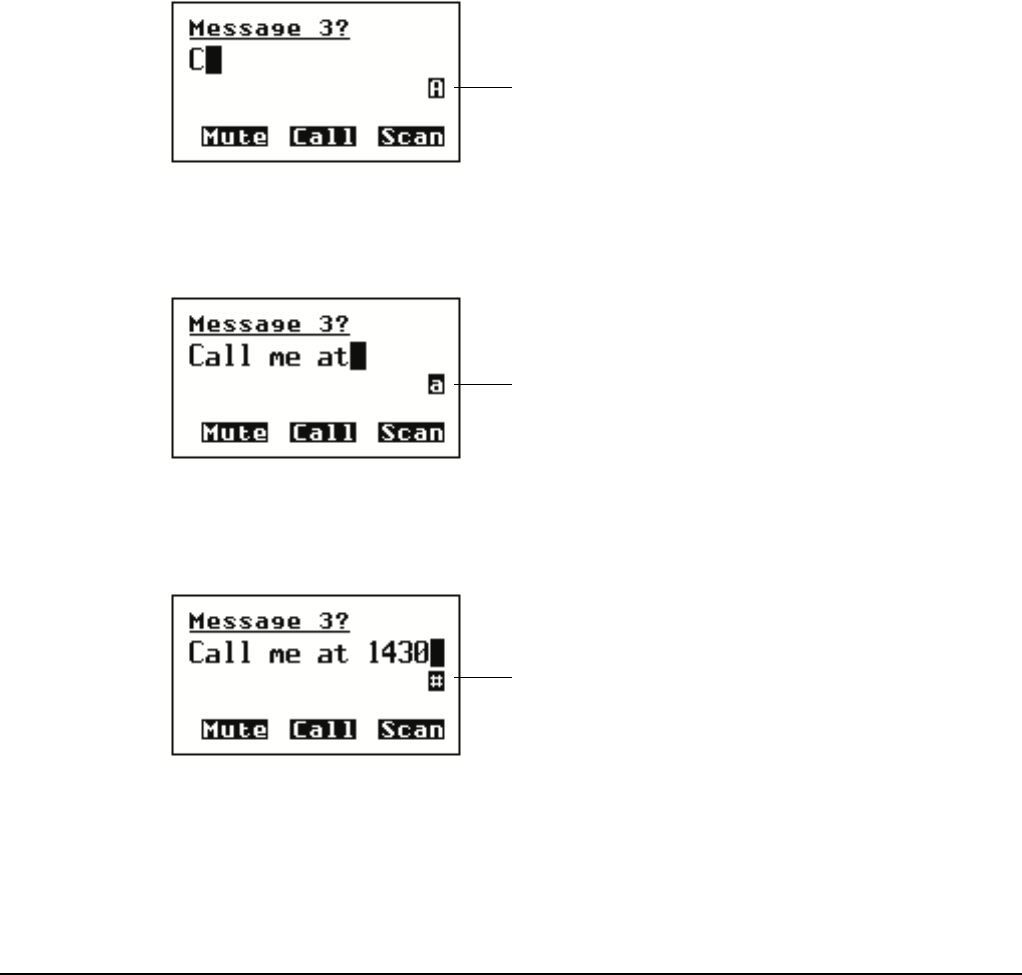
Operating the transceiver
52 2110 SSB Transceiver Reference Manual
Entering and editing text
There are several situations in which you may be prompted to enter or edit text, for
example, when you enter the address of a station you want to call, when you select a
setting in which text is required, or when you create an entry in a list. The numeric
keypad on the front panel is context sensitive so that, in these situations, you can use the
numeric keys to enter letters, numbers and symbols.
The editable screens
A screen in which you can enter or edit text will have a question mark at the end of the
title line and a character/case indicator in the bottom right of the screen.
Figure 13: Editable screen showing upper-case text entry
Figure 14: Editable screen showing lower-case text entry
Figure 15: Editable screen showing numeric text entry
indicates upper-case text entry
indicates lower-case text entry
indicates numeric text entry
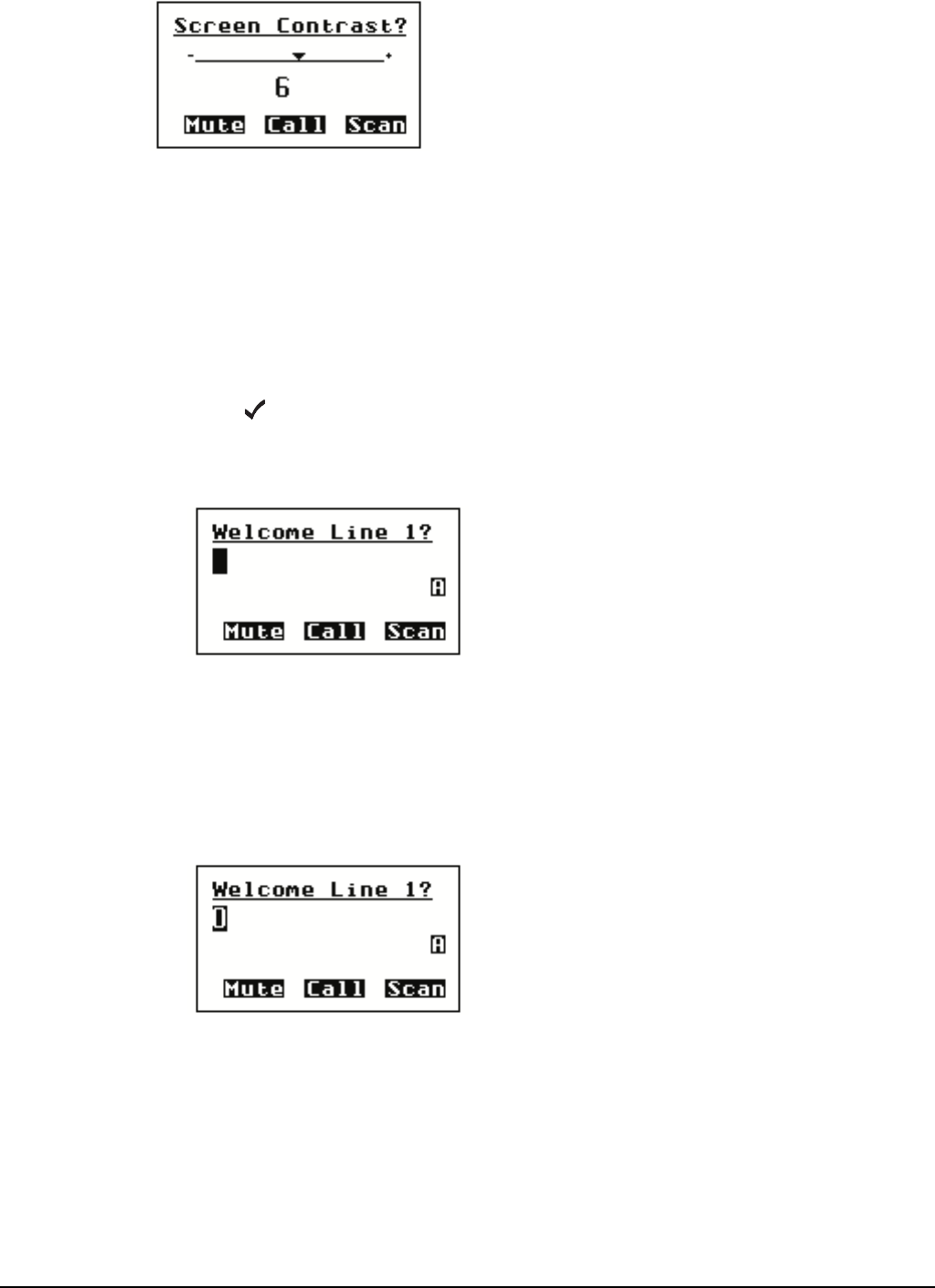
Operating the transceiver
2110 SSB Transceiver Reference Manual 53
Figure 16: Editable screen showing slider
Editing a screen
To gain access to an editable screen:
1Hold .
A question mark is displayed at the end of the heading to show that you can now
enter and/or edit text in the setting.
Entering text
To enter text in an editable screen:
1To enter one of the letters on a key, press the key repeatedly until the letter is
displayed.
1To enter another letter on the same key, wait until the cursor moves to the next
space...
NOTE
In the following example, you will need to log in as administrator to see
the Welcome Text entry in the Control List (see page 110, Logging into
admin level from user level).
NOTE You can also hold the key until the letter you want is displayed, then
release the key.
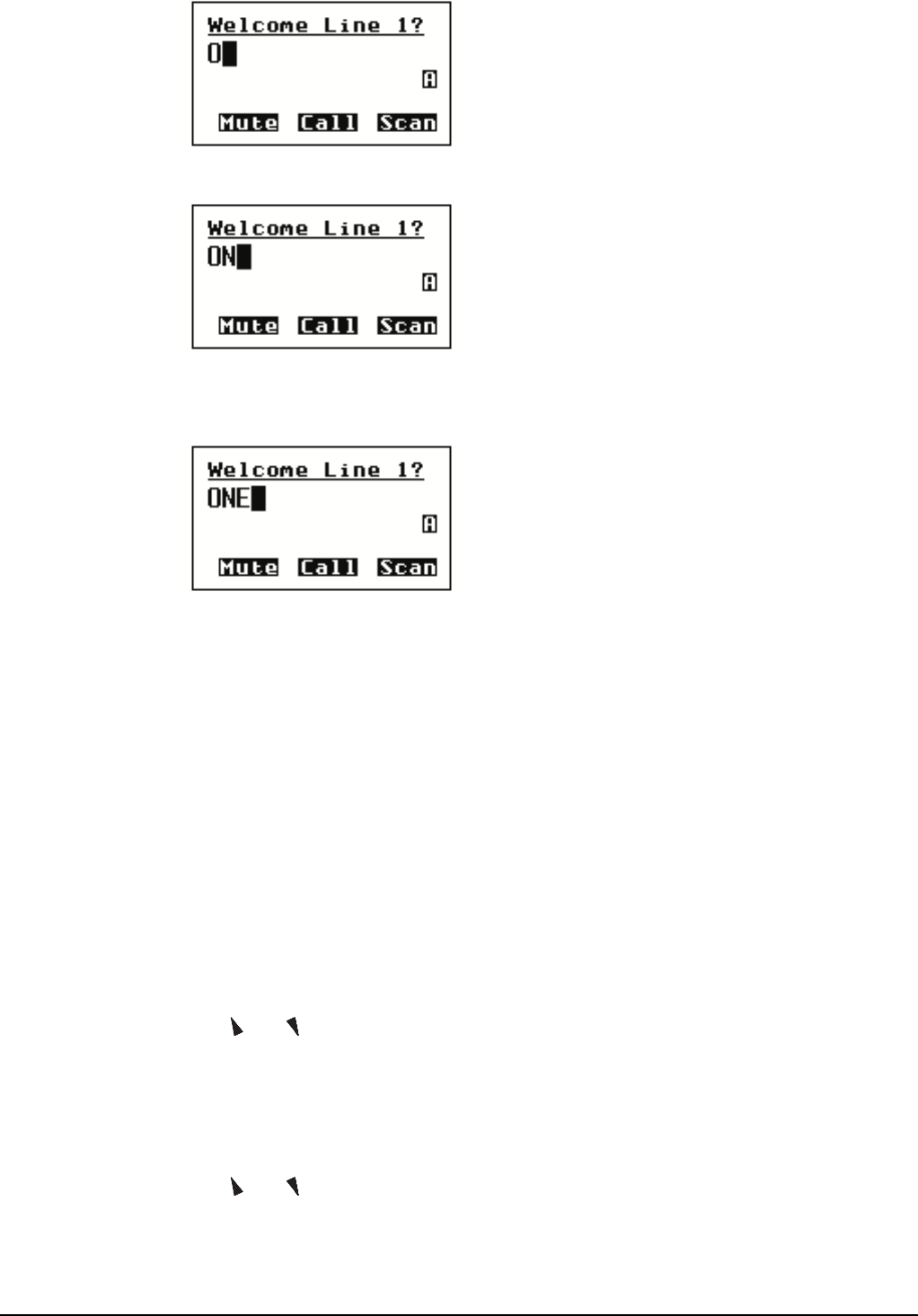
Operating the transceiver
54 2110 SSB Transceiver Reference Manual
...then press the key repeatedly until the letter you want is displayed.
1To enter a letter on another key, press the key for the letter.
You do not need to wait until the cursor moves to the next space.
Changing between alpha and numerical characters
To change between upper-case and lower-case letters and numbers in an editable screen:
1Press # to change the character/case indicator at the bottom right of the screen from
A to a to #.
Moving the cursor
To move the cursor across the text:
1Use and to move the cursor left and right respectively.
Inserting text
To insert text:
1Use and to move the cursor to the point where you want to insert text (or a
space), then press the required character key.
NOTE
When you are prompted to enter a call address, the types of
characters that you can enter are determined by the call systems
installed in the transceiver.
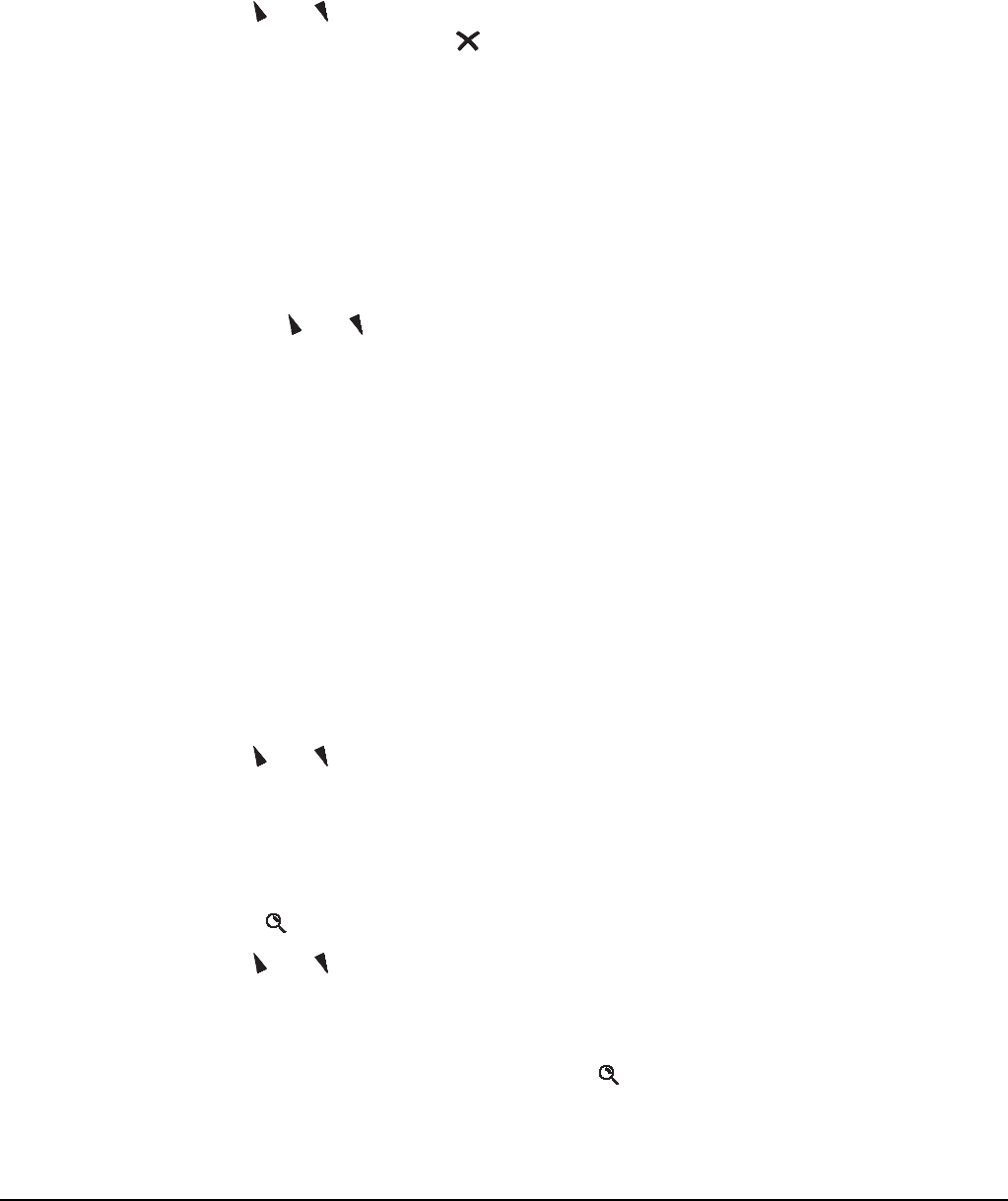
Operating the transceiver
2110 SSB Transceiver Reference Manual 55
Deleting text
To delete text:
1Use and to move the cursor one position to the right of the character that you
want to delete, then press .
Entering special characters in messages and names
To enter special characters:
1Use the and keys to move the cursor to the point where you want to insert a
special character, then press * repeatedly until the symbol you want is displayed.
To enter one of an extended range of special characters:
1Use and to move the cursor to the character or space where you want to replace
a character.
1Press to place an underscore beneath the current character or space.
1Use and to scroll through the character choices.
1When you have selected the character that you want to use, use 1 or 3 to scroll left
or right respectively.
1When you have made the changes, press to exit the special character mode.
NOTE
If you want to insert a space, make sure that A or a is displayed at the
bottom right of the screen before you press 0, otherwise you will
enter a zero.
NOTE The special characters that are available are:
. , ’ ? ! & # $ * ( ) - + /
NOTE Make sure that A or a is displayed at the bottom right of the screen
before you press *, otherwise you will enter a decimal point.
NOTE
The characters that are available are:
space , . ; ? : ¨ ‘ ’ / ! @ # $ % ^ & * ( ) _ - + = | \ ~ <
> { } [ ] 0 1 2 3 4 5 6 7 8 9
A B C D E F G H I J K L M N O P Q R S T U V W X Y Z
a b c d e f g h i j k l m n o p q r s t u v w x y z
NOTE If you want to add a new character, enter a space then move the
cursor to this space.
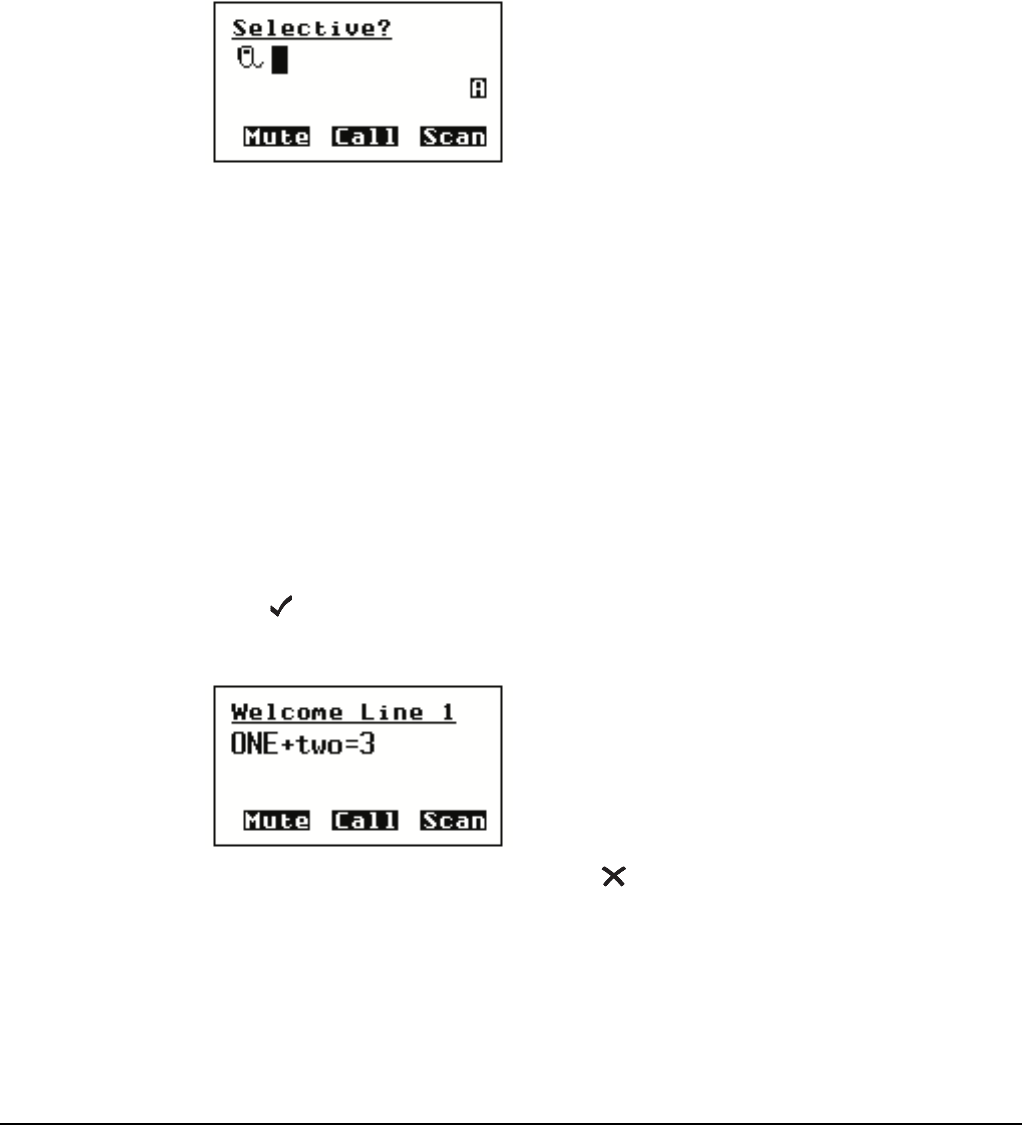
Operating the transceiver
56 2110 SSB Transceiver Reference Manual
Entering text in an ALE call address
To enter a special ALE addressing character:
1Ensure that you are in an editable address screen in which you can enter upper-case
letters (A).
1Do one of the following:
• to enter an @, press * once
•to enter a ?, press * twice while the cursor is in the same space
• to enter a comma, press * three times while the cursor is in the same space
• to enter any upper-case letter, press the corresponding key
• to enter a number, press # once to change to numeric text entry, then press the
corresponding key
Saving text changes
To save the changes you have made:
1Press .
The question mark is removed from the heading.
If you do not want to save the text, hold to discard the changes.
NOTE If the MIL-STD-188-141B ALE option is installed in your transceiver, the
*key may be used to enter the special ALE addressing characters easily.
NOTE You can use any of the characters in the basic 38 ASCII subset (A–Z, 0–9,
@ and ?) for the address.

Operating the transceiver
2110 SSB Transceiver Reference Manual 57
Quick Start
Quick Start provides a simple way of:
• adding channels
• assigning channels to a scan list
• setting the time and date
• setting the self address of your station
• adding, changing or deleting entries from lists
Quick Start will be available if your transceiver contains only one station self address
and network names from this default list:
•*Voice
•*Selcall
•*CALM
• !Default
Quick Start is accessed via the key. Standard List Manager functions as described on
page 91, The List Manager are accessed through the Advanced... entry in the List
Manager when Quick Start is available. When Quick Start has been disabled by entering
a non-default network name or by entering more than one station self address, all List
Manager functionality is accessed directly by holding the key.
Quick Start is not available in countries that do not permit programming of transmit
frequencies using the front panel, for example, the United States of America and
Australia.
Opening and closing Quick Start
To open Quick Start:
1Hold .
To close Quick Start:
1Press or hold .
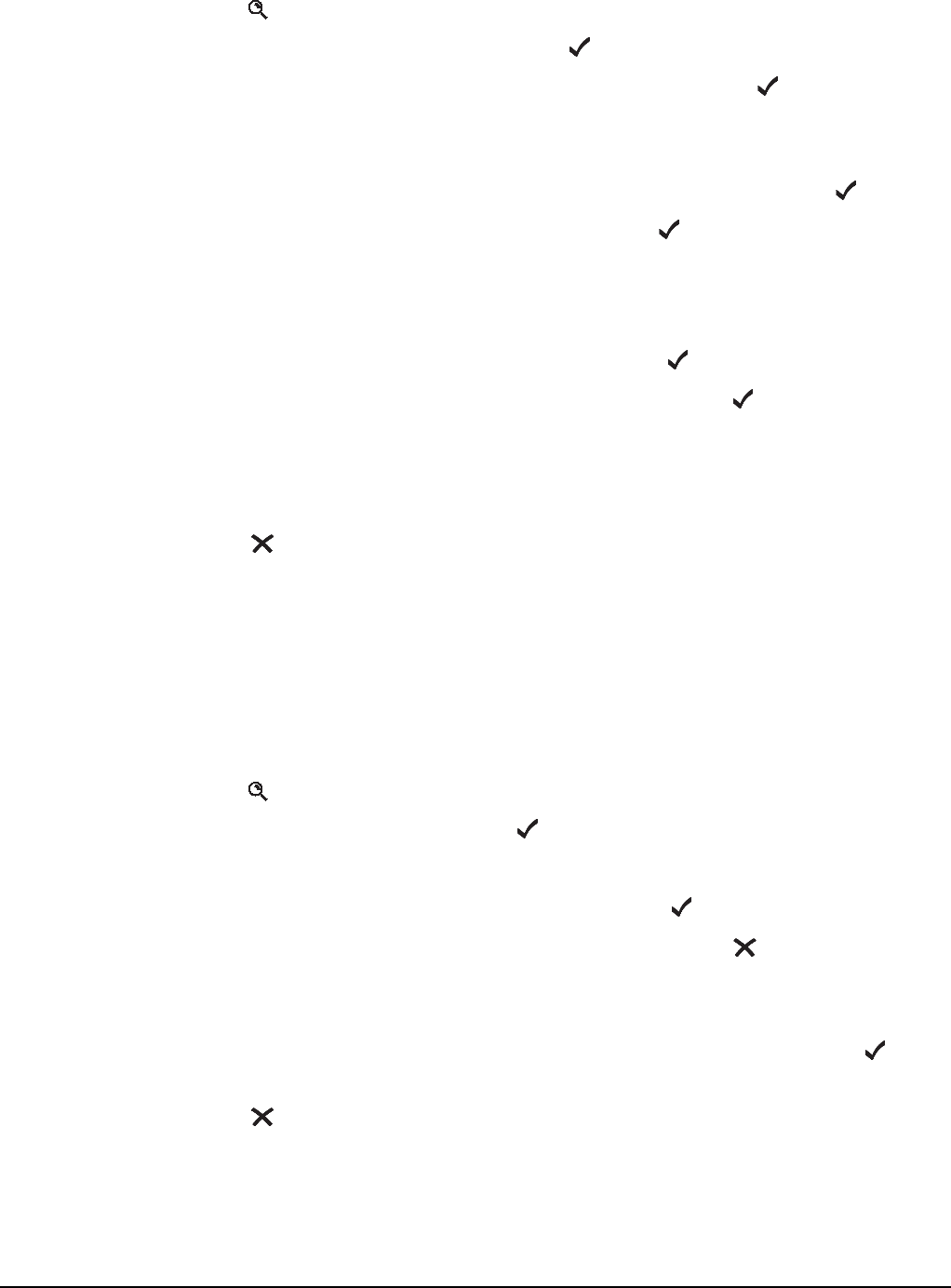
Operating the transceiver
58 2110 SSB Transceiver Reference Manual
Adding/Editing a channel
To add or edit a channel:
1Hold to open Quick Start.
1Scroll to Add/Edit channel, then press .
1Enter the name of the channel that you want to use, then press .
If you want to use an existing channel, scroll to the channel, then press .
1Enter the receive frequency in kilohertz, then press .
1Enter the transmit frequency in kilohertz, then press .
1Scroll to the mode combination you want to use, then press .
The transceiver will return to Quick Start.
1If you want to add more channels to your transceiver, scroll to Add/Edit channel
and repeat this process.
1Press to close Quick Start, if required.
Setting up a scan list
To set up a scan list:
1Hold to open Quick Start.
1Scroll to Set scan list, then press .
The first channel in the transceiver will be displayed.
1If you want to add this channel to the scan list, press .
If you do not want to add this channel to the scan list, press .
When all the channels have been viewed or you have added 20 channels to your scan
list, the transceiver will return to Quick Start.
If you do not want to scroll through all the channels in your scan list, hold to
return to Quick Start.
1Press to close Quick Start, if required.
NOTE For help with entering text see page 52, Entering and editing text.
NOTE You can enter the frequency to three decimal places. Press * to enter
a decimal point, then continue with entering the frequency.
NOTE If you want to make or receive calls on this new channel, you must
add it to your scan list.
CAUTION Each time you enter Set scan list, the resulting scan list will
overwrite the existing scan list.
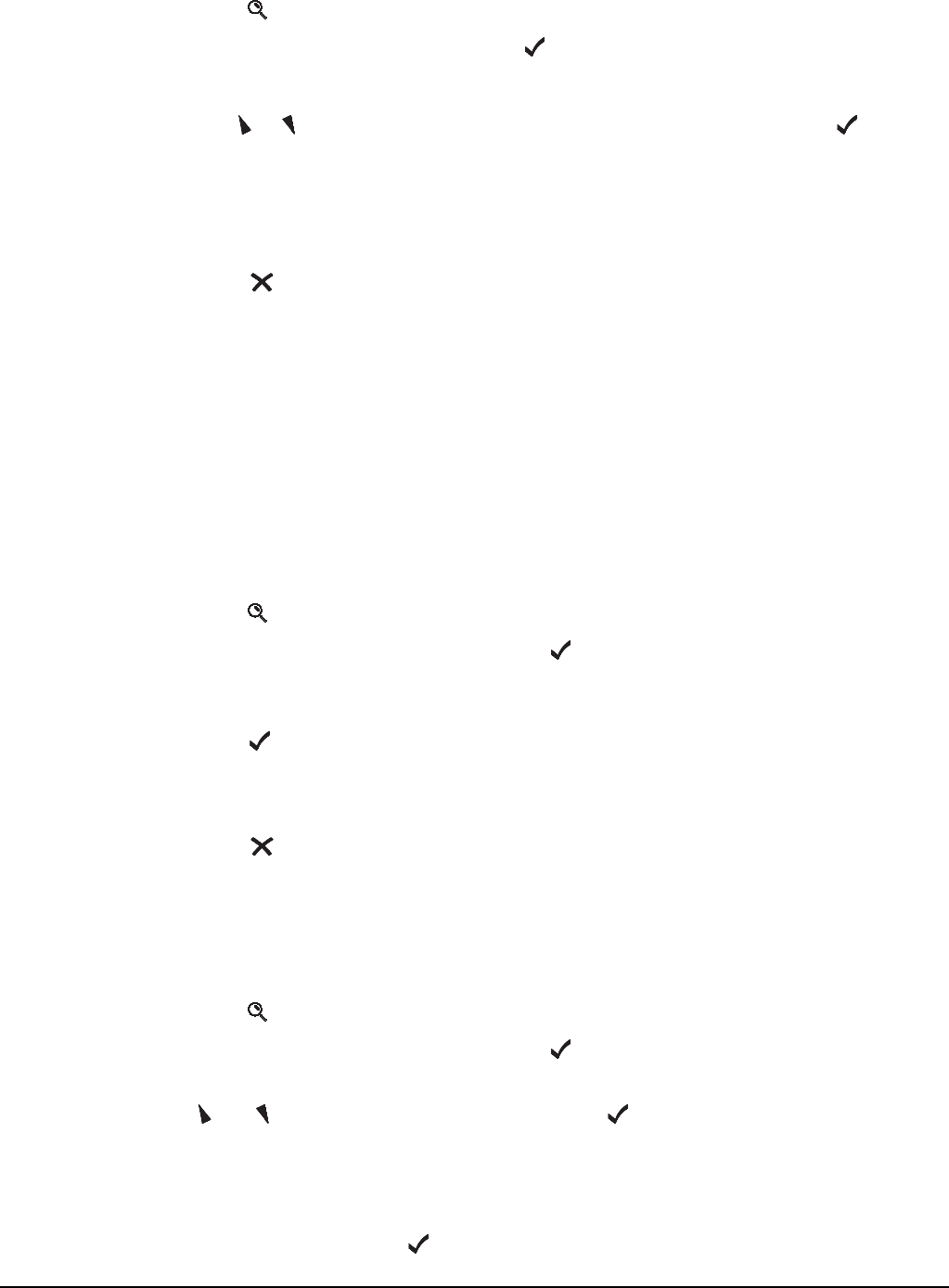
Operating the transceiver
2110 SSB Transceiver Reference Manual 59
Setting the time and date
To set the time and date:
1Hold to open Quick Start.
1Scroll to Set time/date, then press .
The display will appear with a line under the day of the month.
1Use or to change the current setting to the correct value, then press .
The line will appear under the month.
1Repeat the previous step until you have made all of the changes to the time and date.
When all the changes have been made, the transceiver will return to Quick Start.
1Press to close Quick Start, if required.
Setting your station self address
To set your station self address:
1Hold to open Quick Start.
1Scroll to Set my address, then press .
1Enter your station self address (maximum of 6 numeric digits for a Codan Selcall
network, and 15 upper-case/numeric digits for an ALE/CALM network), then
press .
1Press to close Quick Start, if required.
Adding/Editing an entry in the Address List or Call Book
To add or edit an address that you call frequently:
1Hold to open Quick Start.
1Scroll to Address/CallBk, then press .
1Enter the name of the station or person that you want to add to the list, or use
and to select an existing entry, then press .
1Scroll to the type of call that you want to make, enter the station address that you
want to call, then press .
NOTE
When Quick Start is available, any self address that you enter using this
method will replace the previous self address. If you want to enter more
than one self address, and hence disable the Quick Start features, see
page 69, Entering your station self address.
NOTE For help with entering text see page 52, Entering and editing text.
NOTE For help with entering text see page 52, Entering and editing text.

Operating the transceiver
60 2110 SSB Transceiver Reference Manual
1If you selected Message? or No call type, enter the message, then press .
If you do not want to enter a message, press .
1Scroll to the call system that you want to use to make the call, then press .
1If you selected Phone? or No call type, select <blank> for the phone link that
you want to use, then press .
When all the changes have been made to the call address, the transceiver will return
to Quick Start.
1If you want to add more call addresses to your Address List or Call Book, scroll to
Address/CallBk and repeat this process.
1Press to close Quick Start, if required.
Deleting an entry
To delete addresses, channels or phone links:
1Hold to open Quick Start.
1Scroll to Delete..., then press .
You can delete items from the Address/CallBk, Channel or Phone Link Lists.
1Scroll to the list from which you want to delete an item, then press .
1Scroll to the item you want to delete, then press .
1Press to close Quick Start, if required.
NOTE If you delete a channel from the Channel List, it will be deleted from
the scan list automatically.

Operating the transceiver
2110 SSB Transceiver Reference Manual 61
Muting the transceiver
When the transceiver is set to a channel or is scanning channels, you hear the noise on
each channel. If you do not want to listen to this noise you can silence the transceiver by
switching mute on. When the transceiver has been muted continuously for more than
10 seconds it will switch to low-current mode. The transceiver will return to full current
use when mute is opened. You can disable the low-current mode by setting the Cfg Low
Current Mode entry in the Control List to Disabled.
Mute automatically comes on when the transceiver starts scanning. You must set the
Mute Scan entry in the Control List to:
• Selcall if you want the mute to open when a call addressed to your station is detected
or voice is detected on a channel in a voice network
• Voice if you want the mute to open when a voice signal is detected (you can alter the
dwell time across Codan Selcall networks)
• Scan for Voice if you want the mute to open when a voice signal is detected on any
network (the transceiver scans at a uniform rate across all networks)
If the scan is paused due to voice being detected, the length of time that the transceiver
holds the pause is set in the Cfg Scan Voice Max Hold and Cfg Scan Voice Extend
entries in the Control List.
Switching mute on or off
To switch mute on or off:
1Press MUTE.
A message is displayed briefly to inform you that mute has been switched on or off.
Setting the mute type
To select the mute type:
1Press V/S to toggle the mute type between Selcall mute and Voice mute.
NOTE
In the following discussion, you will need to log in as administrator to see
the entries in the Control List (see page 110, Logging into admin level
from user level).
NOTE For help on these entries in the Control List see page 200, Entries in the
Control List and page 96, Changing a setting in the Control List.

Operating the transceiver
62 2110 SSB Transceiver Reference Manual
Scanning channels
If you expect to receive calls on several channel/modes, switch scanning on. When
scanning is switched on the transceiver selects each channel/mode in your network in
quick succession to detect incoming calls. The channel/modes are scanned in a
continuous cycle. Mute is switched on automatically.
When the transceiver detects a call addressed to your station it stops scanning and
notifies you according to the type of call received (see page 190, Receiving a call). When
you press SCAN to end the call, scanning resumes. If you do not press this key to end
the call, or any other key within 30 seconds, the transceiver automatically ends the call
and resumes scanning.
When the transceiver detects voice it notifies you according to the mute setting selected
(see page 61, Muting the transceiver). If your transceiver is set to notify you when voice
is detected you can pause scanning, select the channel/mode on which the voice was
heard, then resume scanning when required.
It is recommended that scanning is switched on when you are not using the transceiver to
communicate.
Switching scanning on or off
To switch scanning on or off:
1Press SCAN.
If a call is not in progress, scanning is toggled on or off.
If a call is in progress, the call is ended and the transceiver begins scanning.
Pausing scanning
To pause scanning:
1Do one of the following:
• to pause scanning on the current channel/mode, press
• to pause scanning and scroll to another channel/mode, press or
The channel/modes through which you can scroll are those in the network or
networks that were being scanned. They are not listed alphabetically but in the order
in which they were being scanned.
If you do not press a key within 30 seconds, the transceiver automatically resumes
scanning.
1While scanning is paused, do one or more of the following:
• to speak, hold down PTT
• to resume scanning immediately, press
NOTE When scanning is switched on, mute is also switched on.
You cannot use the PTT button while the transceiver is scanning.

Operating the transceiver
2110 SSB Transceiver Reference Manual 63
Using the microphone
The microphone is located at the bottom of your handset, just like a telephone handset.
When you talk into the microphone:
• hold the handset as you would a telephone handset
•hold down PTT
• speak clearly at your normal volume and rate
• use the word ‘over’ to indicate that you have finished speaking, then release PTT
(the transceiver also transmits a short beep when you release PTT)
• remember that your conversation can be monitored by anyone tuned to your transmit
frequency
If PTT is held continuously for a certain length of time, the system stops transmission,
switches to receive and displays an error message on the front panel. This ensures that,
even if the PTT button is being held down accidentally (because, for example, you are
sitting on the handset), power consumption is minimised and the transceiver is ready to
receive calls.
You can set the length of time the system waits before it cuts transmission, or switch this
feature off, by using the PTT Cutout Time entry in the Control List (see page 200,
Entries in the Control List).
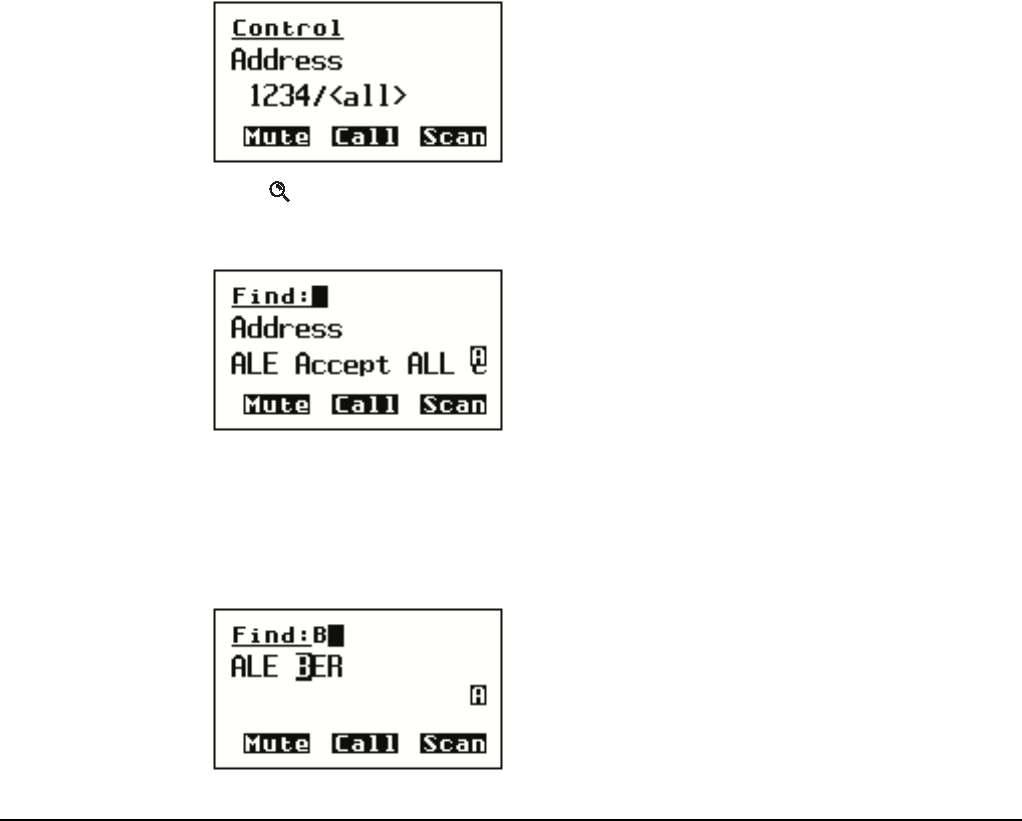
Operating the transceiver
64 2110 SSB Transceiver Reference Manual
Finding words and values
Scrolling through lists, entries and settings is one way to find items. The Find feature,
however, may help you find them faster.
There are two types of searches you can perform to find specific items. You can:
• search for any word in the Main Menu or in an entry in a list that begins with a
specific character (for example, find all the entries in the Control List that contain
the word ‘beep’, such as Key Beep and PTT Beeps)
• search for a value in a setting (for example, find all the channels in the Channel List
with a receive frequency of 13000 kHz)
Finding a word
To find any word in the Main Menu or in the name of an entry:
1From Main Menu, select the list in which you want to search.
The first entry in the list is displayed. For example:
1Press once.
The Find prompt is displayed on the top line.
1Enter the first character of the word you want to find.
The first item that contains a word beginning with this character is displayed.
NOTE In the following examples, you will need to log in as administrator to see
the Main Menu (see page 110, Logging into admin level from user level).
NOTE For help with finding a value see page 65, Finding a value.
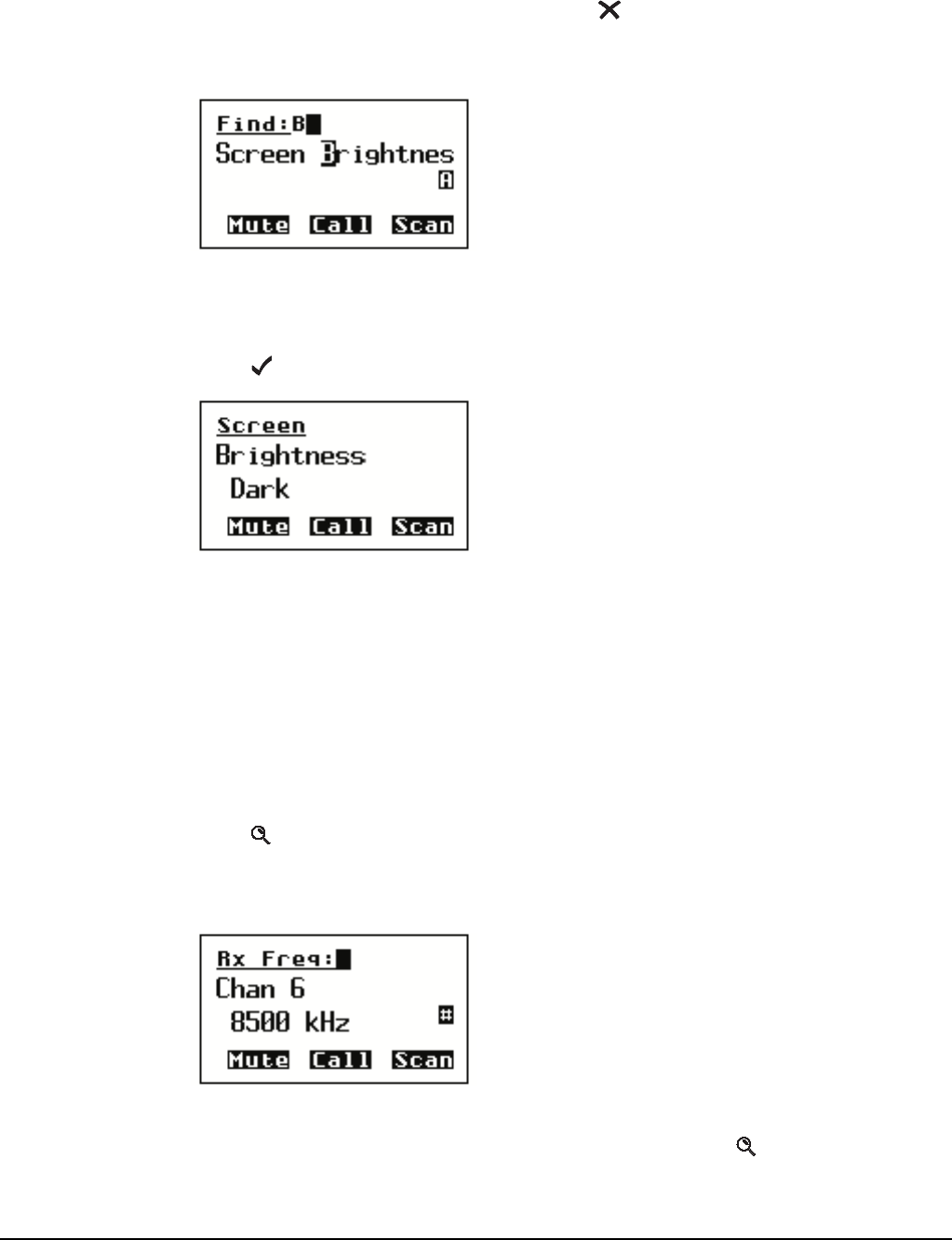
Operating the transceiver
2110 SSB Transceiver Reference Manual 65
If there aren’t any words that begin with this character the character is deleted and
an error beep is made.
1Scroll through the list until the item you want is displayed on the active line.
1Press to exit Find at the entry.
Finding a value
To find a value that begins with a specific character:
1From Main Menu, select the list in which the value is stored.
1Press twice.
The Find prompt is displayed on the top line with the name of the first setting in the
entry. For example:
NOTE
To refine your search, enter more characters in the word you want to
find.
To backspace over text, press .
NOTE If the list doesn’t scroll then there is only one word that matches the
characters you entered.
NOTE You cannot use this type of search in the Main Menu or in the Control
List.
NOTE
The search for a value will be conducted in the setting displayed. To
search for a value in a different setting, press until that setting is
displayed.
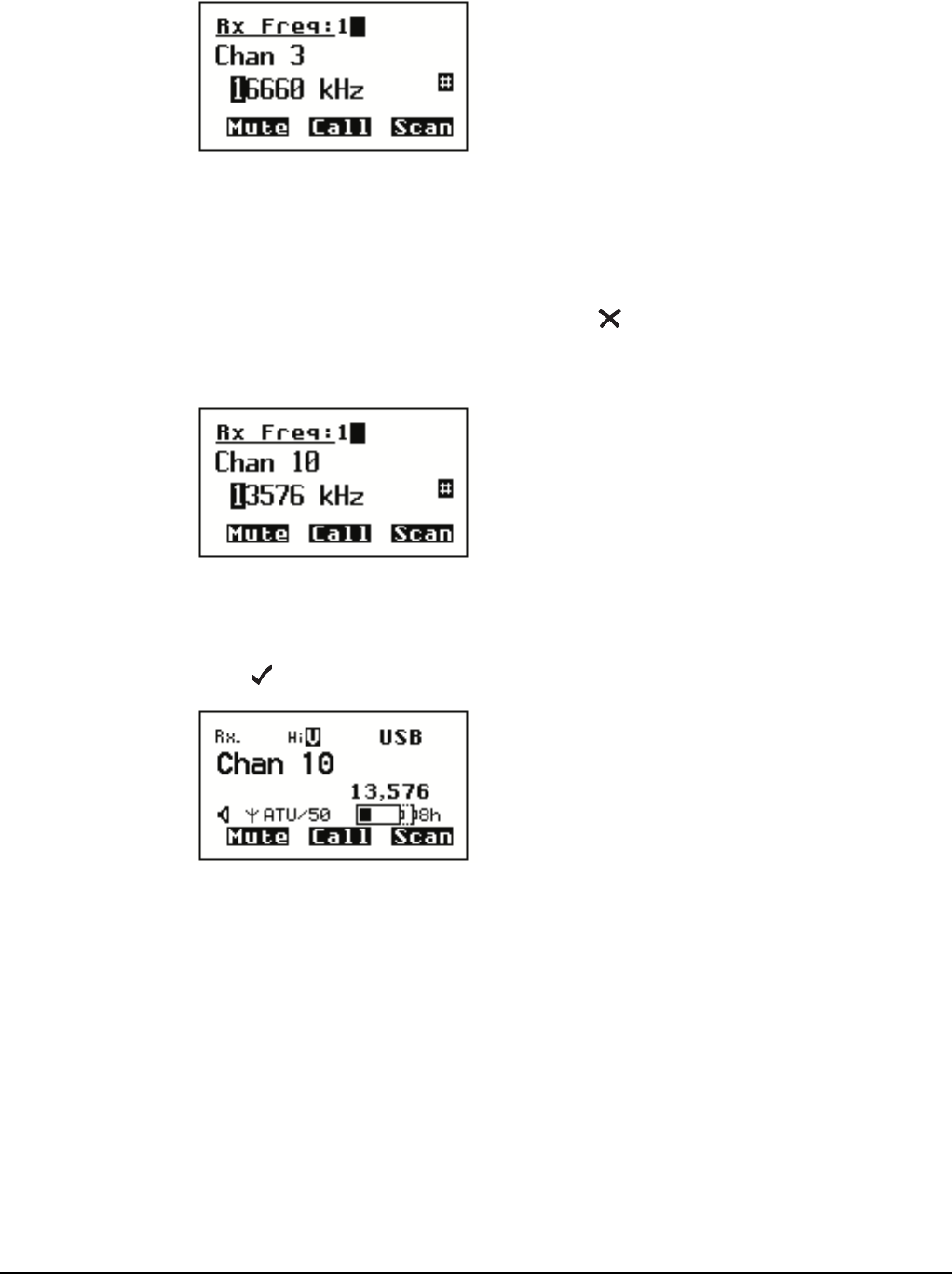
Operating the transceiver
66 2110 SSB Transceiver Reference Manual
1Enter the first character of the value you want to find.
The first entry that contains a value beginning with this character is displayed, and
the value is displayed beneath it.
If there aren’t any values that begin with this character the character is deleted and
an error beep is made.
1Scroll through the entries until the one you want is displayed.
1Press to exit Find at the entry.
NOTE
To refine your search, enter more characters in the value you want to
find.
To backspace over text, press .
NOTE If the list doesn’t scroll then there is only one value that matches the
characters you entered.
NOTE If you are in the Channel List the transceiver selects this channel.
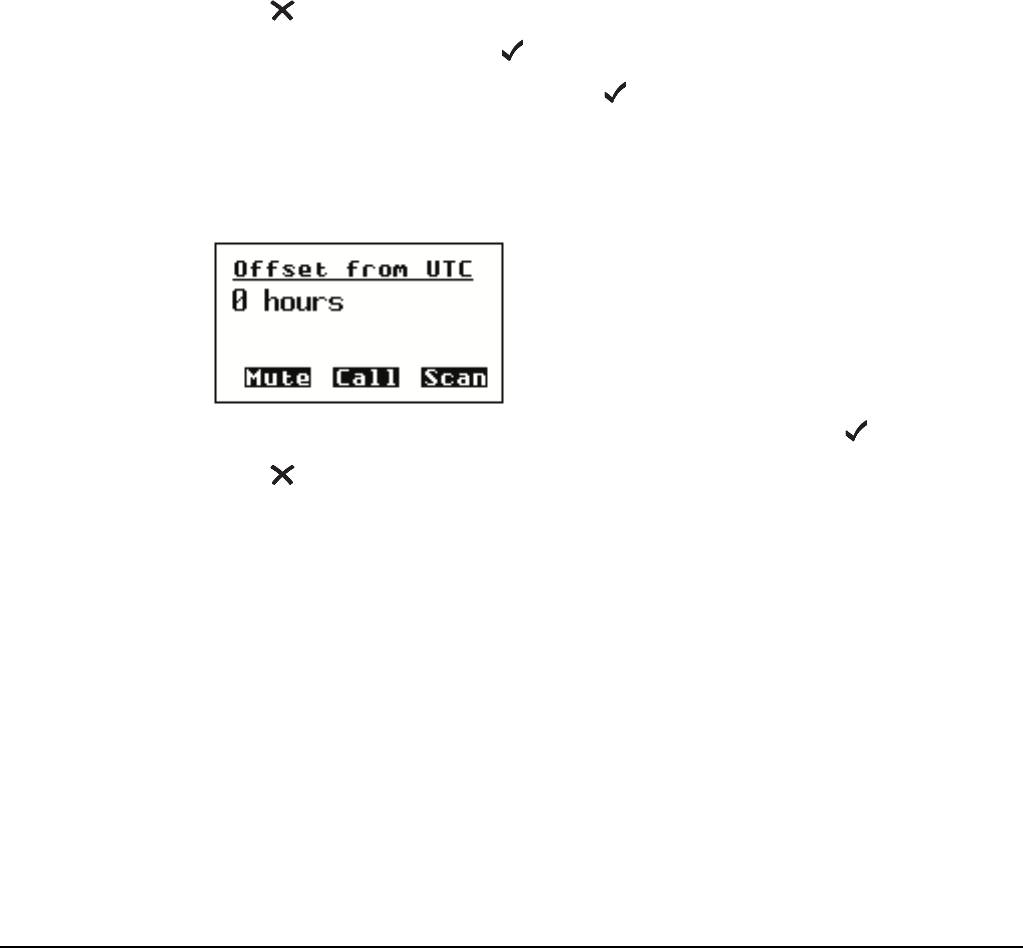
Operating the transceiver
2110 SSB Transceiver Reference Manual 67
Setting the basics
Setting the time and date
When the transceiver leaves the factory it is set to UTC time with a time zone offset of
zero. To set your local time and date you need to enter your time zone offset from UTC
time, then adjust the local time and date if necessary. This feature is useful if you have a
network that spreads over several time zones, or you need to time stamp your
transmissions according to the current time at longitude zero.
Setting the time zone offset
To set your time zone offset from UTC time:
1Press until Main Menu is displayed.
1Scroll to Control, then press .
1Scroll to Time Zone Offset, then hold .
1Scroll to the correct time zone offset for your location, then press .
1Press until Main Menu is displayed.
NOTE In the following discussion, you will need to log in as administrator to see
the Main Menu (see page 110, Logging into admin level from user level).
NOTE Scroll to the entry or use the Find feature (for help see page 64,
Finding words and values).
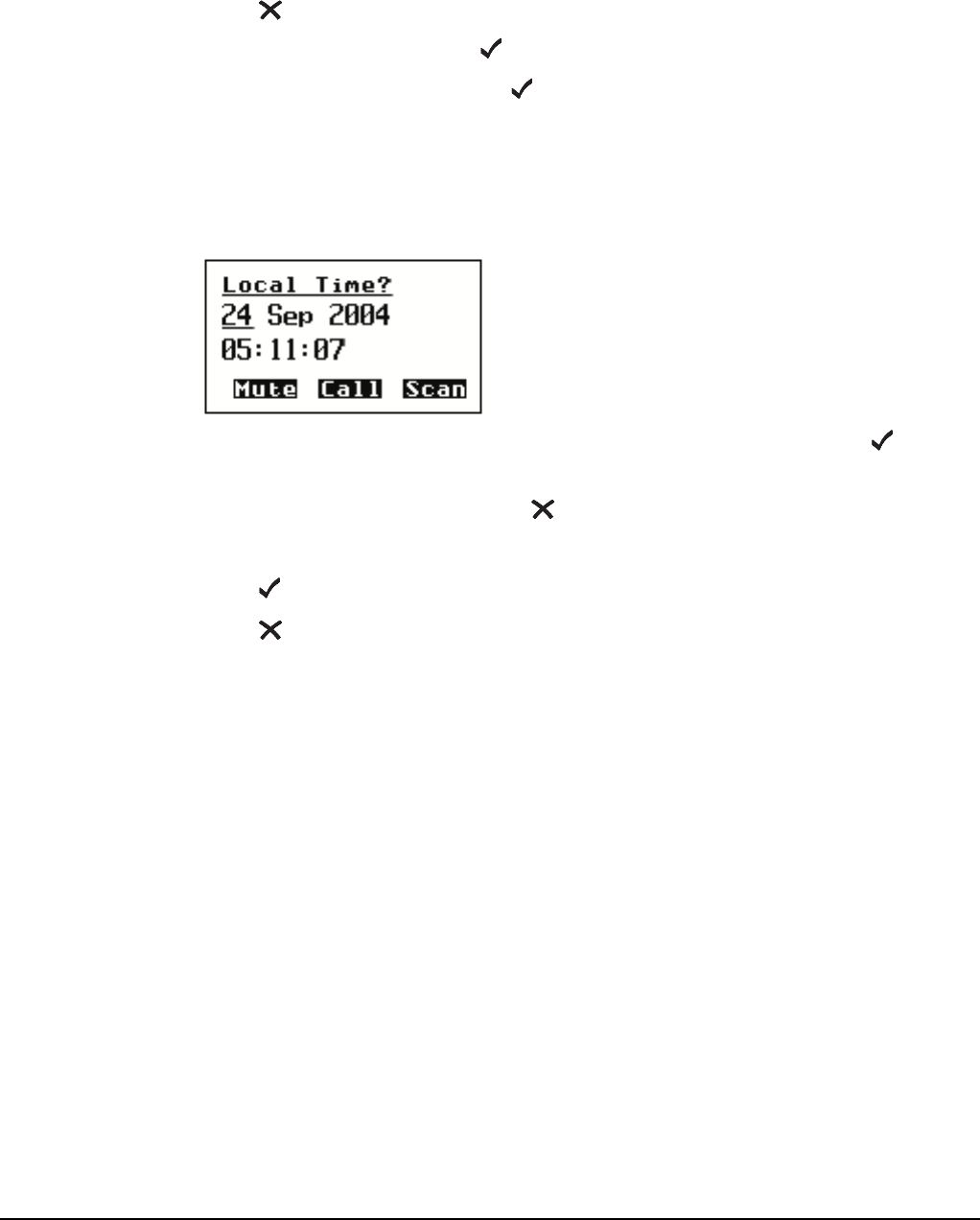
Operating the transceiver
68 2110 SSB Transceiver Reference Manual
Adjusting the local time and date
If the local time and date are not correct after setting your time zone offset from UTC
time, adjust the local time and date.
To adjust the local time and date:
1Press until Main Menu is displayed.
1Scroll to Control, then press .
1Scroll to Time Local, then hold .
The cursor is placed under the day of the month.
1Scroll through the values until the one you want is displayed, then press to go to
the next setting.
To go to the previous setting, press .
1Repeat the previous step until the date and time are correct.
1Press after setting the seconds to save your changes.
1Press until Main Menu is displayed.
NOTE Scroll to the entry or use the Find feature (for help see page 64,
Finding words and values).
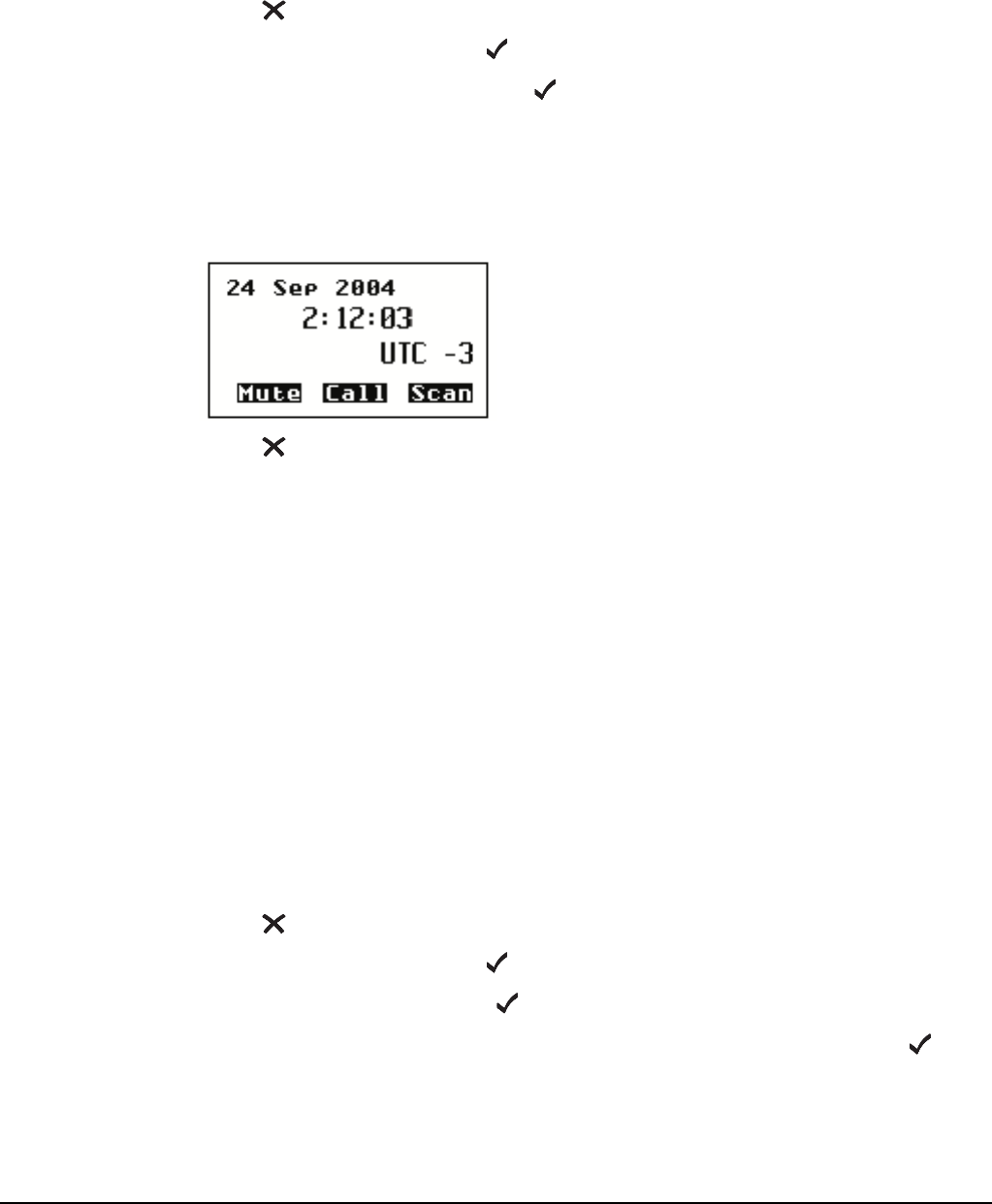
Operating the transceiver
2110 SSB Transceiver Reference Manual 69
Displaying the local time and date
To display the local time and date:
1Press until Main Menu is displayed.
1Scroll to Control, then press .
1Scroll to Time Screen, then hold .
The time screen is displayed.
1Press until Main Menu is displayed.
Entering your station self address
Your station self address is the address used by other stations to call you, and it is sent
when you make calls to identify you as the caller. You can enter up to 20 self addresses
for your station. This section explains how to enter, edit and delete station self addresses.
Entering a self address
To enter your station self address:
1Press until Main Menu is displayed.
1Scroll to Control, then press .
1Scroll to Address, then press .
If a self address has not yet been entered the screen displays (none). Press to
open the List Manager.
NOTE In the following discussion, you will need to log in as administrator to see
the Main Menu (see page 110, Logging into admin level from user level).
NOTE Scroll to the entry or use the Find feature (for help see page 64,
Finding words and values).
NOTE
In the following discussion, you will need to log in as administrator to see
the entries in the Control List (see page 110, Logging into admin level
from user level).
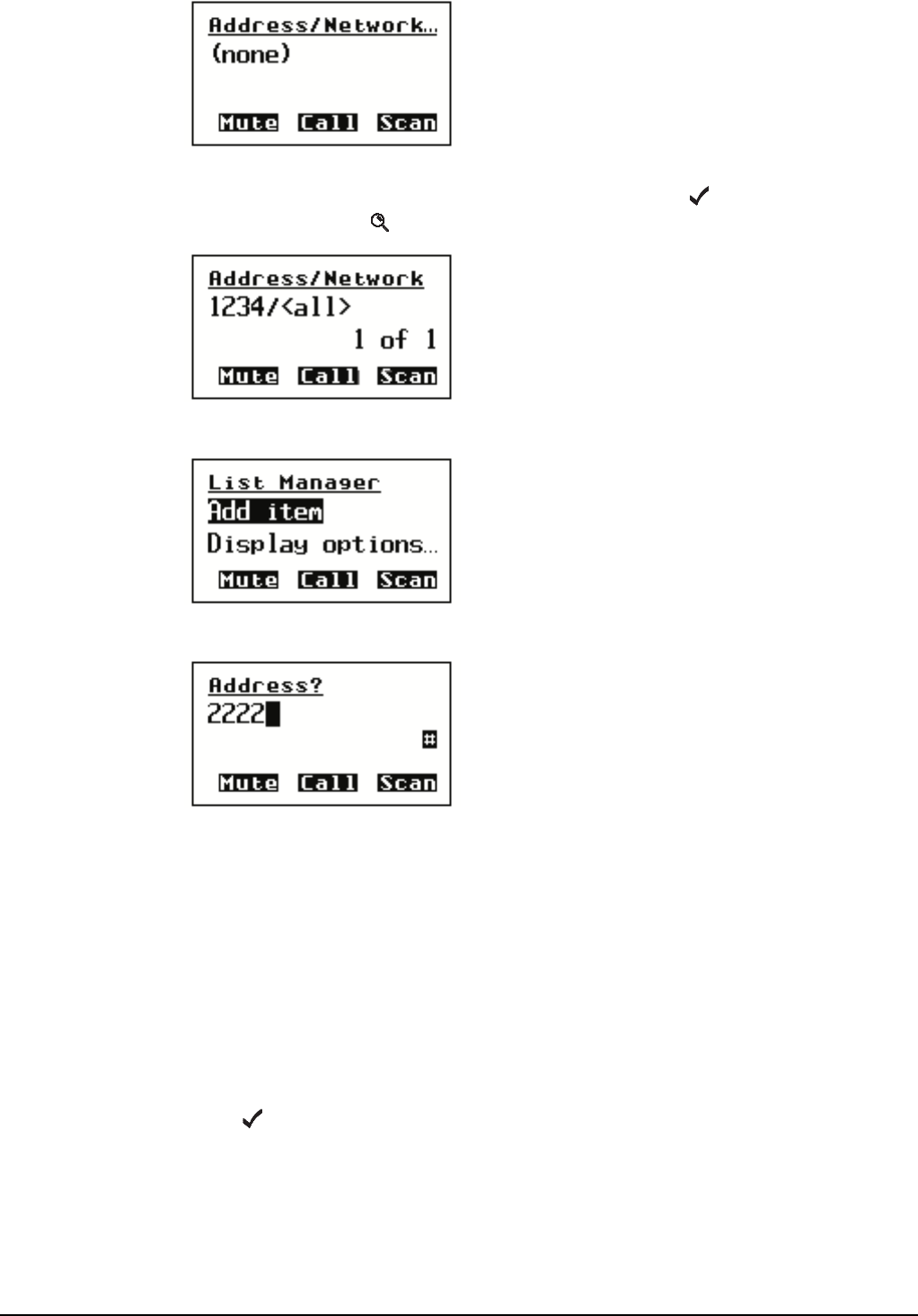
Operating the transceiver
70 2110 SSB Transceiver Reference Manual
If one or more self addresses have already been entered the screen displays the
number of self addresses (for example, (1 items)). Press to display the self
addresses, then hold to open the List Manager.
1Select Add item.
1Enter the self address of your station. For example:
If you are entering a self address to be used in:
• a Codan Selcall network, enter up to 6 numeric digits
• an ALE/CALM network, enter up to 15 upper-case/numeric digits, or a
combination of both (see page 158, Special ALE address syntaxes)
1Press .
1Select the network in which you want to use this self address.
To use the self address in all networks, select <all>.
NOTE For help with entering text see page 52, Entering and editing text.
NOTE
Do not enter a self address that ends with one or more zeros. Zeros
are used to indicate that calls are to be made to groups of stations in a
Codan Selcall network.
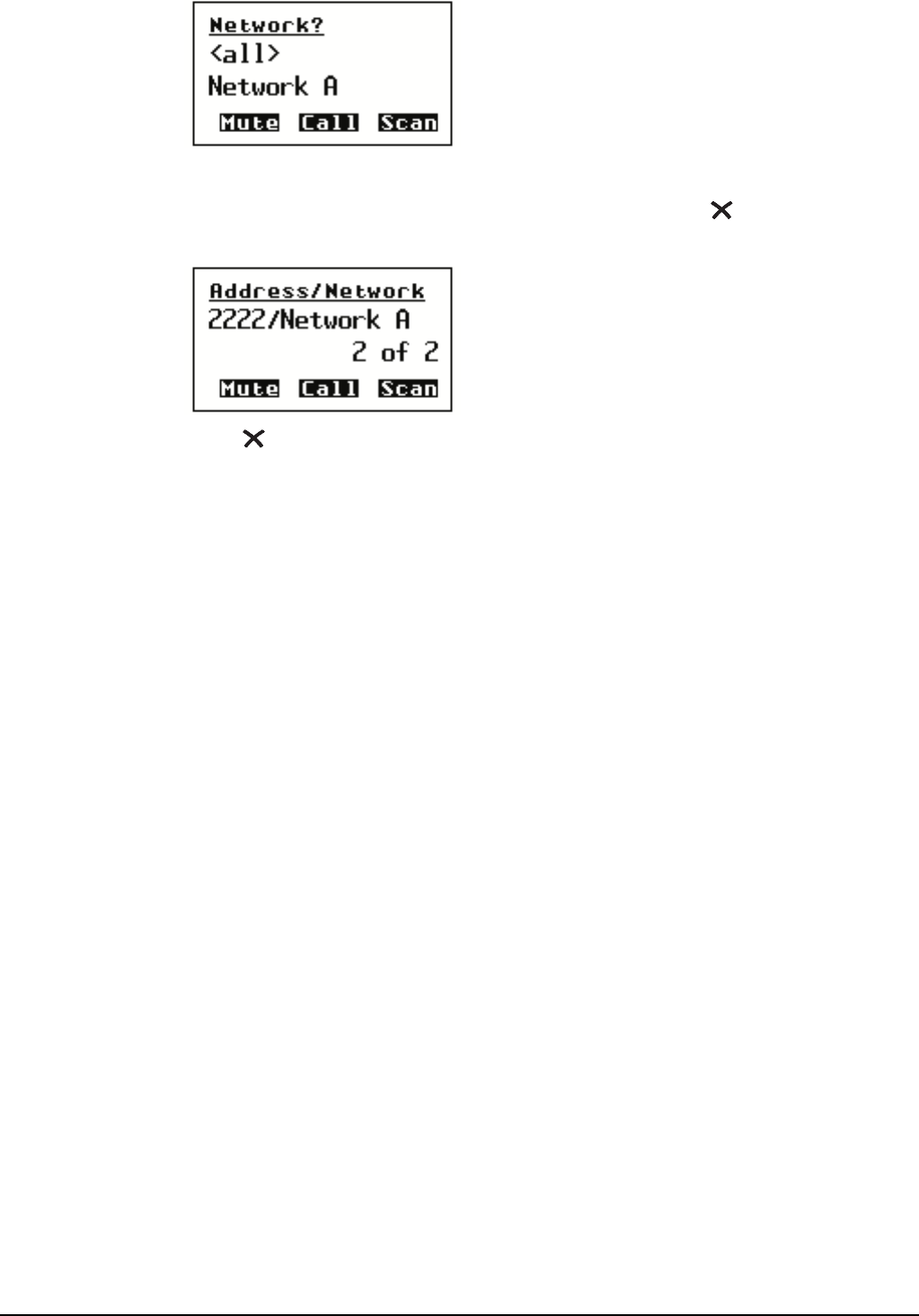
Operating the transceiver
2110 SSB Transceiver Reference Manual 71
The self address is created and the List Manager remains open.
1If you want to view the self address you have created, press to close the List
Manager.
1Press until Main Menu is displayed.
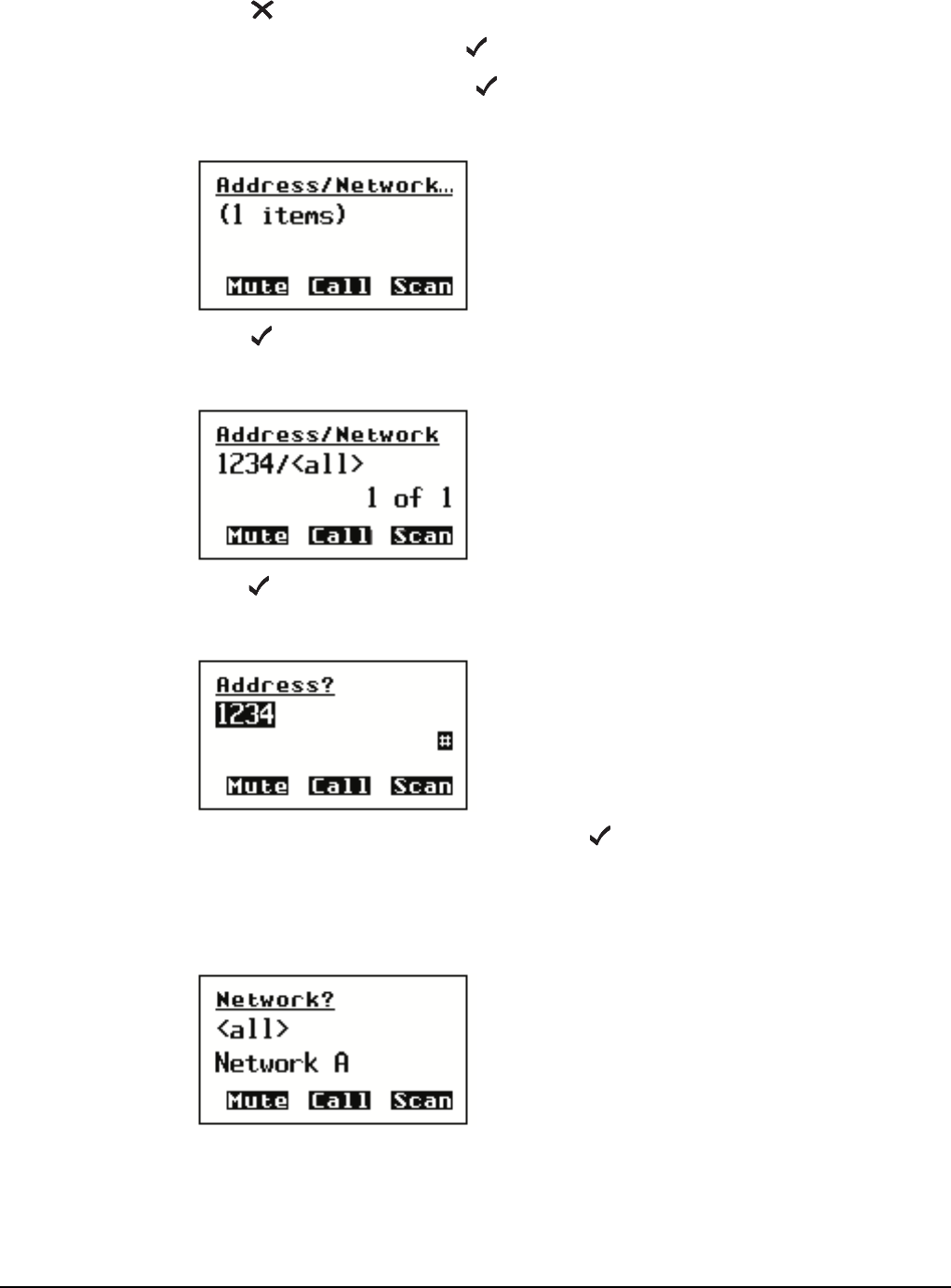
Operating the transceiver
72 2110 SSB Transceiver Reference Manual
Editing a self address
To edit a station self address:
1Press until Main Menu is displayed.
1Scroll to Control, then press .
1Scroll to Address, then press .
The number of self addresses in the list is displayed. For example:
1Press to display the self address/addresses.
If there is more than one self address, scroll to the self address you want to edit.
1Hold to edit the self address.
The self address is displayed.
1Edit the self address as required, then press .
The network is displayed.
NOTE For help with entering text see page 52, Entering and editing text.
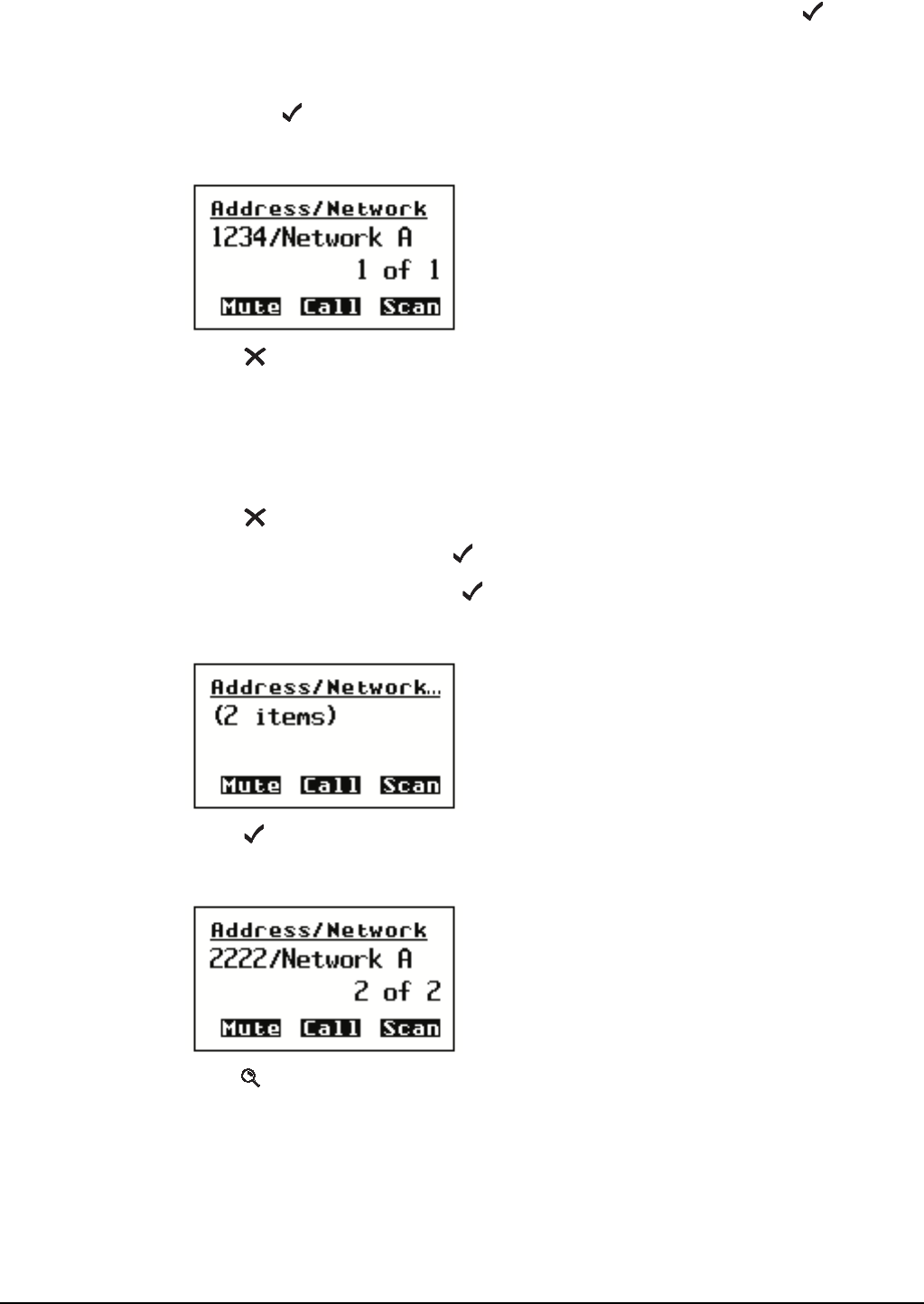
Operating the transceiver
2110 SSB Transceiver Reference Manual 73
1Do one of the following:
• to change the network, scroll to the network you want, then press
• to use the self address in all networks, select <all>
• if you do not want to change the network, scroll to the original network, then
press
The new details are saved.
1Press until Main Menu is displayed.
Deleting a self address
To delete a station self address:
1Press until Main Menu is displayed.
1Scroll to Control, then press .
1Scroll to Address, then press .
The number of self addresses in the list is displayed. For example:
1Press to display the self address/addresses.
1Scroll to the self address you want to delete.
1Hold to open the List Manager.
1Select Delete item.
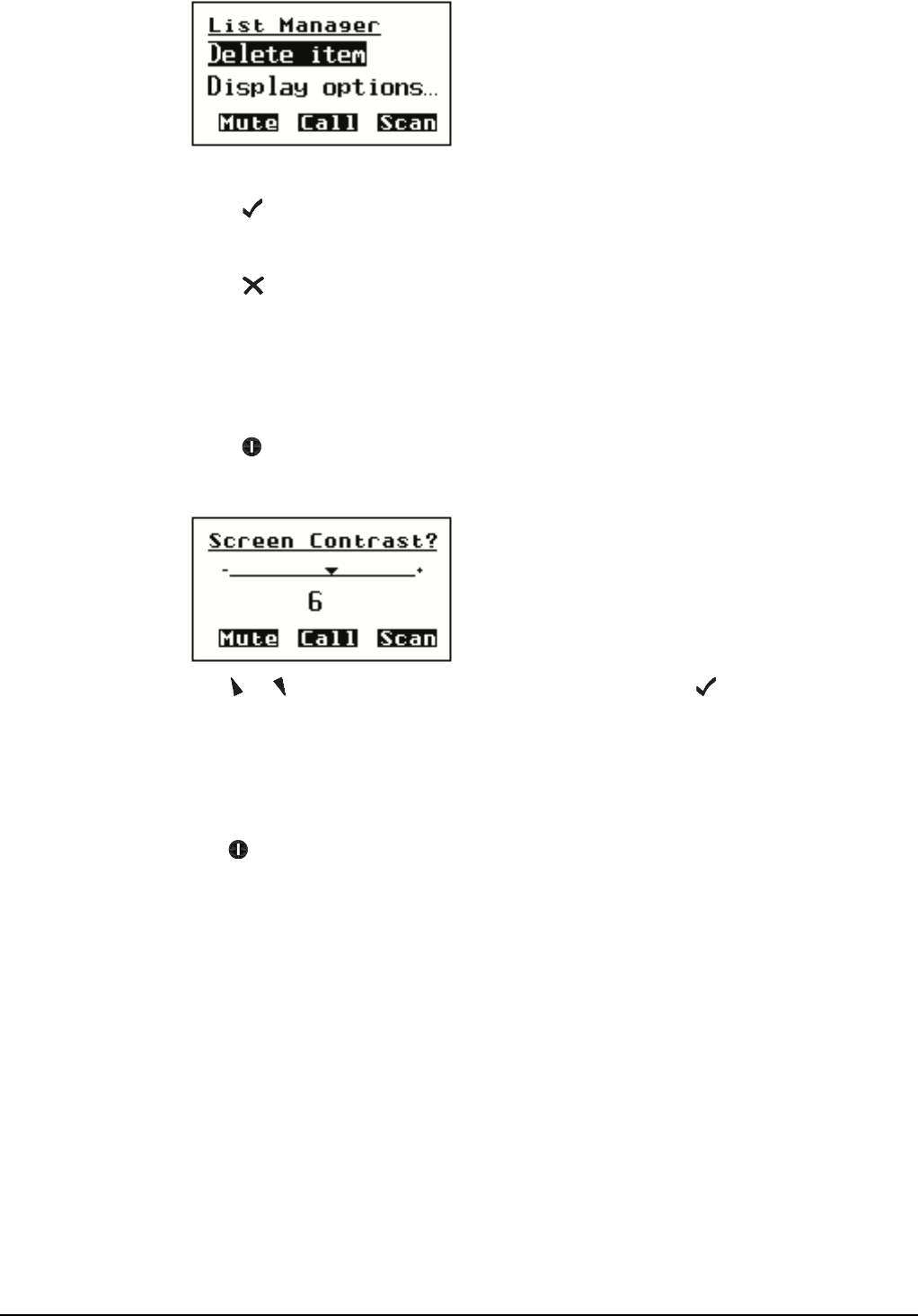
Operating the transceiver
74 2110 SSB Transceiver Reference Manual
The transceiver asks you to confirm that you want to delete the item.
1Press .
The item is deleted and the List Manager remains open.
1Press until Main Menu is displayed.
Changing the screen contrast
To change the contrast of the screen:
1Press + 9 to access the Screen Contrast entry in the Control List.
The Screen Contrast slider screen is displayed.
1Use or to increase or decrease the contrast, then press .
Changing the screen brightness
To change the brightness of the screen:
1Tap repeatedly to cycle through the screen brightness options.

Operating the transceiver
2110 SSB Transceiver Reference Manual 75
Using hot keys
Hot keys on the front panel are keys that perform special tasks in addition to their normal
functions. Table 5 on page 30 lists the standard hot keys on the front panel and the tasks
you can perform with them.
Generally, pressing the hot key a second time will exit from the hot key activity. For
example, pressing CLAR allows the clarifier to be edited. Pressing CLAR again exits
the editing mode and returns you to the screen from which you began.
To use a hot key on any of the front panel keys:
1Press the hot key.
The task is performed.
NOTE
If you want the user to be able to access an entry in the Control List so that
they can change the value, you should set up a hot key that accesses the
entry (see page 241, Creating a macro and assigning it to a hot key for
information on how to create hot keys).
NOTE
If the key can perform more than one hot key task, a list of the tasks is
displayed. Press the key repeatedly to scroll through the tasks. When
the task you want to perform is displayed, press .
NOTE Some keys may require you to select a value from a list or enter text
before the task is completed.

Operating the transceiver
76 2110 SSB Transceiver Reference Manual
Tuning the antenna
Automatic tuning
If the transceiver is connected to an automatic antenna, it tunes the antenna automatically
when required.
To tune the antenna when you select a channel:
1Select a channel in the Channel List (for help see page 51, Selecting a channel).
1Press then release PTT.
A message is displayed to inform you that tuning has begun, and the transceiver
makes a series of short beeps. Tuning typically takes 1–2 seconds.
If tuning fails, a message is displayed to inform you of this, and the transceiver
makes an error beep. You may need to manually tune the antenna (see page 77,
Manual tuning).
Removing the tuning message
To remove the tuning message before tuning is complete:
1Press .
The beeps will continue until tuning is complete.
Aborting automatic tuning
To abort automatic tuning:
1Press PTT.
A message is displayed to inform you that tuning has been aborted, and the
transceiver makes an error beep.
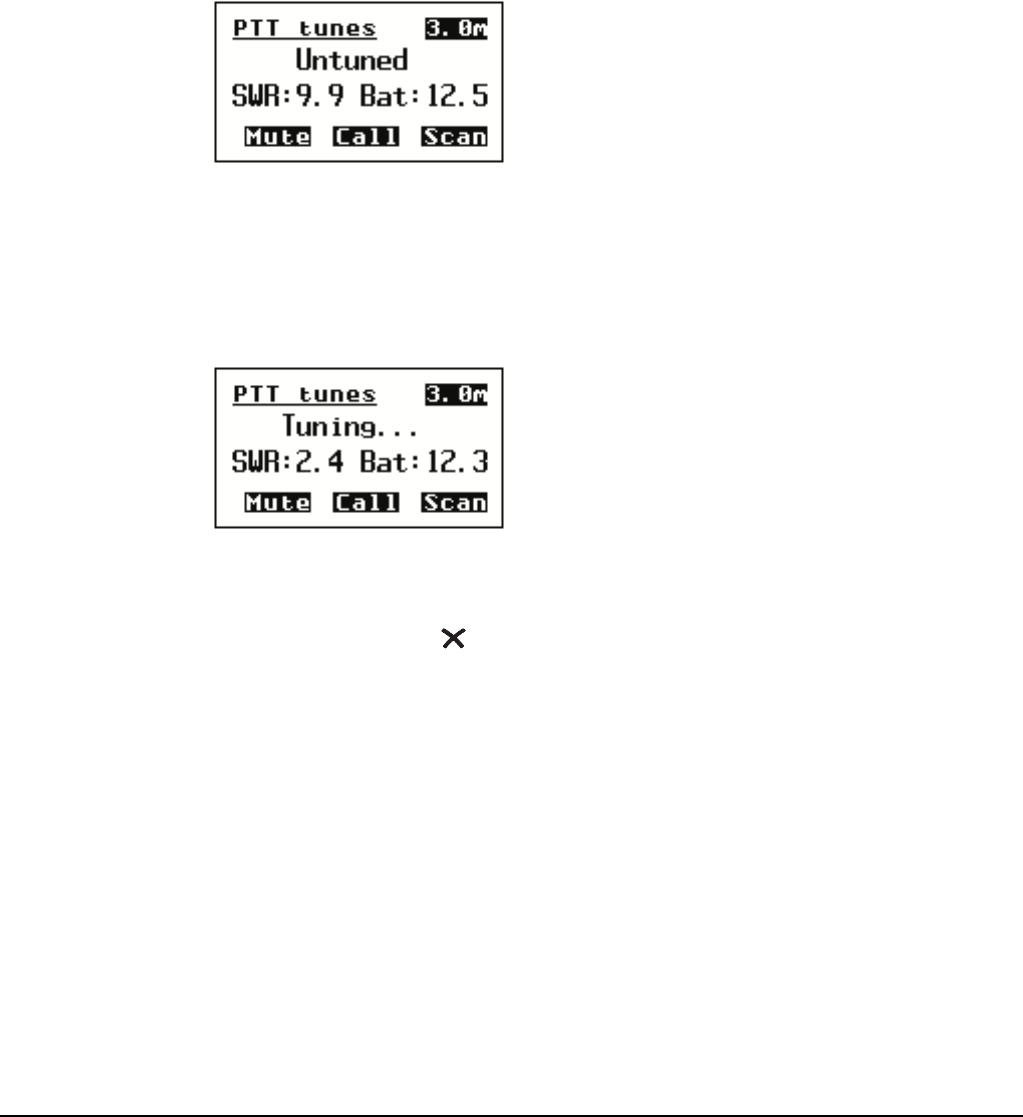
Operating the transceiver
2110 SSB Transceiver Reference Manual 77
Manual tuning
You may need to manually tune the antenna if you are receiving on a channel on which
you have not just transmitted, or if you want to check the SWR value for the antenna.
The transceiver will display whether it is Tuned or Untuned.
To manually tune the antenna:
1Press TUNE.
The PTT tunes screen is displayed with the SWR and battery voltage on the
bottom line. For example:
1Press PTT to tune the antenna.
Tuning... is displayed, and the transceiver makes a series of short beeps.
1Press PTT to stop tuning.
1Press TUNE to return to the screen from which you began.
NOTE If you do not press PTT within 30 seconds you are returned to the
screen from which you began.
NOTE
An SWR of less than 2.5:1 is acceptable.
If a message is displayed while you are tuning, you can remove it by
pressing .
If tuning continues for more than 2 minutes, tuning is automatically
aborted. The transceiver displays a message to inform you of this,
makes an error beep, and returns you to the screen from which you
began.
If tuning is unsuccessful, refer to the Quick Reference Card supplied
with the antenna.
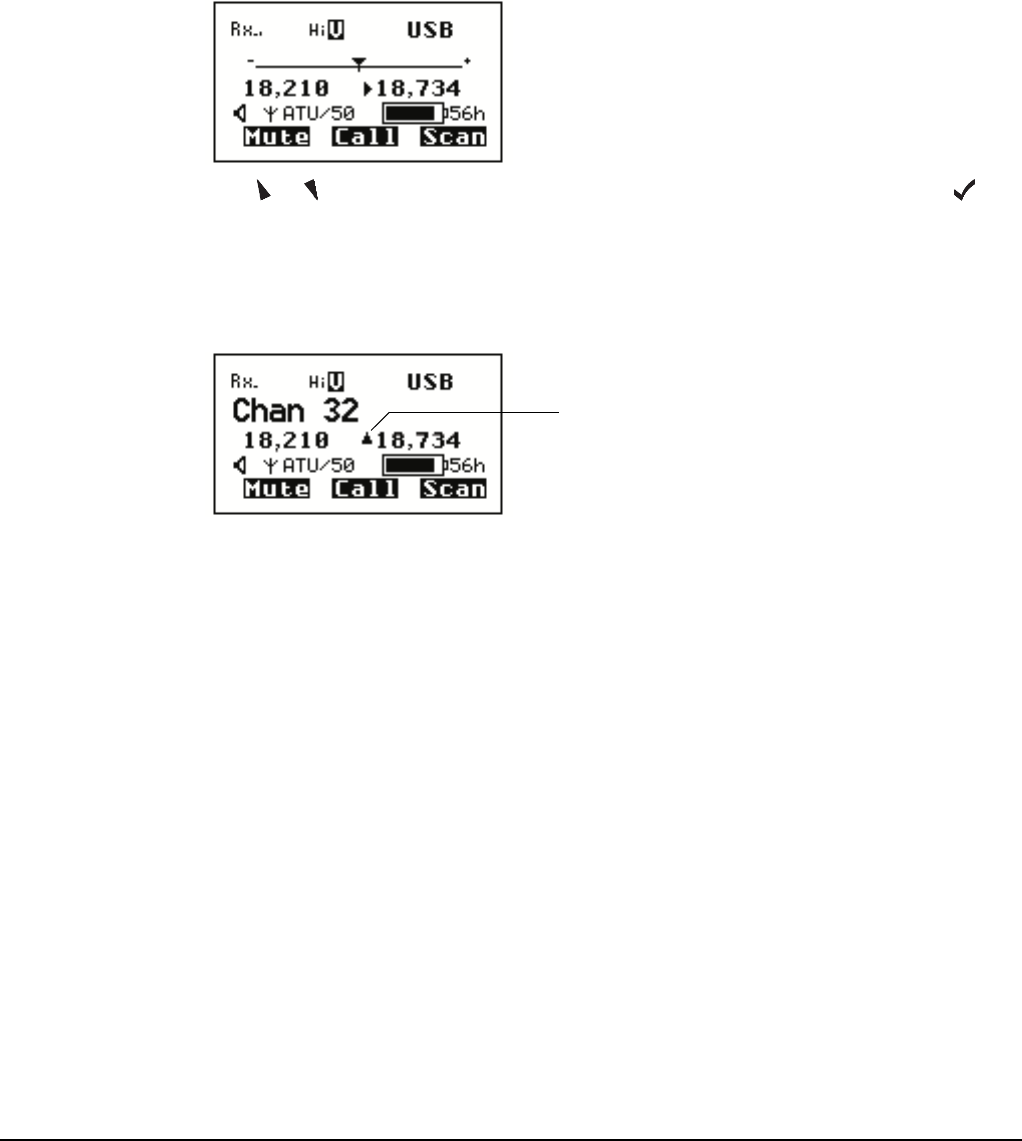
Operating the transceiver
78 2110 SSB Transceiver Reference Manual
Using the clarifier
The clarifier is a feature that enables you to adjust the receive frequency to compensate
for any frequency offset between your transceiver and the remote transceiver, thus
improving the quality of received voice.
To use the clarifier:
1Press CLAR.
The Clarifier slider is displayed in the channel screen.
1Use or to increase or decrease the pitch of the received voice, then press or
CLAR.
If you select a positive clarifier offset from the frequency, the Rx indicator changes
to an up arrow. If you select a negative clarifier offset from the frequency, the Rx
indicator changes to a down arrow. For example:
NOTE When you select another channel/mode the clarifier is reset to the
centre point.
arrow indicates positive clarifier
offset from 18734 kHz
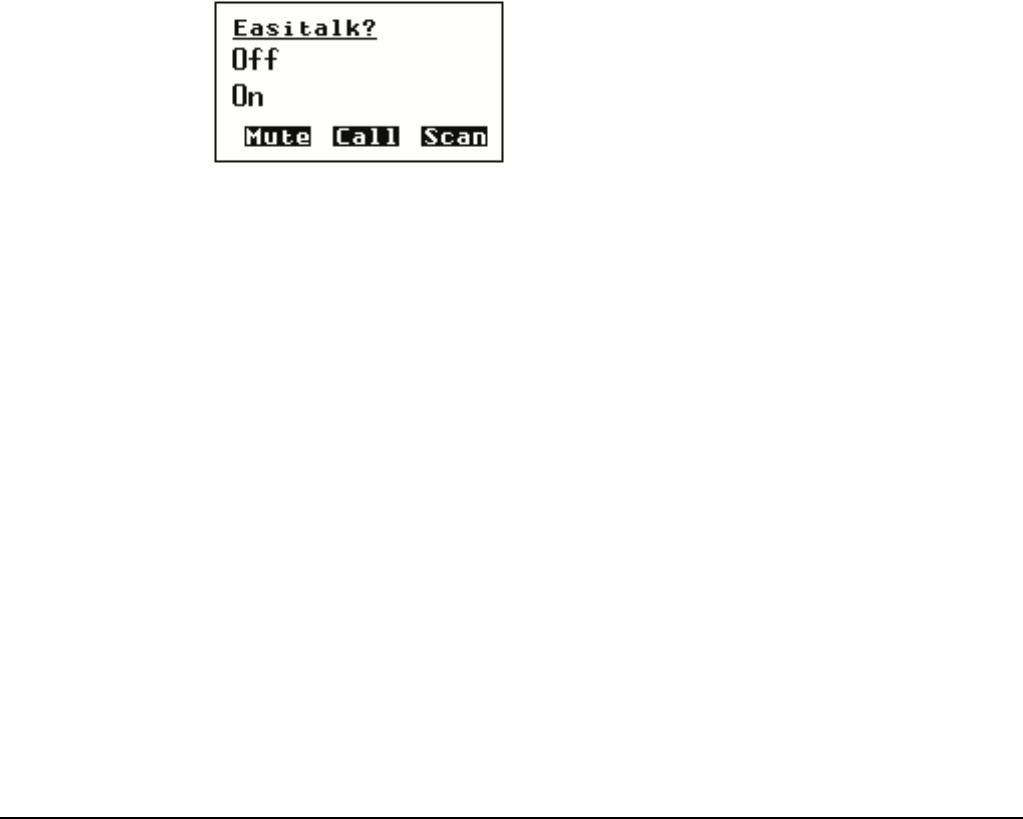
Operating the transceiver
2110 SSB Transceiver Reference Manual 79
Reducing background noise with Easitalk
The Easitalk feature enables you to reduce the level of background noise that is present
when you listen to a channel.
If Easitalk is on when the transceiver begins scanning, it is automatically switched off. It
is switched on again when scanning pauses or stops.
Switching Easitalk on or off
To switch Easitalk on or off:
1Press EASITALK.
The Easitalk entry in the Control List is displayed and the value is automatically
toggled on or off.
After about 2 seconds you are returned to the screen from which you began.
NOTE
Easitalk uses one of three DSP algorithms to reduce the background
noise. Depending on the conditions you may need to change the algorithm
in the Cfg Easitalk entry in the Control List. If you intend to change the
algorithm regularly, set up a hot key on the 5key to go to the next
algorithm value in the Cfg Easitalk entry in the Control List (see
page 331, Example 4: changing a value to the next value in a list).
NOTE Easitalk is not available if the Voice Encryptor feature is active.
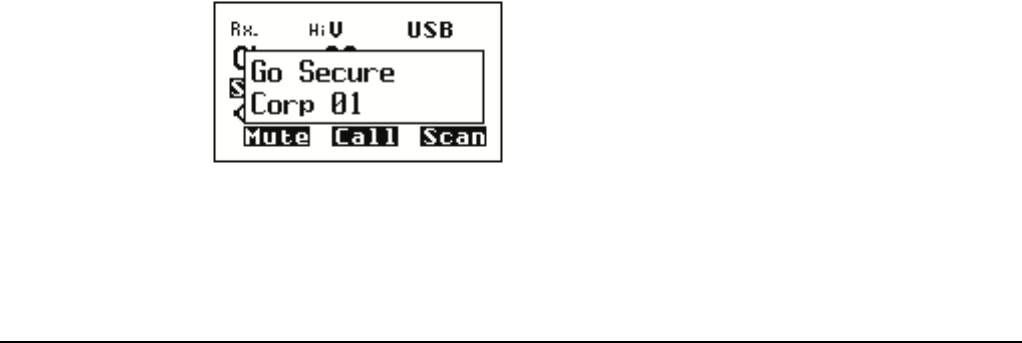
Operating the transceiver
80 2110 SSB Transceiver Reference Manual
Using the voice encryptor
The voice encryptor is an optional feature that provides high-grade security for voice
communications. This feature uses Secure Keys, Secure Modes, and PINs to provide
various levels of secure communications.
In order to communicate securely between two stations, both stations must use the same
Secure Key. The voice encryptor may be programmed with multiple Secure Keys, any
one of which may be selected. In addition to the Secure Keys, the voice encryptor
provides a PIN facility, which temporarily varies the level of security on the key for a
private session.
For secure communications within your organisation you need to set up a Corporate key
that is common to all transceivers in your organisation. If you need to have secure
communications with other organisations operating the same type of equipment as yours,
you can use the fixed Global key that is common to all voice encryptors shipped from the
factory. The Global key provides secure communications, however the security is less
than that provided by a Corporate key. The PIN facility may also be used with the Global
key to improve the level of security.
Using the voice encryptor
Using the voice encryptor
To use the voice encryptor:
1Press SCAN to switch off scanning.
1Press SEC.
The transceiver will respond with two high short beeps and displays Go Secure,
and the Secure Mode and Secure Key used. For example:
NOTE To use the voice encryptor, you must have the hardware option fitted, and
special firmware programmed into the transceiver and enabled.
NOTE
In the following discussion, you will need to log in as administrator to see
the entries in the Control List (see page 110, Logging into admin level
from user level).
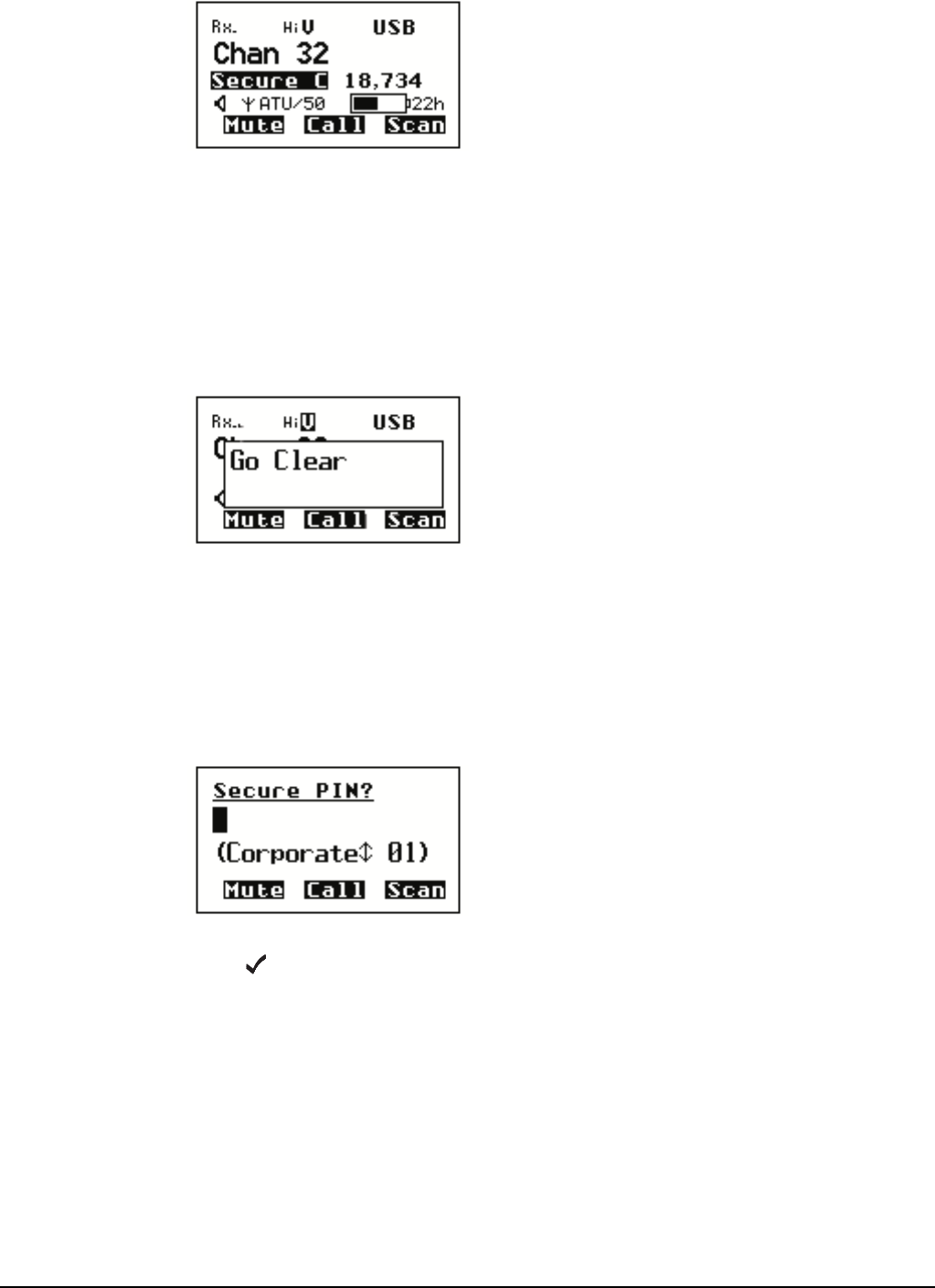
Operating the transceiver
2110 SSB Transceiver Reference Manual 81
If you are in the Channel List, the active voice encryptor is indicated by the word
Secure <C|G> highlighted at the left of the channel screen. For example:
Switching off the voice encryptor
To switch off the voice encryptor:
1Press SEC.
The transceiver will respond with two low short beeps and display Go Clear. For
example:
Using a PIN for additional security
To use the voice encryptor with a PIN:
1If you are not already using the voice encryptor, press SCAN to switch off scanning.
1Hold SEC to enter a PIN for the session.
1Enter the 4-digit PIN that you have agreed to use with others for this session, then
press .
CAUTION The PIN must be a number that both parties know and agree upon
without mentioning it over the air.
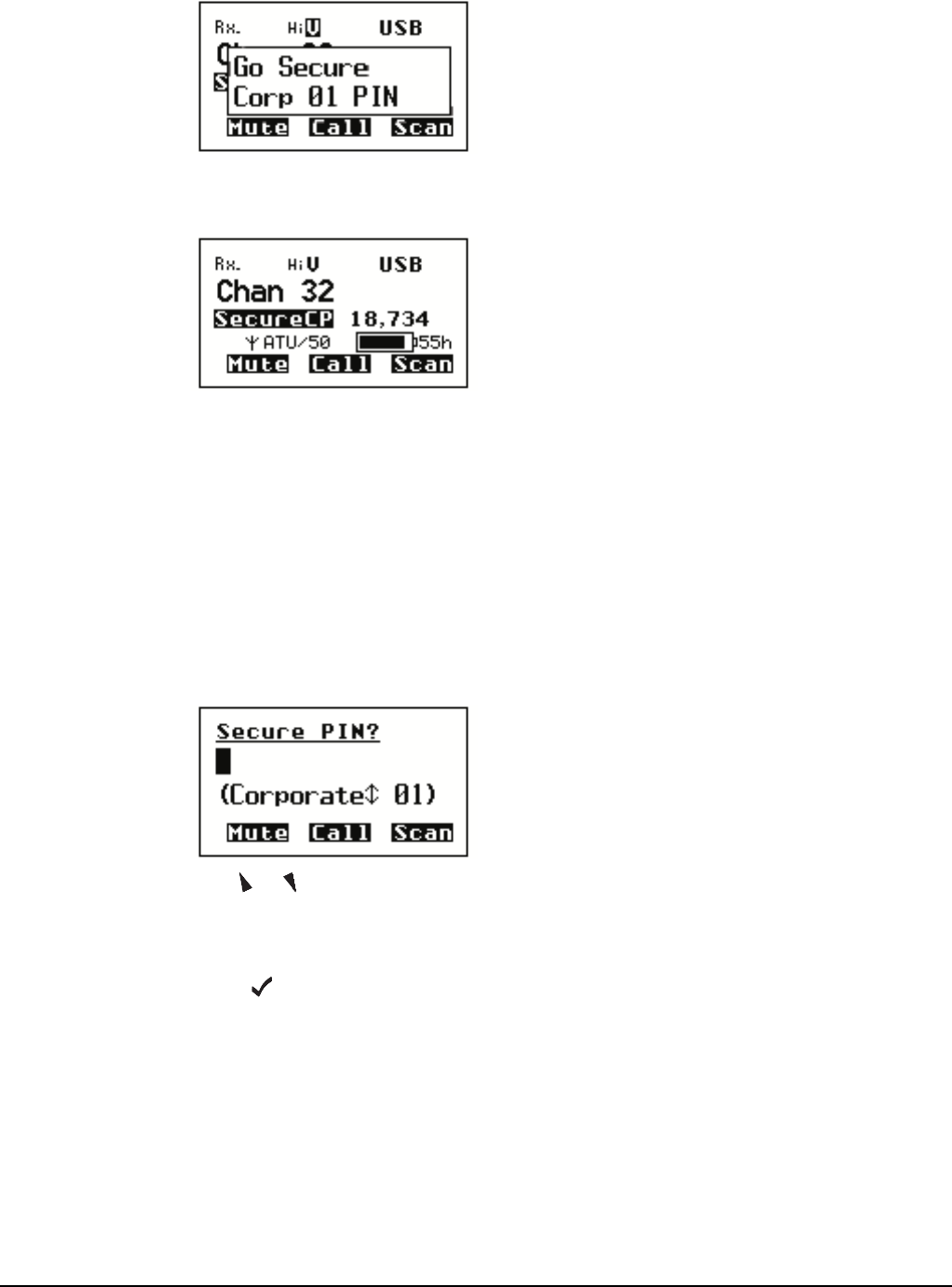
Operating the transceiver
82 2110 SSB Transceiver Reference Manual
The transceiver will respond with two high short beeps and displays Go Secure,
the Secure Mode and Secure Key used, and PIN to indicate that a PIN is in use. For
example:
If you are in the Channel List, the active voice encryptor is indicated by the word
Secure<C|G>P highlighted at the left of the channel screen. For example:
Switching between Global and Corporate Modes
Whenever you switch on the voice encryptor it will enter the mode that is set in the
Secure Mode entry in the Control List. For help on setting the default Secure Mode see
page 96, Changing a setting in the Control List and page 200, Entries in the Control List.
To switch between the Global and Corporate Modes while using the voice encryptor:
1Hold SEC.
1Use or to toggle between Global and Corporate.
1If you want to use a PIN, enter the 4-digit PIN that you have agreed to use with
others for this session.
1Press .
NOTE The default Secure Mode is not changed. Next time you switch on the
voice encryptor, the default mode will be entered.
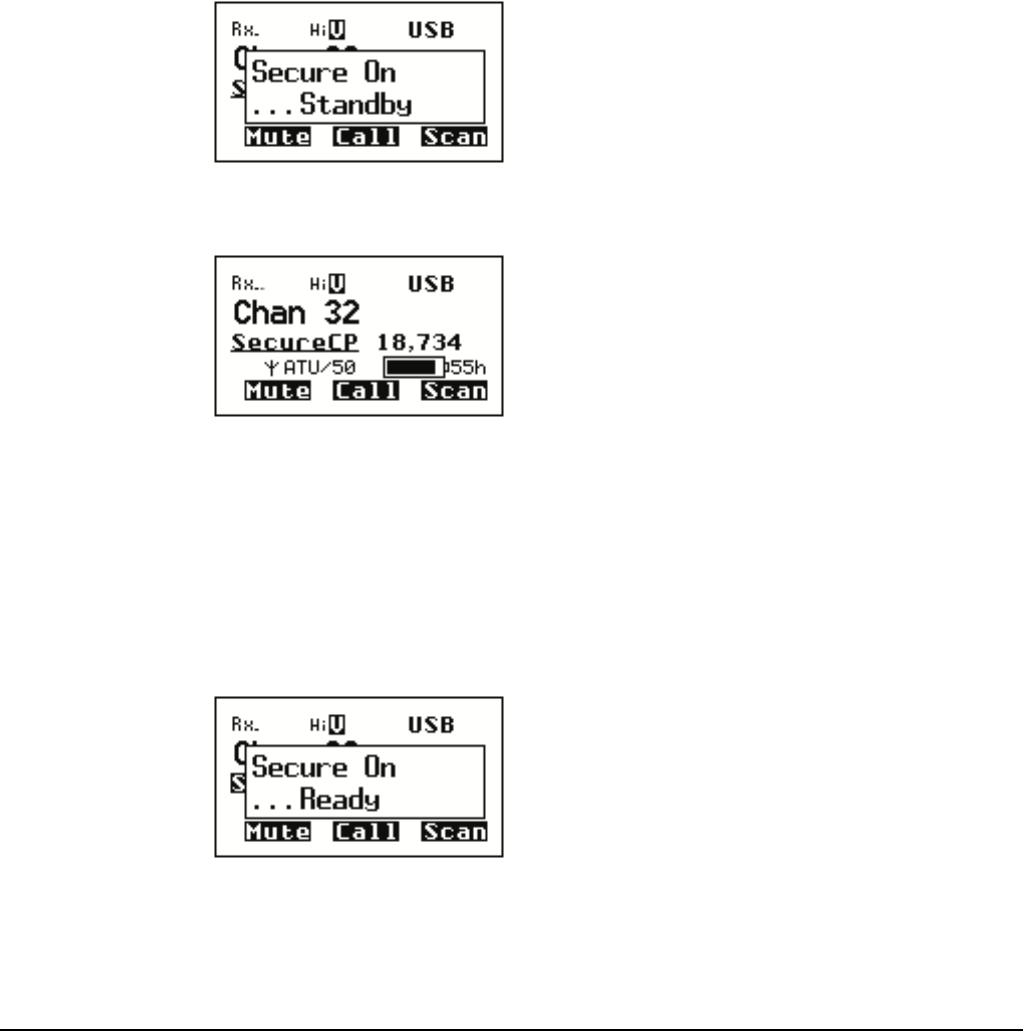
Operating the transceiver
2110 SSB Transceiver Reference Manual 83
Using the voice encryptor in Standby Mode
When the voice encryptor is switched on you will hear all transmissions and noise on the
selected channel. If you want to hear just the voice and encrypted transmissions you can
enter the Standby Mode and switch on Voice mute. The transceiver will open mute when
it detects a voice signal on the channel. When an encrypted transmission is received, the
transceiver switches from Standby Mode to Secure Mode and the decrypted audio is
heard.
To enter Standby Mode:
1Switch on the voice encryptor.
1Press *.
The voice encryptor switches to Standby Mode.
If you are in the Channel List, the standby voice encryptor is indicated by the word
SecureXX underlined at the left of the channel screen. For example:
To exit Standby Mode:
1Press *.
The voice encryptor switches from Standby Mode.
NOTE The transceiver will automatically switch from Standby Mode to
Secure Mode if an encrypted transmission is received.

Operating the transceiver
84 2110 SSB Transceiver Reference Manual
Setting up the voice encryptor
Setting the Corporate key in an index
To set the Corporate key:
1Press until Main Menu is displayed.
1Scroll to Control, then press .
1Scroll to Secure Key, then hold .
1Enter an 8-digit key that will be used for your organisation, then press .
1Scroll to Index, then hold .
1Scroll to Index 1, then press .
1Press until Main Menu is displayed.
Setting up the voice encryptor for basic security use
To set up the voice encryptor:
1Set up the Corporate key, if required (see above Setting the Corporate key in an
index).
1Scroll to Control, then press .
1Scroll to Secure Mode, then hold .
1Scroll to Corporate, then press .
1Lock and hide the Secure Mode entry in the Control List (see page 115, Locking and
unlocking information and page 113, Hiding and showing information).
1If you want your users to be able to use a PIN, enable the PIN mode (see page 344,
Restricting access to Voice Encryptor features). Otherwise, disable the PIN mode.
NOTE
In the following discussion, you will need to log in as administrator to see
the entries in the Control List (see page 110, Logging into admin level
from user level).
NOTE Scroll to the entry or use the Find feature (for help see page 64,
Finding words and values).
NOTE If you need to program Index 2 or above with a secure key, you must
use CICS (see page 278, secure command).
NOTE Scroll to the entry or use the Find feature (for help see page 64,
Finding words and values).

Operating the transceiver
2110 SSB Transceiver Reference Manual 85
Setting up the voice encryptor for advanced security use
To set up the voice encryptor:
1Set up the Corporate key, if required (see page 84, Setting the Corporate key in an
index).
1Set up a hot key to access the Secure Index entry in the Control List so that the
current Secure Index, as designated by the organisation, can be selected (see
page 330, Example 3: displaying and/or changing a setting in the Control List).
1Scroll to Control, then press .
1Scroll to Secure Mode, then hold .
1Scroll to Corporate, then press .
1Program multiple Corporate keys via CICS (see page 278, secure command).
1If you want to change the base of all Corporate keys, modify the base key (Index 0)
via CICS (see page 278, secure command).
1If you want to alter the encryption algorithm contact your Codan representative.

Operating the transceiver
86 2110 SSB Transceiver Reference Manual
This page has been left blank intentionally.

2110 SSB Transceiver Reference Manual 87
CODAN
7 Using lists
This section contains the following topics:
The Main Menu (88)
Selecting a list (90)
The List Manager (91)
Setting a marker (94)
Setting the home screen (95)
Changing a setting in the Control List (96)
Making changes to all other lists (97)
Hiding and showing settings (101)
Grouping and ungrouping entries (103)
Restricting access to information (108)
Logging into admin level (110)
Displaying full and normal view (112)
Hiding and showing information (113)
Locking and unlocking information (115)

Using lists
88 2110 SSB Transceiver Reference Manual
The Main Menu
All the details required to operate the transceiver, such as the self address of your station
and the channels and networks you use, are stored in lists. Each list relates to a particular
area of the transceiver’s operation. The lists that are displayed in the Main Menu are:
• the Address List, which stores the details of stations you often call
• the Channel List, which stores the details of the channels you use
• the Control List, which stores the settings that control the way the transceiver
operates, for example, the brightness and contrast of the front panel screen, the time
and date, passwords, and your station self address
• the NET List, which stores information about the NETS that you use, whether or not
you are a member of these NETs, and the networks used with each NET
• the Network List, which stores information about the networks you use and the
channels used in each network
• the Phone Link List, which stores the details of telecommunication stations you
contact to make telephone calls from the transceiver
The lists are displayed in the Main Menu without the word ‘list’ after them.
Figure 17: The contents of the Main Menu
Entries, settings and values
Each list contains entries. The entries in the Address List are the names of the stations
you often call, for example, ‘Home’, ‘Work’. The entries in the Channel List are the
names of the channels you use, for example, ‘Channel 1’, ‘Channel 2’.
You can add entries to each list except the Control List.
Each entry has one or more settings. For example, the entries in the Channel List are the
channels that you use, and each entry has a setting for the receive and transmit
frequencies, and the modes that can be used with the channel.
Each setting has a value. For example, the value for the Receive freq setting in the
Channel List is the receive frequency of the channel in kilohertz.
NOTE In the following discussion, you will need to log in as administrator to see
the Main Menu (see page 110, Logging into admin level from user level).
Main Menu
Address
Channel
Control
Network
NET
Phone Link

Using lists
2110 SSB Transceiver Reference Manual 89
Figure 18: Examples of entries, settings and values
Main Menu
Address
Channel
Control
Network
NET
Channel 1
Channel 2
Channel 3
entries
Receive freq
Modes...
Receive freq
Modes...
Receive freq
Modes...
settings
Transmit freq
Transmit freq
Transmit freq
15 000 kHz
Disabled
USB, LSB
8 734 kHz
8 210 kHz
USB
values
4 010 kHz
4 010 kHz
USB
Phone Link
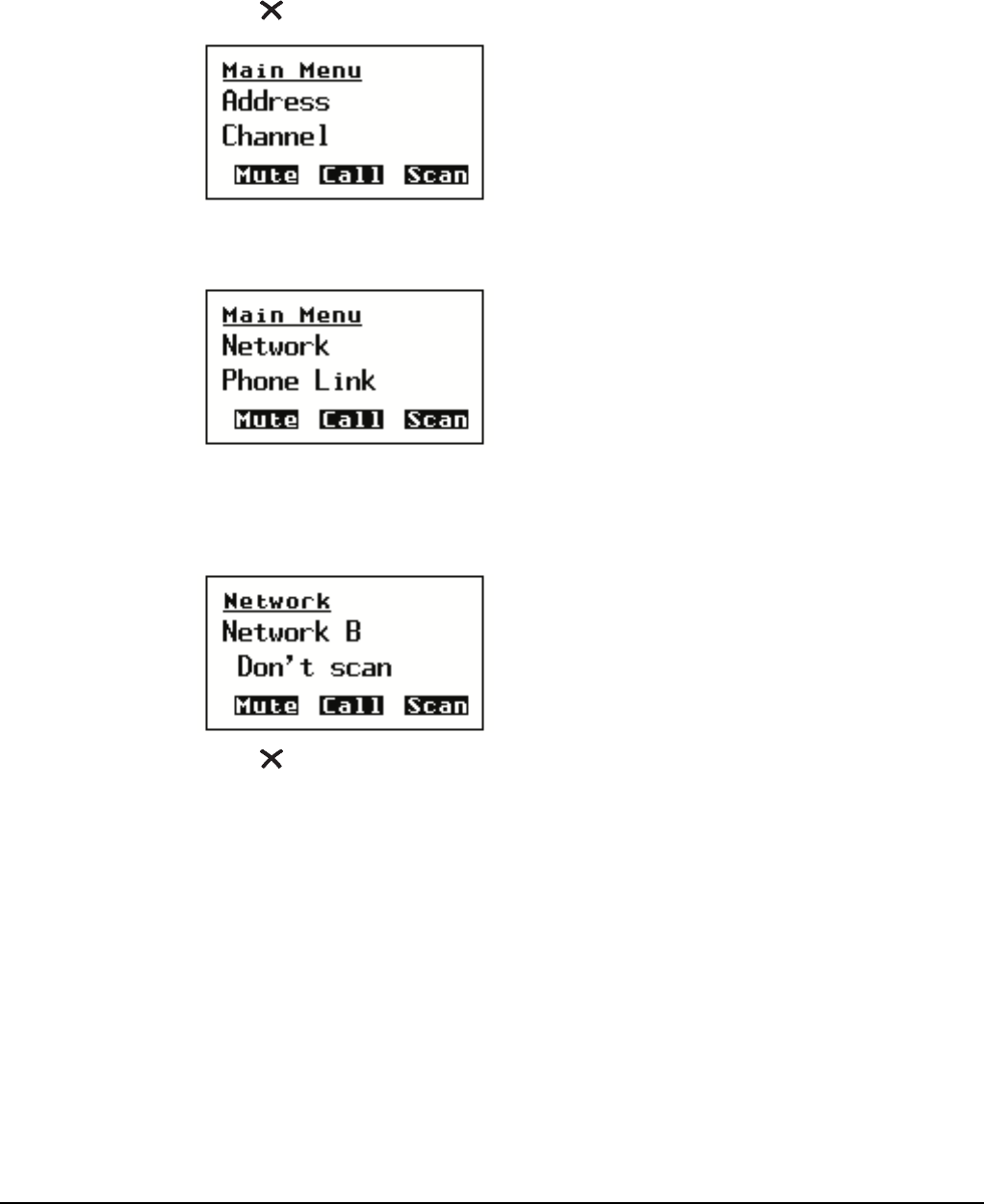
Using lists
90 2110 SSB Transceiver Reference Manual
Selecting a list
To select a list from the Main Menu:
1Press until Main Menu is displayed.
1Scroll through the Main Menu until the list you want to select is displayed on the
active (middle) line. For example:
1Select the list.
The name of the list is displayed on the top line and the first entry is displayed on the
active line. You can now scroll through the entries.
1Press until Main Menu is displayed.
NOTE In the following example, you will need to log in as administrator to see
the Main Menu (see page 110, Logging into admin level from user level).

Using lists
2110 SSB Transceiver Reference Manual 91
The List Manager
The List Manager is a collection of tools that enable you to perform various tasks on
lists, entries and settings. These tasks include:
• creating, copying, renaming and deleting entries
• setting the home screen
• changing the way lists, entries and settings are displayed
• preventing information from being edited and/or displayed (hiding and locking)
• creating macros and hot keys
• logging in as an administrator
The tools in the List Manager are displayed as entries. You can scroll through them and
select them the same way you scroll through entries in lists. The entries in the List
Manager vary according to the list, entry or setting you were on when you opened it:
only entries relevant to that item are displayed. Table 13 on page 92 lists the entries in
the List Manager and their functions.
Using the List Manager
The entries in the List Manager are covered in detail in this section. However, the basic
steps for using them are the same.
To use an entry in the List Manager:
1Go to the list, entry or setting in which you want to use the List Manager.
1Hold to open the List Manager.
If Quick Start is enabled, scroll to Advanced..., then press .
1Scroll through the entries until the one you want to select is displayed on the active
line (see Table 13 on page 92).
1Press .
When the task is completed, the List Manager remains open.

Using lists
92 2110 SSB Transceiver Reference Manual
Entries in the List Manager
Table 13: List Manager entries and their functions
Entry Enables you to...
Create entry Create an entry in a list.
Copy entry Copy an entry in a list.
Rename entry Rename an entry in a list.
Delete entry Delete an entry in a list.
Set marker Set a marker on an entry in a list so that the next time you open the
list, it is opened to this entry.
Add item Add:
• a mode to a channel in the Channel List
• a channel/mode to a network in the Network List
• your station self addresses to the Address entry in the Control
List
Delete item Delete:
• a mode from a channel in the Channel List
• a channel/mode from a network in the Network List
• your station self addresses from the Address entry in the Control
List
• a macro from a key in the Keypad List
Display
options...
Group entries? Group entries in a list.
Ungroup
entries?
Ungroup entries in a list.
Show settings? Display the first setting of an entry under the name of the entry.
Hide settings? Display the next item in a list under the name of an entry.
Full view? Show the lock and hide icons at the top right of the screen and display
entries marked as hidden.
Normal view? Remove the lock and hide icons at the top right of the screen and hide
entries marked as hidden.

Using lists
2110 SSB Transceiver Reference Manual 93
Macros... Create macro Create a macro.
Copy macro Copy a macro.
Move macro Move a macro from one key to another, or from one position to
another on the same key.
Add to macro Create a macro then add it to the end of an existing macro.
Join macros Join two existing macros.
Rename macro Rename a macro.
Delete macro Delete a macro.
Config... Set home screen Set the home screen.
Lock? Prevent users from editing lists, entries and settings by locking items
at user level.
Unlock? Unlock lists, entries and settings that have been locked at user level.
Hide? Prevent users from displaying lists, entries and settings in normal
view by hiding items at user level.
Show? Display lists, entries and settings in normal view that have been
hidden at user level.
Locks off? Switch off all locks set at user level until the Locks on? entry is used,
or the transceiver is switched off then on again.
Locks on? Switch on all locks set at user level.
Admin login Gain access to the Admin... group of entries in the List Manager.
Built-in Test Select test? Select a built-in test from a range of automatic, startup and user tests.
Admin... Admin lock? Prevent users from editing lists, entries and settings by locking items
at admin level.
Admin unlock? Unlock lists, entries and settings locked at admin level.
Admin hide? Prevent users from displaying lists entries and settings by hiding
items at admin level.
Admin show? Display lists, entries and settings hidden at admin level.
Locks off? Switch off all locks set at admin level until the Admin... Locks on?
entry is used, or the transceiver is switched off then on again.
Locks on? Switch on all locks set at admin level.
Admin logout? Log out of admin level.
NOTE The Admin... group of entries enables the administrator to restrict user
access to information configured in the transceiver.
Table 13: List Manager entries and their functions (cont.)
Entry Enables you to...

Using lists
94 2110 SSB Transceiver Reference Manual
Setting a marker
Markers are like bookmarks: if you want to display a particular entry each time you open
a list, set a marker on that entry. This saves your having to scroll to the entry each time
you want to use it. For example, if you often use a particular entry in the Address List,
set a marker on that entry so that each time you open the Address List the entry is
displayed.
To set a marker:
1Go to the list or entry on which you want to set a marker.
1Hold to open the List Manager.
1Select Set marker.
The marker is set and the List Manager closes.
NOTE
To move a marker to another entry repeat the steps above.
If you want a list to open at the first entry, set the marker on the first entry
in the list.
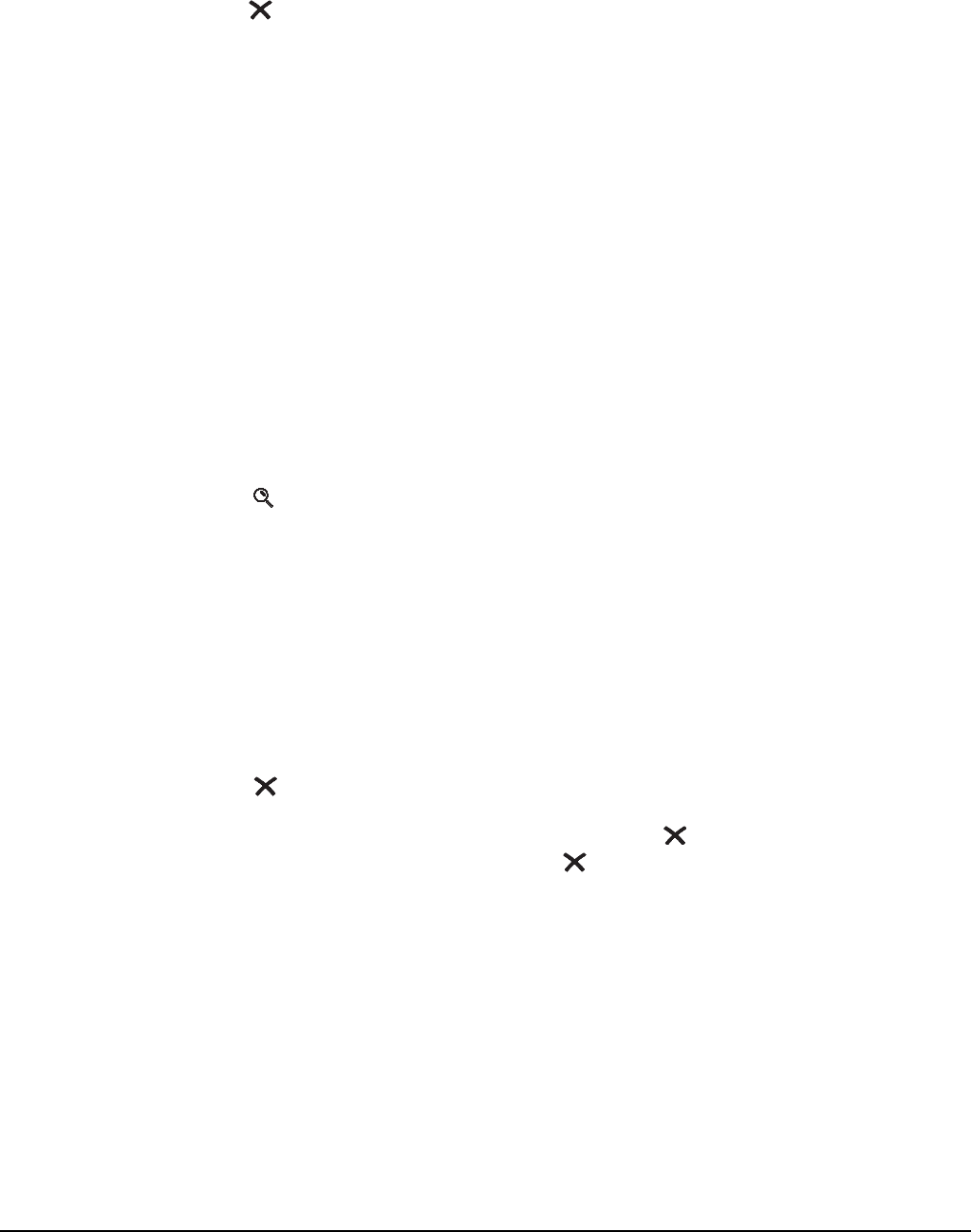
Using lists
2110 SSB Transceiver Reference Manual 95
Setting the home screen
The home screen is the screen that can be displayed quickly, regardless of the list you
happen to be in. It is displayed after you:
• switch the transceiver on
•hold from any location
The default home screen is the Channel List but almost any screen can be used as a home
screen. If you want to see the current time, make the time screen the home screen.
When you set the home screen, values are not recorded. For example, if you make the
Channel List the home screen, it displays the currently selected channel, not the channel
that was selected when you set the home screen.
Setting the home screen
To set the home screen:
1Go to the screen you want to make the home screen.
1Hold to open the List Manager.
1Select Config...
1Select Set home screen.
The home screen is set and the List Manager remains open.
Displaying the home screen
To display the home screen from any location:
1Hold .
1To return to the channel screen, press VIEW.
NOTE
If you want to make a screen in the Control List the home screen, you
will need to log in as administrator to see the Control List (see
page 110, Logging into admin level from user level).
NOTE If you are editing a setting, holding will cancel your changes and
exit the setting. Holding again will display the home screen.
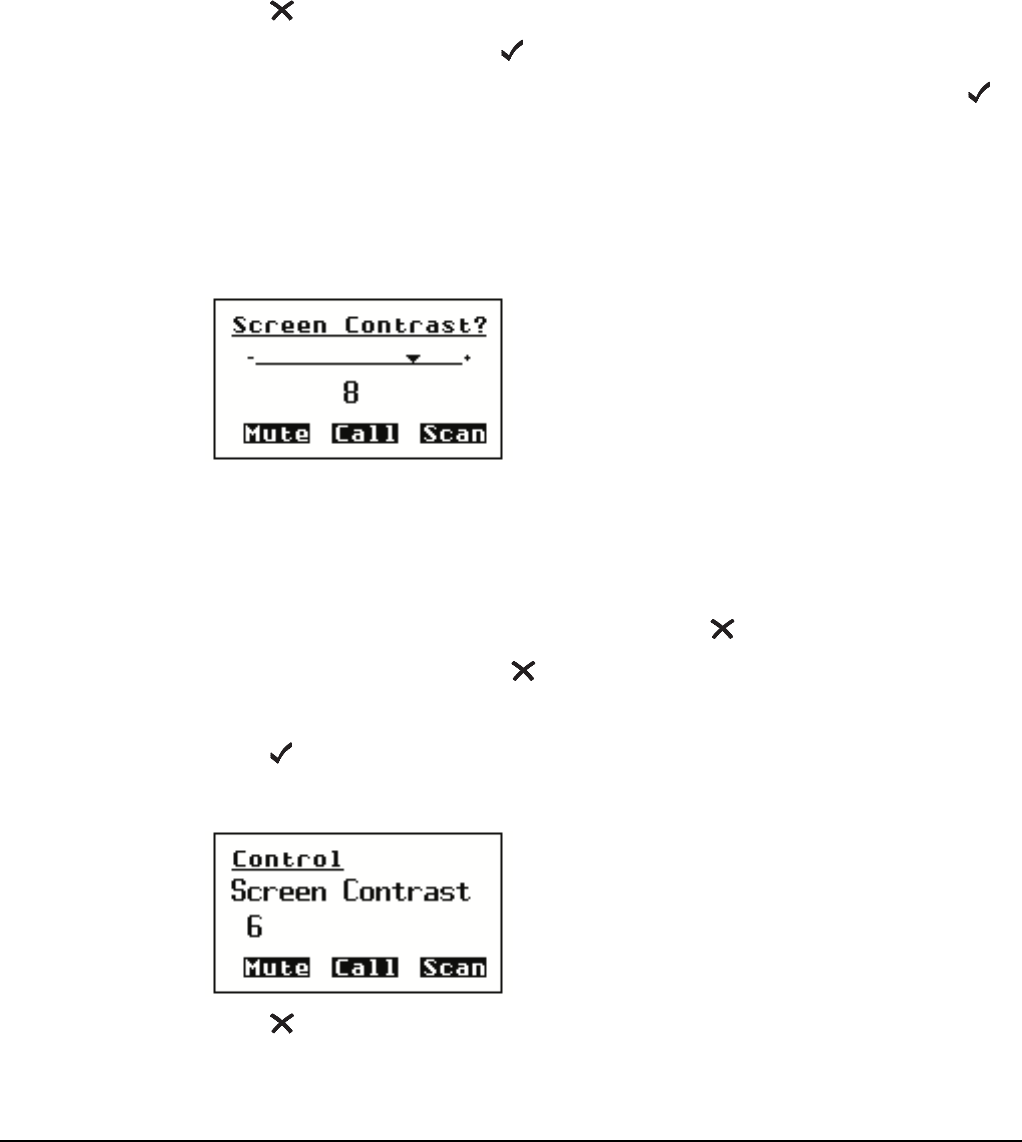
Using lists
96 2110 SSB Transceiver Reference Manual
Changing a setting in the Control List
Most of the entries in the Control List contain a single setting. The steps in this section
show you how to change these settings. The Address entry, which contains multiple
settings, is covered on page 69, Entering your station self address.
To change a setting in the Control List:
1Press until Main Menu is displayed.
1Scroll to Control, then press .
1Scroll to the entry in which the setting you want to change is stored, then hold .
A question mark is displayed at the end of the heading to show that you can now edit
the setting. For example:
1Scroll to the value you want (if it is a slider screen or a list) or enter text (for help see
page 52, Entering and editing text).
If you do not want to save the change you made and you are in a setting where you
can:
• select a value from a list or slider screen, press or PTT
• enter and delete text, hold or press PTT
The change is discarded and the setting is closed.
1Press .
The question mark is removed.
1Press until Main Menu is displayed.
NOTE In the following example, you will need to log in as administrator to see
the Control List (see page 110, Logging into admin level from user level).
NOTE Scroll to the entry or use the Find feature (for help see page 64,
Finding words and values).
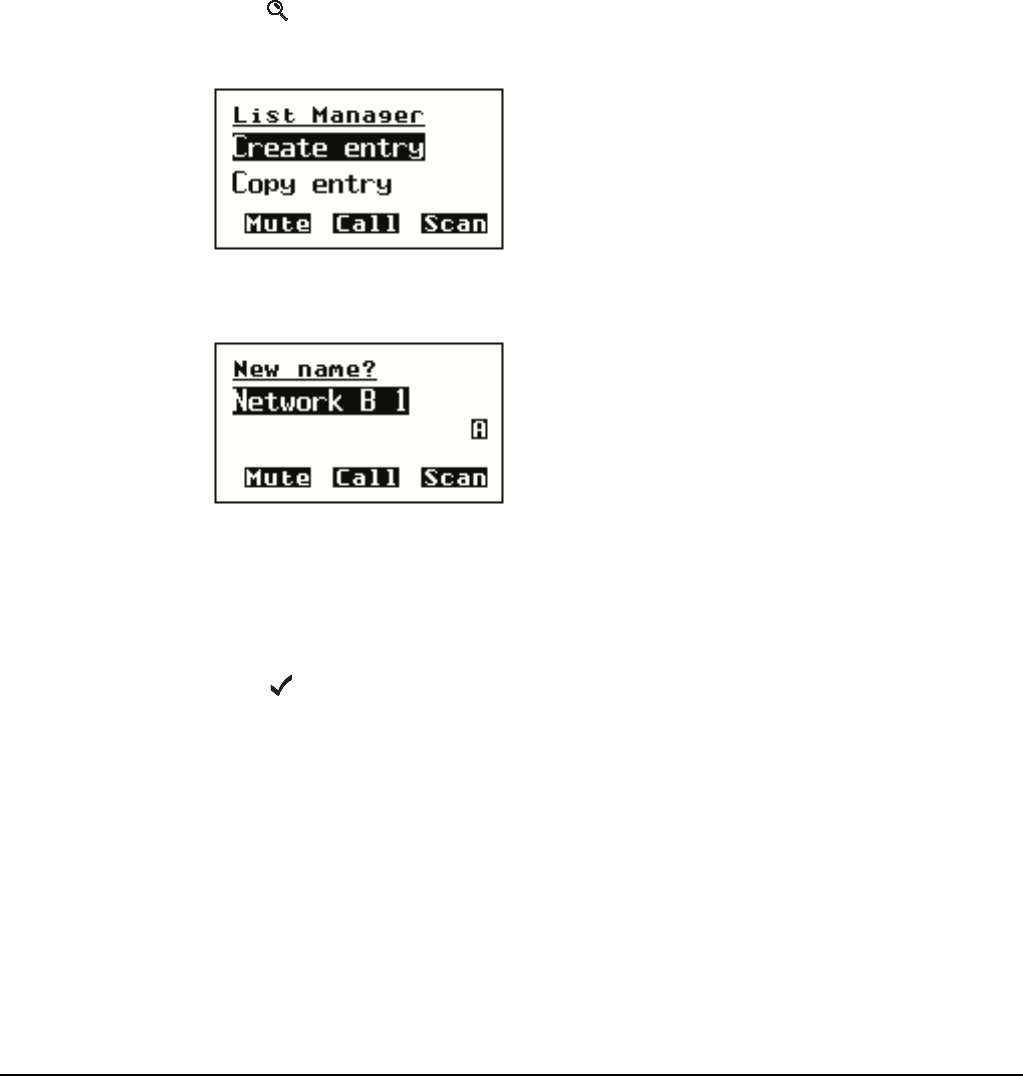
Using lists
2110 SSB Transceiver Reference Manual 97
Making changes to all other lists
The following steps can be used to make changes in every list except the Control List
(see page 96, Changing a setting in the Control List).
Creating an entry in a list
To create an entry in a list:
1Select the list in which you want to create an entry.
1Hold to open the List Manager.
1Select Create entry.
The transceiver suggests a name for the new entry based on the name of the entry
you were on. For example:
1Enter the name that you want to use for the new entry.
The name must be unique to the list that you are in.
1Press .
The transceiver will prompt you to enter settings for the entry.
NOTE In the following examples, you will need to log in as administrator to see
the lists (see page 110, Logging into admin level from user level).
NOTE For help with entering text see page 52, Entering and editing text.
For information on settings in the... See...
Channel List page 118
Network List page 123
NET List page 134
Phone Link List page 142
Address List page 147
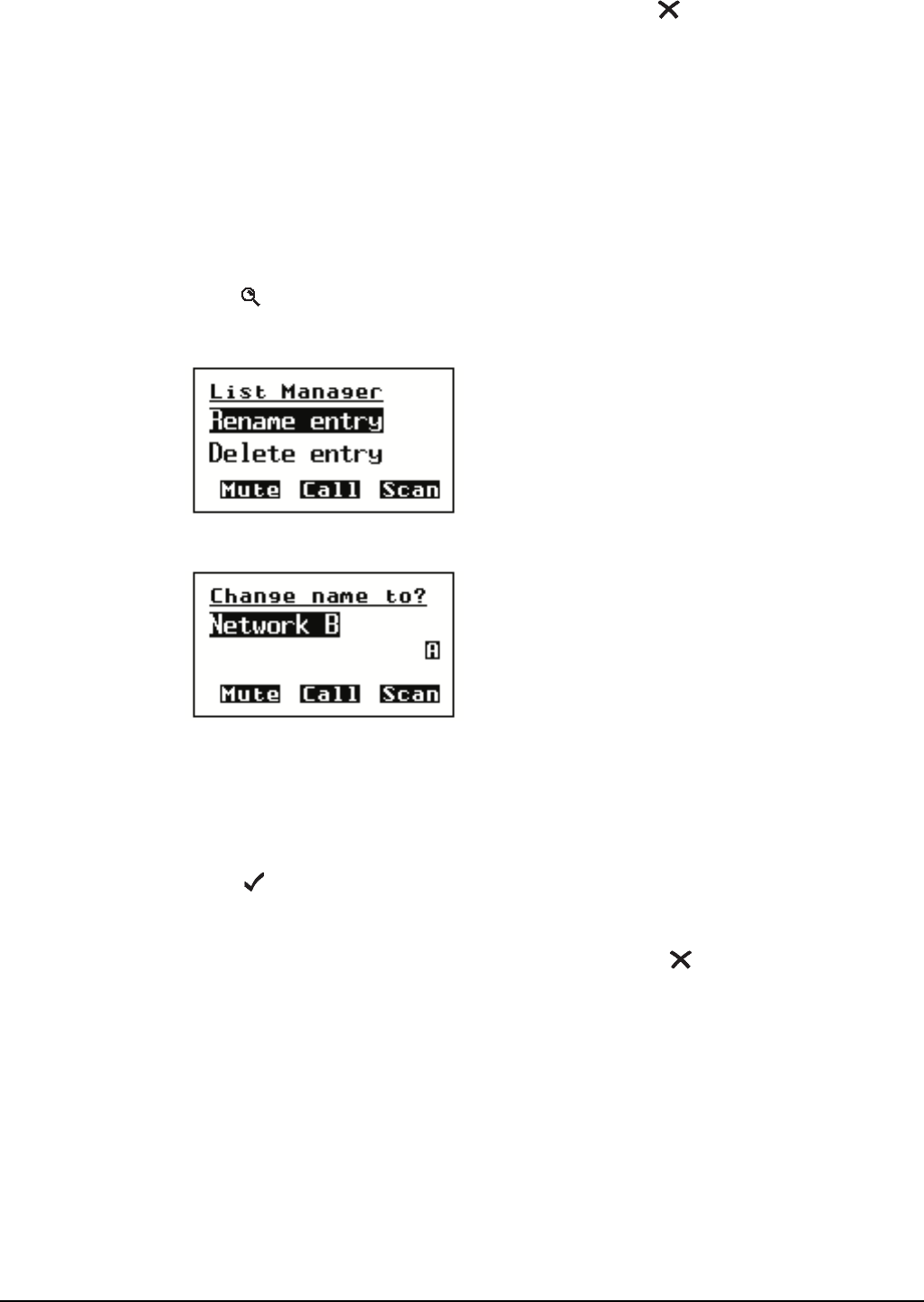
Using lists
98 2110 SSB Transceiver Reference Manual
The new entry is created and the List Manager remains open.
1If you want to view the entry you have created, press to close the List Manager.
Renaming an entry in a list
To rename an entry in a list:
1Go to the entry you want to rename.
1Hold to open the List Manager.
1Select Rename entry.
The transceiver displays the existing name of the entry for editing.
1Enter the new name that you want to use for this entry.
The name must be unique to the list that you are in.
1Press .
The entry is renamed and the List Manager remains open.
1If you want to view the entry you have renamed, press to close the List Manager.
NOTE Scroll to the entry or use the Find feature (for help see page 64,
Finding words and values).
NOTE For help with entering text see page 52, Entering and editing text.
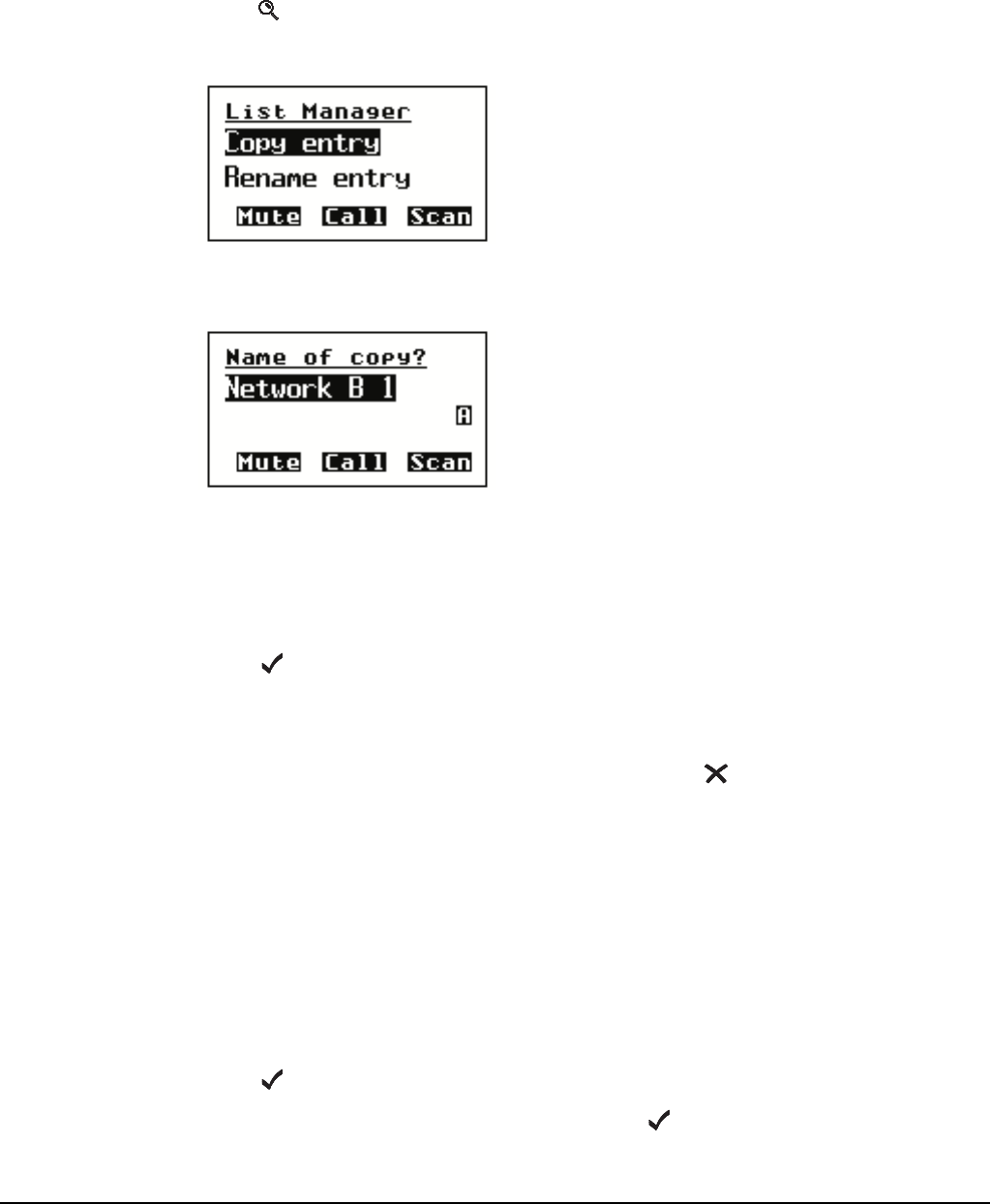
Using lists
2110 SSB Transceiver Reference Manual 99
Copying an entry in a list
To copy an entry in a list:
1Go to the entry you want to copy.
1Hold to open the List Manager.
1Select Copy entry.
The transceiver suggests a name for the new entry based on the name of the entry
you were on.
1Enter the name that you want to use for the copy of this entry.
The name must be unique to the list that you are in.
1Press .
A copy of the original entry, with the new name, is created and the List Manager
remains open.
1If you want to view the entry you have created, press to close the List Manager.
Editing an entry in a list
To edit an entry in a list:
1Go to the entry you want to edit.
1Press to view the settings for the entry.
1Scroll to the setting you want to edit, then hold .
NOTE Scroll to the entry or use the Find feature (for help see page 64,
Finding words and values).
NOTE For help with entering text see page 52, Entering and editing text.
NOTE Scroll to the entry or use the Find feature (for help see page 64,
Finding words and values).
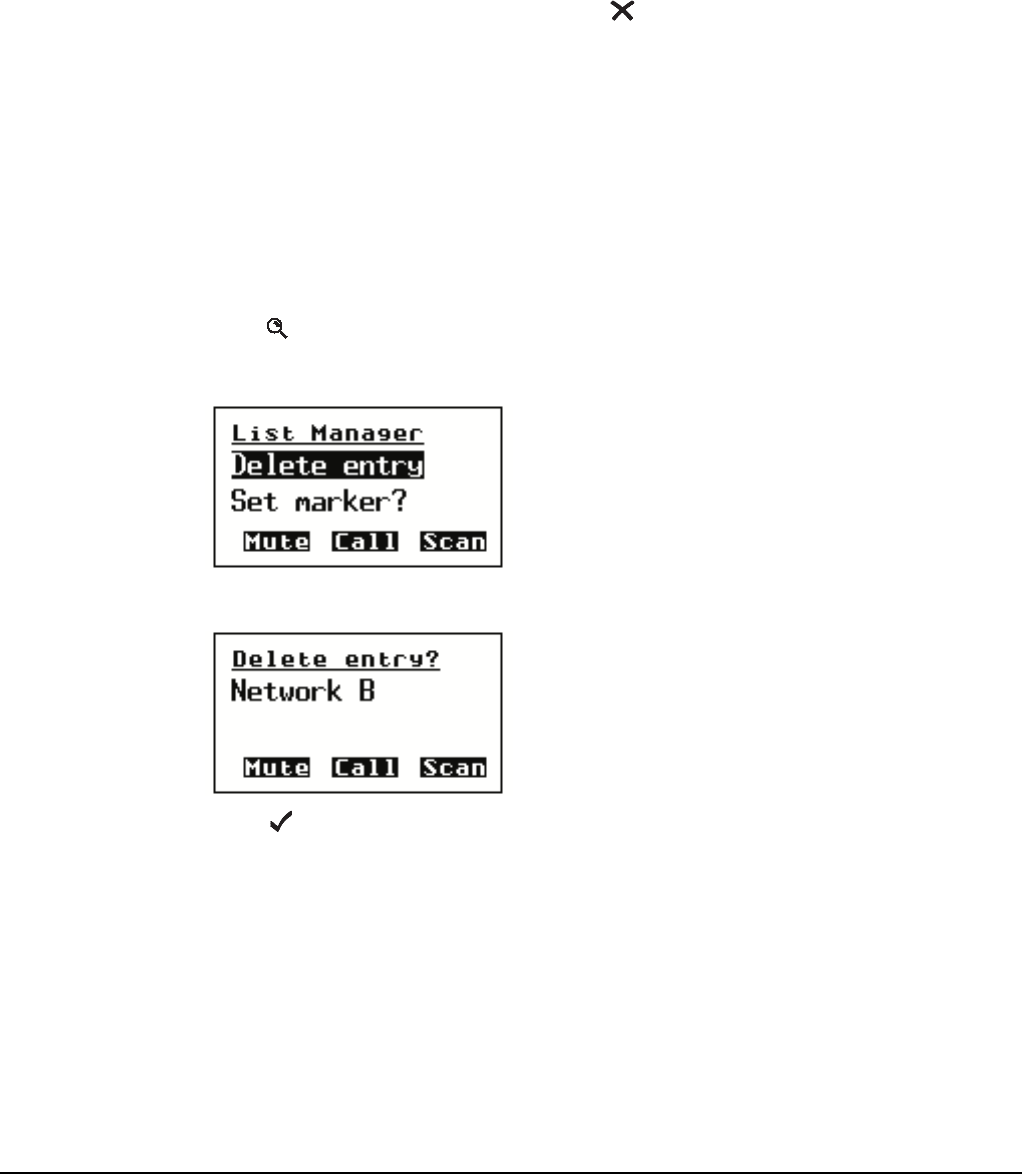
Using lists
100 2110 SSB Transceiver Reference Manual
1When you have edited the settings, press until you return to the entry.
Deleting an entry from a list
To delete an entry from a list:
1Go to the entry you want to delete.
1Hold to open the List Manager.
1Select Delete entry.
The transceiver asks you to confirm that you want to delete the entry.
1Press .
The entry is deleted and the List Manager remains open.
For information on settings in the... See...
Channel List page 118
Network List page 123
NET List page 134
Phone Link List page 142
Address List page 147
NOTE Scroll to the entry or use the Find feature (for help see page 64,
Finding words and values).
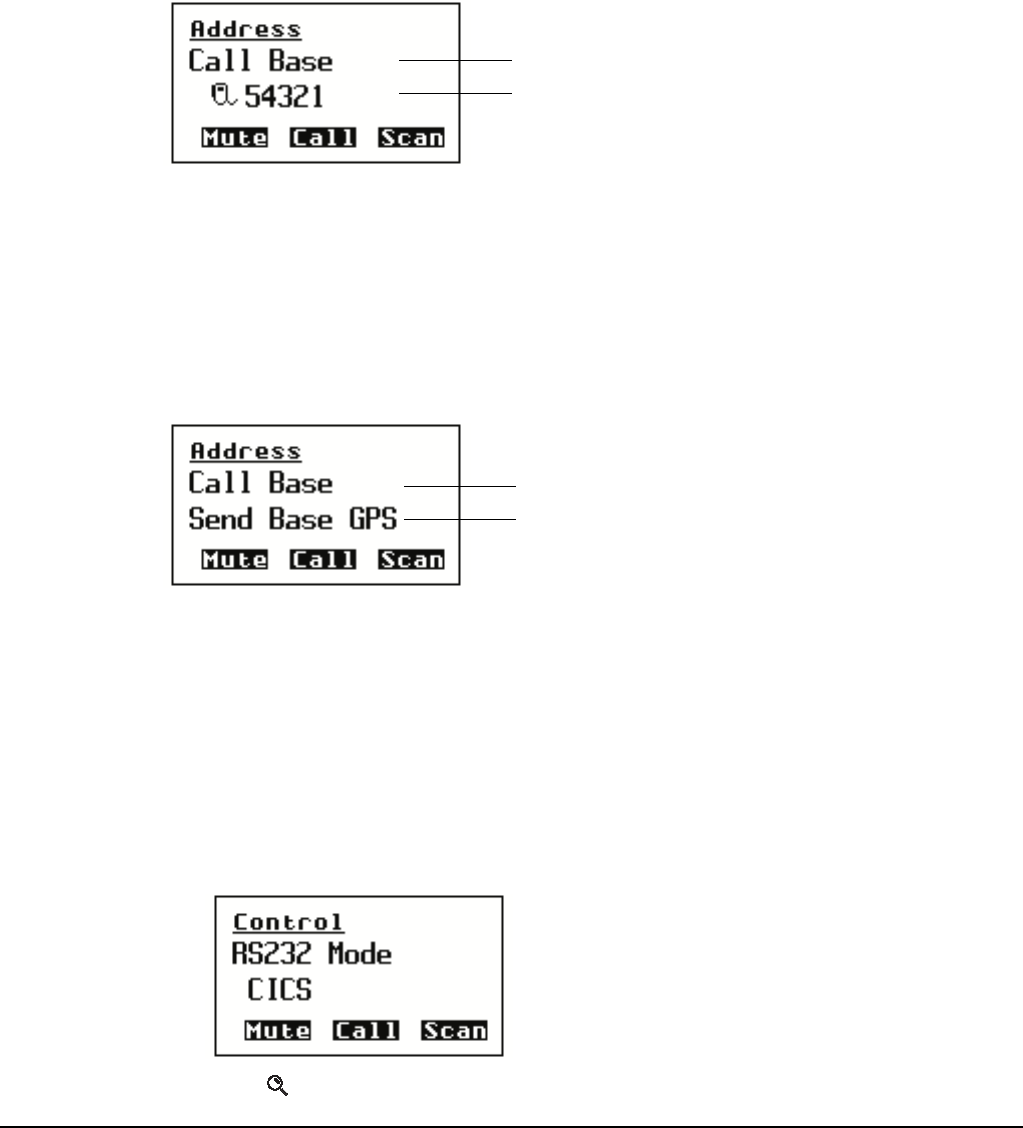
Using lists
2110 SSB Transceiver Reference Manual 101
Hiding and showing settings
You can set up the transceiver to show the first setting for each entry in a list. This shows
the information in the entry.
Figure 19 shows an entry (Call Base) in the Address List with the first setting for the
entry (call type and address) displayed under it. The setting is indented to indicate that it
belongs to the entry above it.
Figure 19: The Address List with settings shown
If you do not want the first setting to be displayed you can hide it.
The next entry in the list is displayed instead, as shown in Figure 20.
Figure 20: The Address List with settings hidden
Hiding settings in a list
To hide settings in a list:
1Go to the list in which you want to hide settings. For example:
1Hold to open the List Manager.
NOTE In the following examples, you will need to log in as administrator to see
the Control List (see page 110, Logging into admin level from user level).
entry
setting
entry
next entry
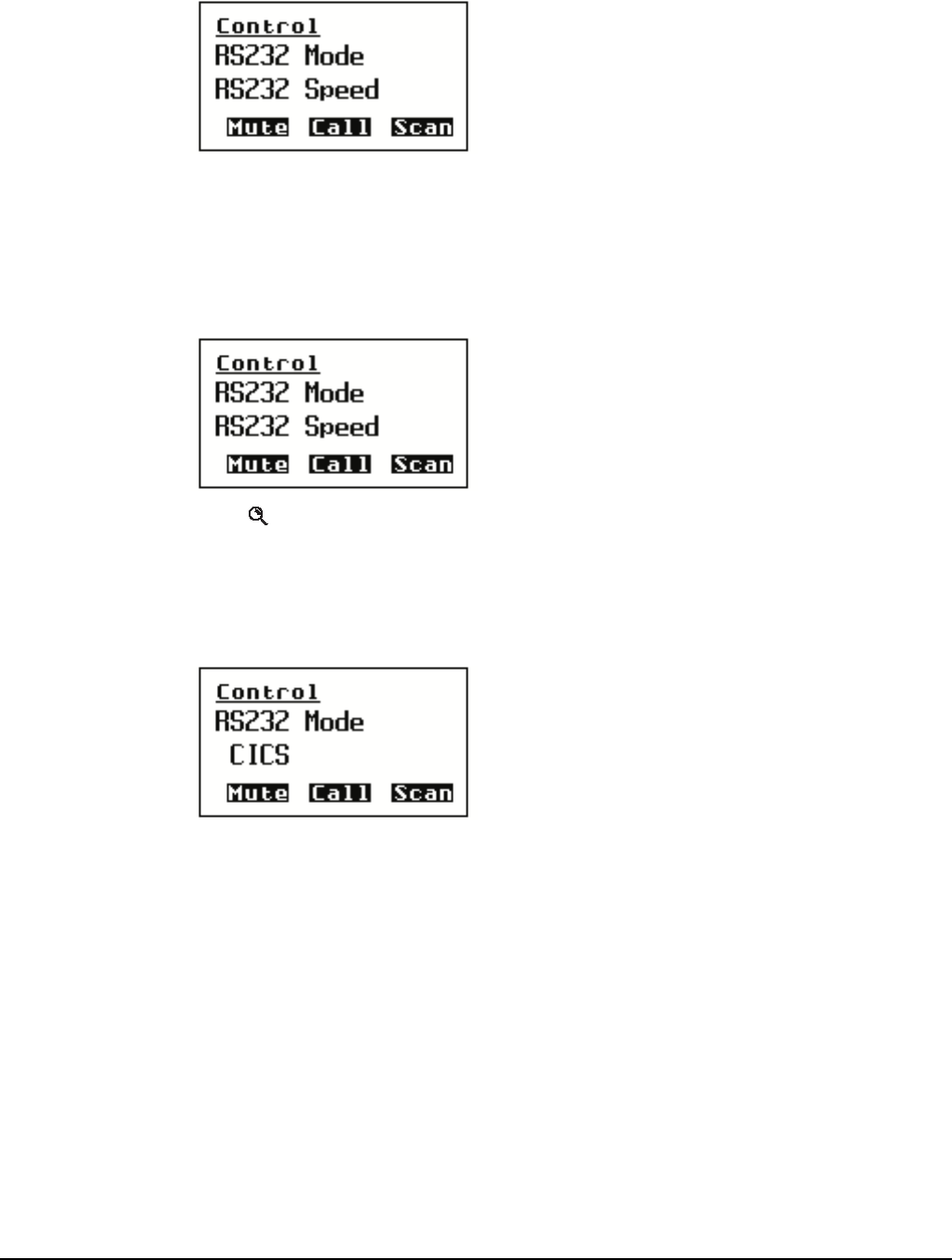
Using lists
102 2110 SSB Transceiver Reference Manual
1Select Display options...
1Select Hide settings?
The settings are hidden and the List Manager remains open.
Showing settings in a list
To show settings in a list:
1Go to the list in which you want to show settings. For example:
1Hold to open the List Manager.
1Select Display options...
1Select Show settings?
The settings are shown and the List Manager remains open.

Using lists
2110 SSB Transceiver Reference Manual 103
Grouping and ungrouping entries
Entries in lists are usually displayed on a single level. When you scroll through a list you
scroll over each entry in it.
Figure 21: Ungrouped entries in a list
If you want to simplify your lists so that you do not have to scroll over each entry, you
can group the entries. When you do this, a second level is created for groups of entries
that begin with the same word. The word that is common to the group is displayed on the
first level and is followed by an ellipsis (...) to indicate that there are entries beneath it.
Figure 22: Grouped entries in a list, level one
This reduces the number of items over which you have to scroll. The entries themselves
are displayed on the second level.
Figure 23: Grouped entries in a list, levels one and two
To display the entries on the second level you simply select the group name (for
example, Screen...) on the first level. The entries can then be selected and edited in the
same way as other entries.
Control
Screen Auto-Dim
Screen Brightness
Screen Contrast
Time Local
Time Screen
Time Zone Offset
Control
Screen...
Time...
Control
Screen...
Time...
Auto-Dim
Brightness
Contrast
Local
Screen
Zone Offset
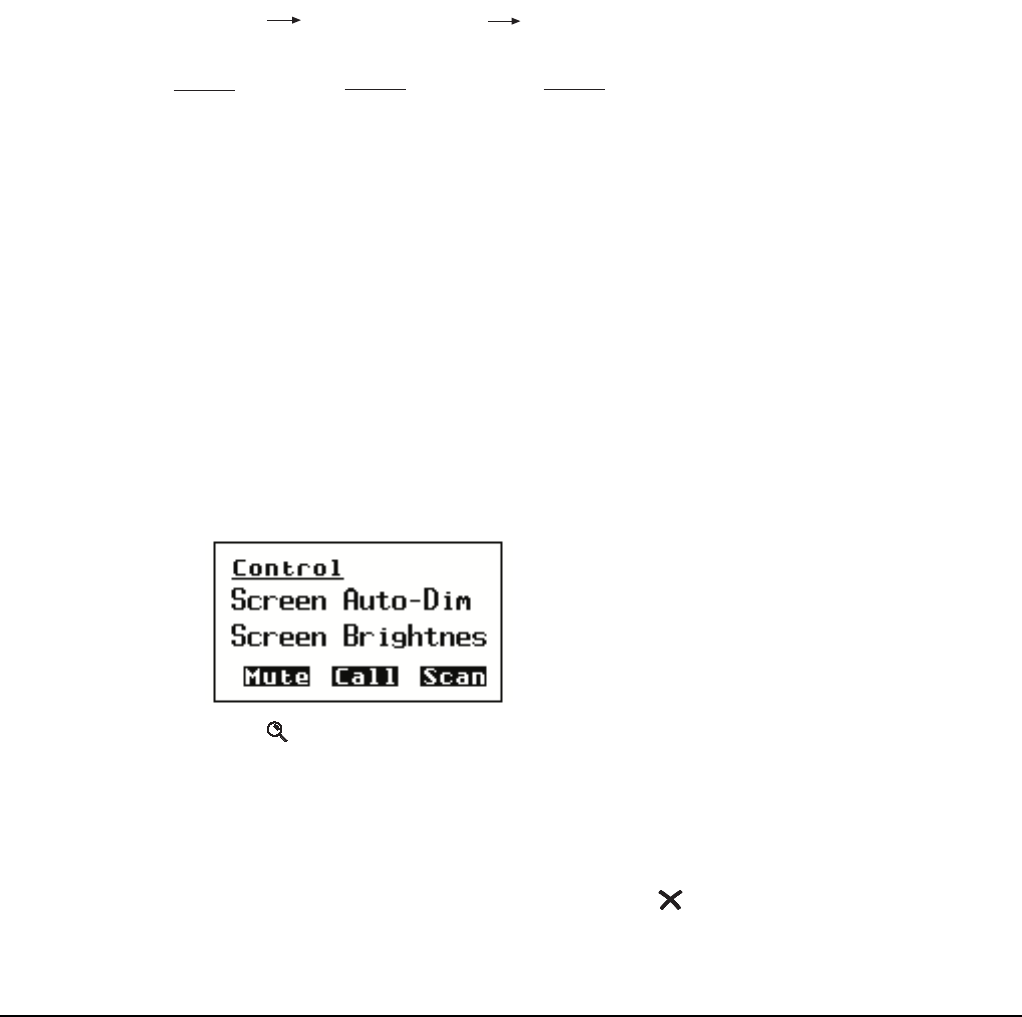
Using lists
104 2110 SSB Transceiver Reference Manual
The entries in the Control List have been named to take advantage of grouping. Related
entries begin with the same word so that, grouped or ungrouped, they appear close to
each other in the list (for example, Time Local, Time Screen, Time Zone Offset).
You cannot change the names of the entries in the Control List. You can, however, take
advantage of grouping in other lists by creating or renaming your entries with group
names.
For example, if you have a number of channels that you only use at night, you could
rename them using a group name such as ‘Night’, then group the entries in the Channel
List (see Figure 24). This will save your having to scroll over the night-time channels
when you do not need to use them, and to limit your scrolling to within the group when
you do.
Figure 24: Ungrouped and grouped entries
Grouping entries
To group entries:
1Open the list in which you want to group entries. For example:
1Hold to open the List Manager.
1Select Display options...
1Select Group entries?
The entries are grouped and the List Manager remains open.
1If you want to view the grouped entries, press to close the List Manager.
NOTE In the following examples, you will need to log in as administrator to see
the Control List (see page 110, Logging into admin level from user level).
Channel
Chan 1
Chan 2
Chan 3
Chan 4
Chan 5
Chan 6
Channel
Chan 1
Chan 2
Night Chan 1
Night Chan 2
Night Chan 3
Night Chan 4
Channel
Chan...
Night...
Original
entries
Night-time entries
renamed with
a group name
Entries
grouped
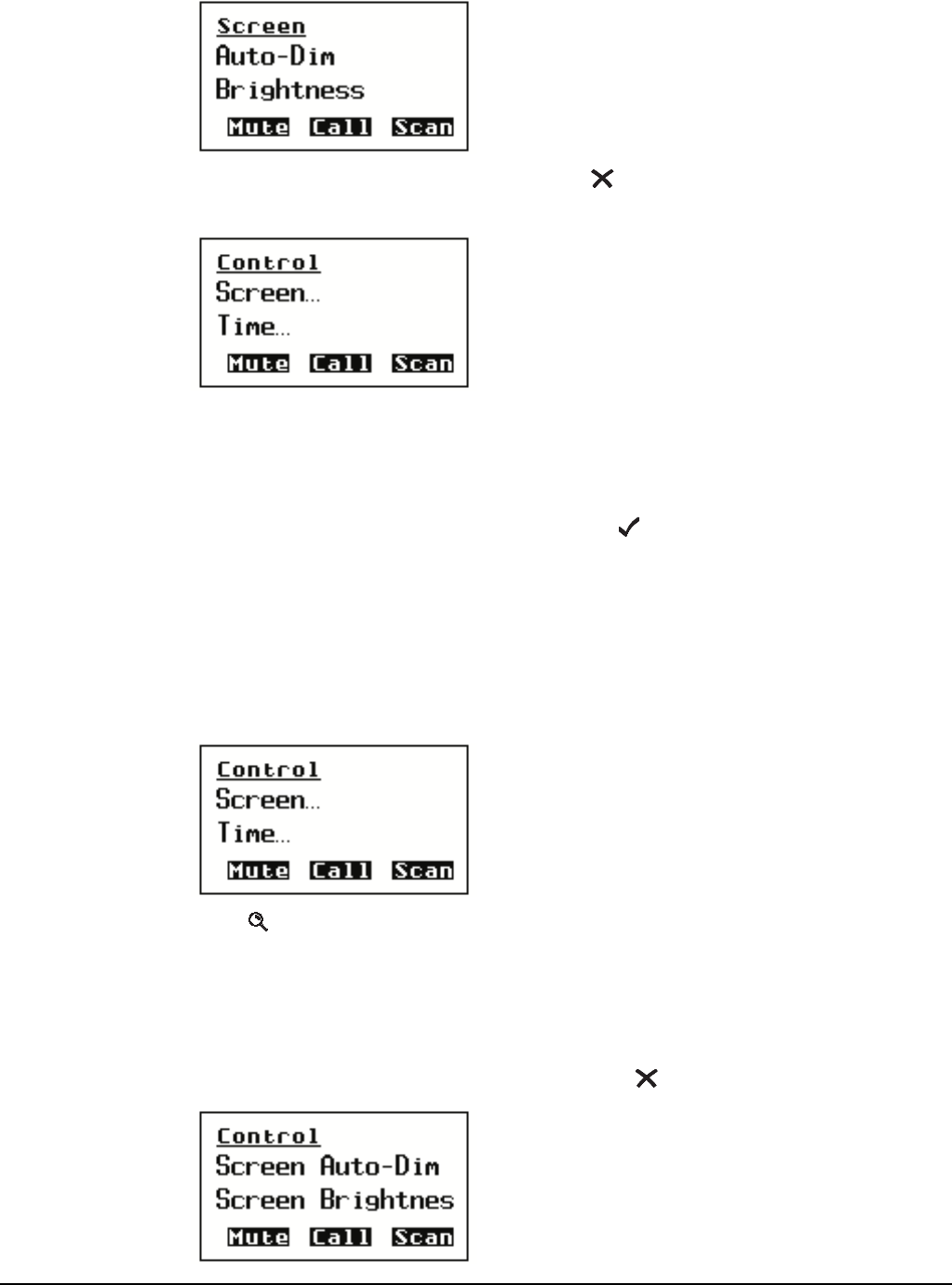
Using lists
2110 SSB Transceiver Reference Manual 105
If you were on an entry with a group name when you opened the List Manager, the
lowest level of that group is displayed when you exit the List Manager. The group
name is displayed on the top line.
To return to the top level of the group, press until the name of the list you are in is
displayed on the top line.
Ungrouping entries
There are two ways to ungroup entries in a list. If you want to temporarily ungroup the
entries in a list, scroll to a grouped entry, then hold . The entries will remain
ungrouped until you exit the list.
If you want the entries to be ungrouped each time you open the list, use the steps below.
To ungroup entries:
1Open the list in which you want to ungroup entries. For example:
1Hold to open the List Manager.
1Select Display options...
1Select Ungroup entries?
The entries are ungrouped and the List Manager remains open.
1If you want to view the ungrouped entries, press to close the List Manager.
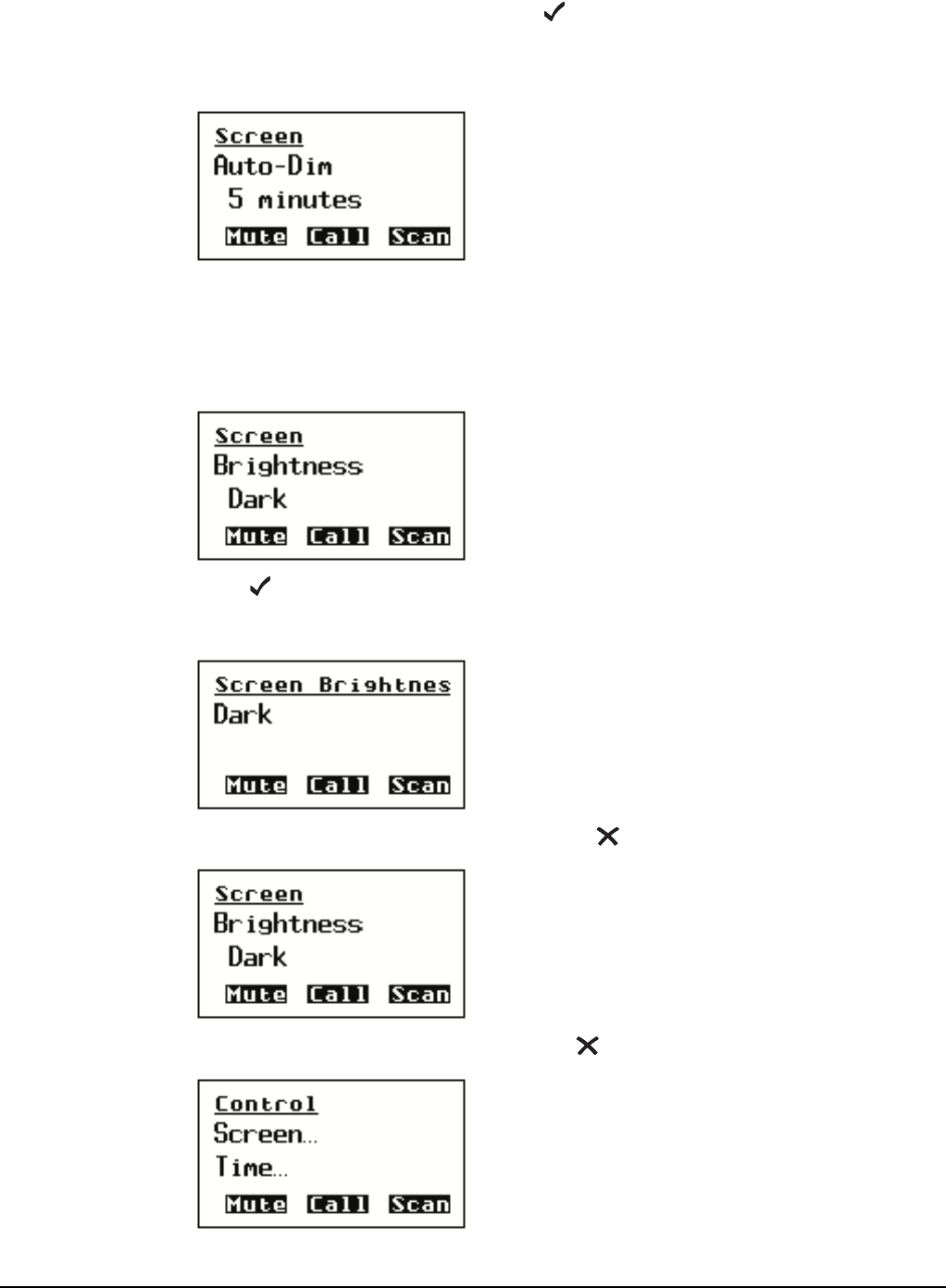
Using lists
106 2110 SSB Transceiver Reference Manual
Selecting a grouped entry
To select a grouped entry:
1Scroll to the grouped name, then press .
The grouped name is displayed on the top line and the entries are displayed beneath
it.
1Scroll through the entries until the one you want is displayed on the active line.
1Press .
The first (or only) setting for the entry is displayed.
1To return to the list of grouped entries, press .
1To return to the first level of the list, press .
NOTE If the settings are hidden, the next entry in the list is displayed on the
bottom line instead of a setting.

Using lists
2110 SSB Transceiver Reference Manual 107
Locking and hiding grouped entries
Grouped entries can be locked and hidden. The process is the same as that for individual
entries except that you start by going to the name of the group you want to lock or hide,
not to a single entry.
For example, to lock all the channels in Figure 25 you would go to the group name
Mobile... and lock it. To lock the night-time channels, you would go to the group name
Night... For more information on locking and hiding entries see page 115, Locking and
unlocking information and page 113, Hiding and showing information.
Figure 25: Locking and hiding grouped entries
Mobile...
Day...
Chan 1
Chan 2
Night...
Chan 11
Chan 12

Using lists
108 2110 SSB Transceiver Reference Manual
Restricting access to information
Access to information in the transceiver can be restricted in two ways. You can lock lists,
entries and settings to prevent them from being edited, and you can hide them to prevent
them from being displayed.
For example, if you do not want users to change the transmit frequencies of channels in
the transceiver, you can lock the settings in which these frequencies are stored. If you do
not want users to see these frequencies you can hide the settings.
User, admin and factory level
Lists, entries and settings can be locked and hidden at three levels—user, admin and
factory level—and they can only be unlocked and displayed by someone logged into the
same or a higher level.
User level is the lowest and most general level. When you switch on the transceiver you
are automatically logged into this level. Items locked and hidden at this level can be
unlocked and displayed by others logged into this level or admin level. The user should
be able to access all necessary information for the day-to-day operation of the transceiver
at this level. By default, the user has access to the Channel and Address Lists.
Admin level is for use by system administrators. Items locked and hidden at this level
can only be unlocked and displayed by others logged into this level. This prevents users
from being able to change and display these items. For details on the admin level see
Table 14 on page 109 and page 110, Logging into admin level. By default, all lists are
hidden at admin level however, this can be changed by the administrator to meet the
user’s requirements. If the administrator recognises that there are some entries in the
Control List to which the user requires access, they can either unlock and show the entry
at user level, or set up a hot key to access the entry (see page 241, Creating a macro and
assigning it to a hot key).
Factory level is the highest level and is used by Codan to lock certain configuration
settings in the Control List. Items locked at this level can be displayed by users and
administrators but cannot be unlocked. You cannot log into factory level.
Items can be locked at one level and hidden at another. For example, if you have access
to admin level and do not want users to display the factory-locked configuration settings
in the Control List, you could hide these settings at admin level.
Table 14 summarises the access restrictions you can place on items at user and admin
level. Locking and hiding information is covered in more detail on page 115, Locking
and unlocking information and on page 113, Hiding and showing information.

Using lists
2110 SSB Transceiver Reference Manual 109
Full and normal view
Full view is a feature that enables you to display items that have been hidden at the level
into which you are logged, and to see the level at which items have been locked.
For example, if you have logged in as a user then switch to full view, information that
has been hidden at user level is displayed and icons at the top right of the screen indicate
the level at which any items have been locked and hidden. When you switch to normal
view, the hidden items and the icons are removed. Full and normal view are covered in
more detail on page 112, Displaying full and normal view.
Table 14: Restricting access to information at user and admin levels
If you log into user
level...
You can...
• lock and hide items at user level
• unlock items that have been locked at user level
• display items that have been hidden at user level
You cannot...
• unlock items that have been locked at admin or factory
level
• display items that have been hidden at admin or factory
level
If you log into admin
level...
You can...
• lock and hide items at user and admin level
• unlock items that have been locked at user or admin level
• display items that have been hidden at user or admin level
You cannot...
• unlock items that have been locked at factory level
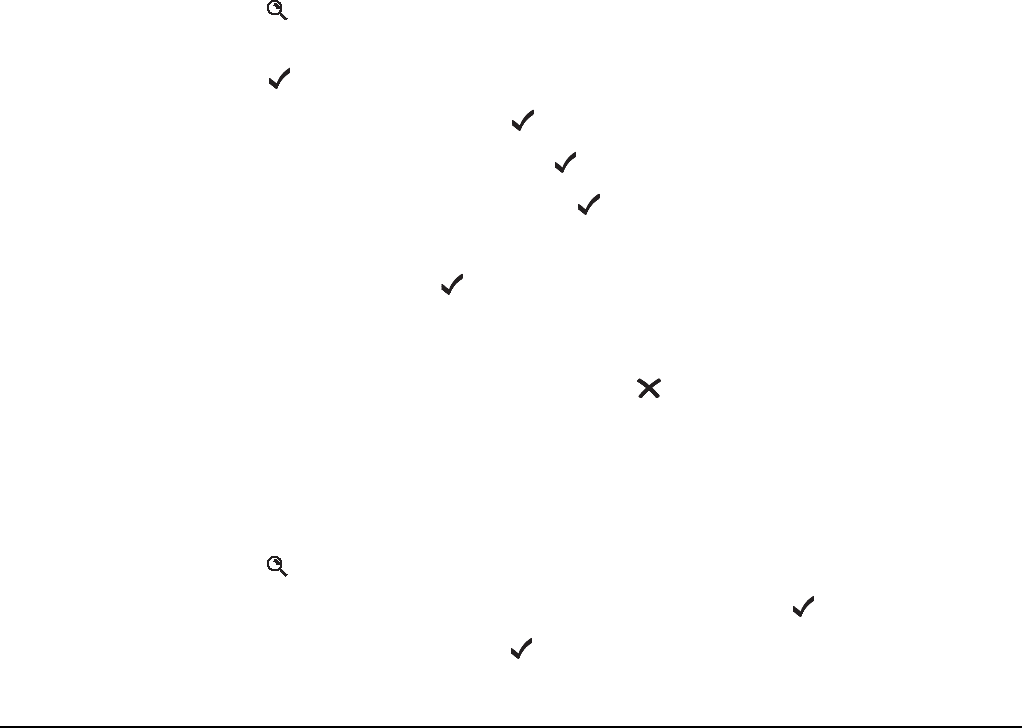
Using lists
110 2110 SSB Transceiver Reference Manual
Logging into admin level
Logging into admin level gives you access to the Admin... group of entries in the List
Manager (see Table 13 on page 92). These entries enable you to lock and hide
information at admin level.
When you log into admin level:
• all locked entries are temporarily unlocked
• full view is enabled
There are two ways you can log into admin level. If you are prompted to enter a
password when you switch on the transceiver, you can enter the admin password instead
of the user password.
You can also log into admin level by logging in at user level then using the Admin login
entry in the List Manager.
Logging into admin level from user level
To log into admin level from user level:
1Hold to open the List Manager.
If Quick Start is enabled, scroll to Advanced... in the Quick Start menu, then
press .
1Scroll to Config..., then press .
1Scroll to Admin login, then press .
1Enter the admin password, then press .
You are logged into admin level and the List Manager remains open.
1If you want to access the Main Menu, press until Main Menu is displayed.
Logging out of admin level
To log out of admin level:
1Hold to open the List Manager.
If Quick Start is enabled, scroll to Advanced..., then press .
1Scroll to Admin..., then press .
NOTE
If you want to log into admin level this way, make sure that a user and an
admin password have been set in the Control List. When you switch on
the transceiver, you are only prompted to enter a password if a user
password has been set.
NOTE If an admin password has not been set, you can log in by simply
pressing .

Using lists
2110 SSB Transceiver Reference Manual 111
1Scroll to Admin logout, then press .
You are returned to user level and the List Manager remains open.
NOTE If you switch off the transceiver while you are logged into admin level
you are automatically logged out.
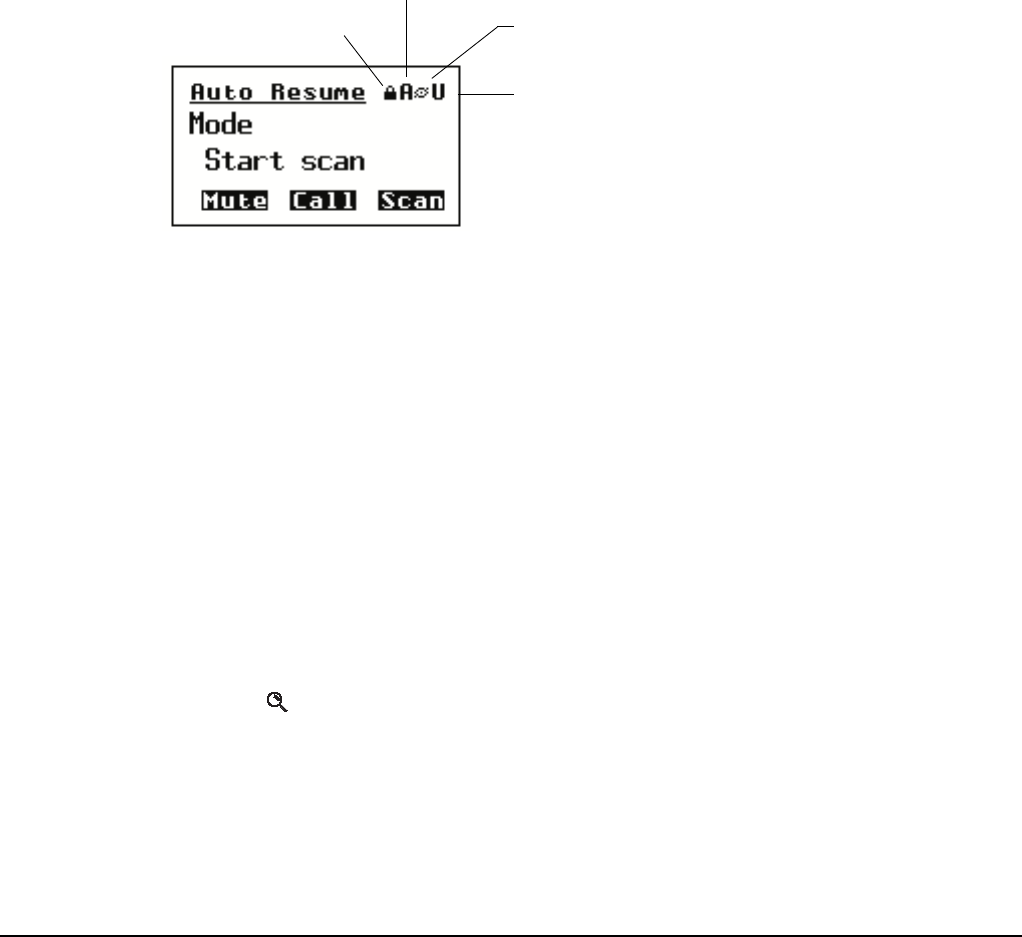
Using lists
112 2110 SSB Transceiver Reference Manual
Displaying full and normal view
Full view is a feature that enables you to display any items that have been hidden at the
level into which you are logged, and to see the level at which items have been locked.
When you switch to full view, icons are displayed at the top right of the screen to indicate
whether an item has been locked and/or hidden, and the level at which these restrictions
were set (for more information on access levels see page 108, Restricting access to
information). When you switch to normal view, the icons and any items that have been
hidden are removed.
Figure 26 shows the front panel screen in full view. The entry in this figure has been
locked at admin level to prevent it from being edited by users, and hidden at user level to
prevent it from being displayed to users in normal view.
Figure 26: Full view
If you want to unlock an item that was locked at the same level as that into which you are
logged, you do not need to switch to full view. For example, if you are logged into user
level and want to unlock an item locked at user level you can do so in normal view.
If you want to be able to see an item that has been hidden in normal view, you must first
switch to full view to display the item (with its hide icon), then use the Config... Show?
entry in the List Manager. When you return to normal view, the item will be displayed.
For more information on locking and hiding items at different levels see page 115,
Locking and unlocking information and page 113, Hiding and showing information.
Switching between full and normal view
To switch between full and normal view:
1Hold to open the List Manager.
1Select Display options...
1Select Full view? or Normal view?
Full view or normal view is displayed and the List Manager remains open.
level at which item
was hidden (U=user)
level at which item
was locked (A=admin)
hide icon
lock icon

Using lists
2110 SSB Transceiver Reference Manual 113
Hiding and showing information
If you want to prevent users from displaying information, in particular lists, entries and
settings, you can hide these items. For example, to prevent users from displaying the
transmit frequency of a channel, you can hide the setting in which the frequency is
stored. You can also hide entries in lists to reduce the number of items over which you
need to scroll. By default, all lists are admin hidden. Therefore, users cannot access
configuration information in the transceiver unless the administrator shows this
information at user level.
You can hide lists, entries and settings at one of two levels: user level and admin level
(for more information see page 108, Restricting access to information). Table 15
summarises the effects of hiding information at these levels.
When you log into admin level, full view is automatically enabled, so all items hidden at
user or admin level will be displayed.
Hiding or showing an item at user level
To hide or show a list, entry or setting at user level:
1Go to the list, entry or setting you want to hide or show.
CAUTION
If a hot key has been created to display a hidden item, anyone can display
the item by using the hot key. If the item is not locked, anyone can edit the
item.
Table 15: Hiding items at user and admin levels
Hiding an item at... Means that...
user level • the item is hidden from anyone logged into user level, in
normal view
• users can display the item by switching to full view
• users can display the item in normal view by using the
Config... Show? entry in the List Manager
• the item is visible to anyone logged into admin level, in
normal or full view
admin level • the item is hidden from anyone logged into user level, in
full or normal view
• all items hidden at user or admin level will be displayed
automatically
NOTE You may need to switch to full view to see the item (see page 112,
Displaying full and normal view).
NOTE
If you want to hide a group of entries in a list, make sure that the
entries in the list are grouped, then go to the name of the group you
want to hide. For more information on grouping entries see page 103,
Grouping and ungrouping entries.

Using lists
114 2110 SSB Transceiver Reference Manual
1Hold to open the List Manager.
1Select Config...
1Select Hide? or Show?
1Switch to normal view, if required.
The List Manager remains open.
Displaying an item hidden at user level
To display a list, entry or setting that has been hidden at user level:
1Switch to full view (for help see page 112, Displaying full and normal view).
1Go to the list, entry or setting that was hidden.
Hiding or showing an item at admin level
To hide or show a list, entry or setting at admin level:
1Log into admin level if you have not already done so (for help see page 110,
Logging into admin level).
1Go to the list, entry or setting you want to hide or show.
1Hold to open the List Manager.
1Select Admin...
1Select Admin hide? or Admin show?
The List Manager remains open.
NOTE If the item is not displayed in full view it has been hidden at admin or
factory level.
NOTE
If you want to hide a group of entries in a list, make sure that the
entries in the list are grouped, then go to the name of the group you
want to hide. For more information on grouping entries see page 103,
Grouping and ungrouping entries.

Using lists
2110 SSB Transceiver Reference Manual 115
Locking and unlocking information
If you want to prevent users from changing information, in particular lists, entries and
settings, you can lock these items. For example, if you want to prevent users from
changing the station self address of the transceiver you can lock the Address entry in the
Control List. If you want to prevent users from changing any information in the Control
List you can lock the entire list. In addition, locking items prevents them from being
accidentally changed.
You can lock lists, entries and settings at one of two levels: user level and admin level
(for more information see page 108, Restricting access to information). Table 16
summarises the effects of locking information at these levels.
When you log into admin level, all locked items are temporarily unlocked.
Locking or unlocking an item at user level
To lock or unlock a list, entry or setting at user level:
1Go to the list, entry or setting you want to lock or unlock.
1Hold to open the List Manager.
1Select Config...
1Select Lock? or Unlock?
The item is locked or unlocked and the List Manager remains open.
Table 16: Locking items at user and admin levels
Locking an item at... Means that...
user level • anyone logged into user level can unlock the item by using
the Unlock? or Locks off? entries in the List Manager, then
they can edit the item
• anyone logged into admin level can edit the item without
unlocking it first
admin level • the item cannot be edited by anyone logged into user level
• the item can be edited by anyone logged into admin level
NOTE
If you want to lock a group of entries in a list, make sure that the
entries in the list are grouped, then go to the name of the group you
want to lock. For more information on grouping entries see page 103,
Grouping and ungrouping entries.

Using lists
116 2110 SSB Transceiver Reference Manual
Locking or unlocking an item at admin level
To lock or unlock a list, entry or setting at admin level:
1Log into admin level if you have not already done so (for help see page 110,
Logging into admin level).
1Go to the list, entry or setting you want to lock or unlock.
1Hold to open the List Manager.
1Select Admin...
1Select Admin lock? or Admin unlock?
The item is locked or unlocked and the List Manager remains open.
Switching locks off or on at user level
If you need to edit a number of items that have been locked you may want to use the
locks off feature. This switches off all the locks set at the level into which you are
logged, so you do not have to unlock items individually. When you have edited the items
you can reinstate all the locks in one step using the locks on feature.
To switch locks off or on at user level:
1Hold to open the List Manager.
1Select Config...
1To switch locks off select Locks off?
To switch locks on select Locks on?
The List Manager remains open.
NOTE
If you want to lock a group of entries in a list, make sure that the
entries in the list are grouped, then go to the name of the group you
want to lock. For more information on grouping entries see page 103,
Grouping and ungrouping entries.
NOTE If you switch off the locks and switch off the transceiver, the locks are
automatically reinstated.

The Channel List
118 2110 SSB Transceiver Reference Manual
About channels
A channel is a frequency or pair of frequencies to which a name has been given, such as
‘Channel 1’, ‘4500’ and ‘Headquarters’. You need to enter the details of at least one
channel before you can make or receive a call. Channels are stored in the Channel List.
Settings in the Channel List
When you create a channel you need to enter:
• a name for the channel
• the receive and transmit frequencies of the channel, if applicable
• one or more modes to be used with the channel
Channel names
A channel name can consist of letters, numbers or a combination of both. Before you
name any channels, consider using group names to make navigation in the Channel List
easier (for more information see page 103, Grouping and ungrouping entries).
Frequencies
The receive and transmit frequencies may be any frequencies within the HF range.
However, the transmit frequencies can only be those allocated to you by the relevant
government authority in your country.
Spectral regulations may require the TxD option to be installed in the transceiver. In this
case, you cannot create channels with new transmit frequencies. You can, however,
create receive-only channels, and channels with the same transmit frequency as an
existing channel. If the TxP option has been installed in the transceiver, you cannot
create channels.
Modes
A mode specifies a combination of a sideband (for example, USB or LSB) and IF filter
settings (that is, bandwidth and centre frequency). Each channel must have at least one
mode. You may want to select several modes for each channel depending on the modes
available to you.
When the standard IF filter is fitted, the allowable modes are USB and LSB. If a different
filter is fitted, other modes are available. For example, if you have a wide IF filter fitted,
USBW and LSBW are available. If you have a narrow Morse filter fitted, USB CW and
LSB CW are available.
CAUTION
You should be aware of any restrictions placed on channel names in your
transceiver when it is used with InterNav software. For more information
see the documentation provided with this equipment.

The Channel List
2110 SSB Transceiver Reference Manual 119
Programming the Channel List
Creating a channel
This section covers creating a channel in a transceiver where receive and transmit
frequencies can be entered.
To create a channel:
1Press VIEW until the channel screen is displayed.
1Use the List Manager to create an entry (for help see page 97, Creating an entry in a
list and page 52, Entering and editing text).
1Enter the setting information provided in the following table as required, then
press to enter the information.
NOTE
If you are operating the transceiver in a country that has stringent
licensing regulations, you may not be permitted to create channels with
transmit frequencies.
If the TxD option has been installed in the transceiver, there are
restrictions on the frequencies you can enter.
If the TxP option has been installed in the transceiver, you cannot create
channels.
NOTE If the Channel List is empty, Free Tune is displayed.
If this prompt is
displayed...
Do this...
Receive Freq • use this frequency, or
• enter a new receive frequency in kilohertz
NOTE
You can enter the frequency to three decimal
places. Press * to enter a decimal point, then
continue with entering the frequency.
Transmit Freq • use this frequency, or
• enter a new transmit frequency in kilohertz, or
• disable the transmit frequency by pressing
repeatedly until the setting is empty
NOTE
If the TxD option has been installed in the
transceiver, you cannot create channels with
new transmit frequencies. You can however,
create channels with the same transmit
frequency as an existing channel, and you
can disable transmit frequencies to create
receive-only channels.

The Channel List
120 2110 SSB Transceiver Reference Manual
The new channel is created and the List Manager remains open.
1If you want to view the channel you have created, press to close the List
Manager.
Renaming a channel
When you rename a channel, references to the channel in other lists are not automatically
updated; you need to go to the Address, Network and Phone Link Lists and update any
references to the channel.
For example, if the channel you renamed is used in a network, go to the channel/mode
list for the network, find the reference to the old channel name, then edit it so that the
new name is displayed (for help see page 129, Editing a network). If you do not update
the reference to the channel, the channel will not be scanned when scanning is switched
on.
Renaming a channel is a standard list function. For help see page 98, Renaming an entry
in a list.
Copying a channel
Copying a channel is a standard list function. For help see page 99, Copying an entry in a
list.
Editing a channel
Editing a channel is a standard list function. For help see page 99, Editing an entry in a
list.
Deleting a channel
Deleting a channel is a standard list function. For help see page 100, Deleting an entry
from a list.
Mode • enter a mode
NOTE
If multiple modes can be added to the
channel, select the new mode and press .
If you do not want to add another mode,
press .
NOTE If you disabled the transmit frequency, dashes are displayed in place
of the transmit frequency.
If this prompt is
displayed...
Do this...
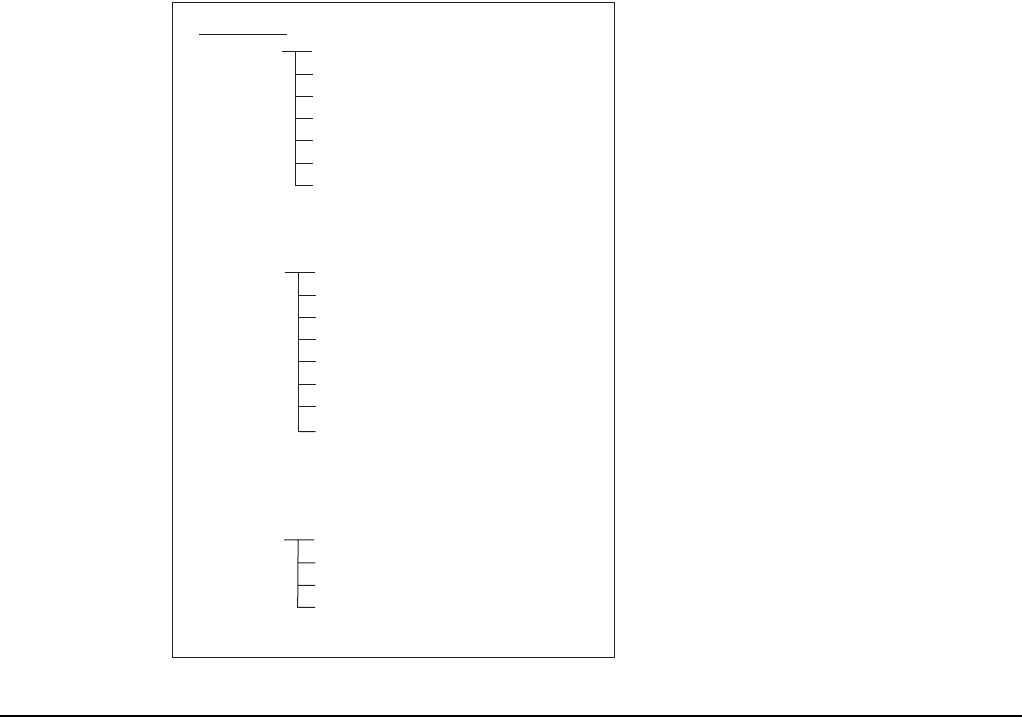
The Network List
122 2110 SSB Transceiver Reference Manual
About networks
A network is two or more stations that use the same frequencies and call system to
communicate. This simplifies communication because each station knows the method
with which they can make and scan for incoming calls, and the frequencies they can use.
Information about the networks you may use is stored in the Network List.
Networks are based on call systems. A call system is a method of making and receiving
calls. For example, if you are in a network that uses the Codan Selcall call system, you
can make calls by entering the address of the station you want to call, then selecting the
channel/mode you want to use. When your call is detected by the receiving station, that
station rings to alert the operator. In an ALE/CALM network, you can make calls by
entering the address of the station you want to call only. The transceiver will select the
best channel on which to make the call.
When you create a network, the transceiver prompts you to select a call system, then
prompts you for further information based on your selection. Figure 27 shows an
example of the information required to create networks based on the Codan Selcall,
ALE/CALM, and Voice Only call systems. This information is explained on page 123,
Settings in the Network List.
Figure 27: An example of information stored in the Network List
NOTE The call systems from which you can select depend on the options
installed in the transceiver.
Network List
Network B Scan Network:
Call System:
Call Detect Time:
Privacy Mode:
Privacy Password:
Nominal Preamble:
Channel/Mode:
Scan
ALE/CALM
<default>
Group
2 seconds
Chan 1/USB
Chan 2/USB
Chan 3/USB
******
Sounding Interval: 2.5 hours
Chan 4/LSB
Network A Scan Network:
Call System:
Call Detect Time:
Privacy Mode:
Privacy Password:
Nominal Preamble:
Channel/Mode:
Scan voice
Codan Selcall
<default>
Registered
******
4 seconds
Chan 3/USB
Chan 4/LSB
Chan 5/USB
Network C Scan Network:
Call System:
Call Detect Time:
Channel/Mode:
Dont Scan
Voice Only
<default>
Chan 1/USB
Chan 2/LSB

The Network List
2110 SSB Transceiver Reference Manual 123
Settings in the Network List
Network Name
Scan Network
The Scan Network setting applies to all types of networks. It enables you to specify
whether or not you want the channels in the network to be scanned when scanning is
switched on. You can also set the transceiver to scan for voice in voice networks even
when the Mute Type is set to Selcall mute.
Call System
The Call System setting applies to all types of networks. The call system is the method
used by the network to make and receive calls, for example, Codan Selcall, ALE/CALM
or Voice Only. The call systems from which you can select depend on the options
installed in the transceiver.
If your network uses the Codan Selcall call system, you can make calls by selecting an
appropriate channel/mode then entering the address of the station you want to call. When
your call is detected by the receiving station, that station rings to alert the operator. If
your network uses the ALE/CALM call system the transceiver can select the best
channel/mode for you. If your network uses the Voice Only call system, you can make
calls by selecting an appropriate channel/mode then pressing PTT and speaking. You
cannot enter the address of the station you want to call.
Call Detect Time
The Call Detect Time setting applies to all types of networks. The call detect time is the
length of time the transceiver pauses on each channel, when scanning, to detect an
incoming call. You can set the call detect time to <default> or to a specific value.
NOTE In the following discussion, you will need to log in as administrator to see
the Network List (see page 110, Logging into admin level from user level).
CAUTION You should be aware of any restrictions placed on network names in your
transceiver when it is used with InterNav software.
NOTE
The transceiver will scan a maximum of 100 channels at a time. If the
total number of channels in all the networks you are scanning exceeds
100, only 100 of the channels will be scanned.
CAUTION Any station that is tuned to your frequency and has mute off can listen to
your voice conversation.

The Network List
124 2110 SSB Transceiver Reference Manual
Sounding Interval
The Sounding Interval setting applies to ALE/CALM networks only. The sounding
interval is the frequency with which the transceiver sends sounding signals to other
stations to assess the quality of the channels in the network.
The recommended value is 5 hours. The longer the value, the longer the transceiver takes
to update its channel quality information. If the value is set to 5 hours the transceiver will
take 5 days to completely update channel quality information. Longer sounding intervals
decrease the interruptions on network channels.
Privacy Mode
The Privacy Mode setting applies to Codan Selcall and ALE/CALM networks only. The
Privacy Mode is the method used to encrypt the data content of calls between stations. If
you select Registered or Group, you will need to enter an appropriate password into the
Privacy Password setting.
When you are setting up ALE/CALM networks, you should ensure that you set up
networks with the same Privacy Mode for communication. If there is a mismatch in
Privacy Modes, the receiving station will use the most suitable privacy mode out of the
networks through which the call may be received.
For example, if an initiating station starts an ALE call containing data through a network
that has its Privacy Mode set to Plain, and the receiving station determines that the
address is valid in networks with the Privacy Mode set to Group or Plain, then it will
select the network with the Privacy Mode set to Plain on which to establish the link. Any
data communications within this link will use the basic 64 ASCII subset of characters.
NOTE
The call detect time is the inverse of the scan rate. For example, a call
detect time of 0.2 seconds is equivalent to a scan rate of 5 channels per
second.
NOTE Link quality information is also updated each time a call is made or
received.
Privacy Mode Is used for...
Registered encrypting Phone calls that you make when you have registered
with a network that encrypts telephone numbers (you are
provided with a password that you need to enter into the Privacy
Password setting)
Group encrypting data in calls between two stations (you agree upon a
password to enter into the Privacy Password setting)
None calls made under a Codan protocol, which uses special
formatting
Plain (lowest mode)
(MIL-STD-188-141B
ALE option only)
AMD messages in ALE calls (basic 64 ASCII subset A–Z, 0–9,
space ! " # $ % & ' ( ) * + , - . / : ; < = > ? @ [ \ ]
^)

The Network List
2110 SSB Transceiver Reference Manual 125
However, if the receiving station determines that the address is available in a Group
network only, it will select the Group network on which to establish the link. Data
communications within this link will not be successful because the initiating station does
not have the password for the Privacy Mode of Group at the receiving station.
If an initiating station starts an ALE call (without data), the receiving station determines
in which networks the address is valid, selects a network with the lowest Privacy Mode
available, then establishes the link. Data communications may proceed as per the Privacy
Modes of the selected sending and receiving networks.
Privacy Password
The Privacy Password setting applies to Codan Selcall and ALE/CALM networks where
the Privacy Mode has been set to Group or Registered. The privacy password is the
password that enables you to use the Privacy Mode mentioned above. It can be up to
15 characters long.
Nominal Preamble
The Nominal Preamble setting applies to Codan Selcall and ALE/CALM networks only.
The nominal preamble is the length of the preamble signal sent by the transceiver when
you make a call. This is the signal for which other transceivers scan in order to detect
your call.
The nominal preamble should be set to no less than the number of channels in the
network multiplied by the call detect time. If you set the Nominal Preamble to <default>
the transceiver will calculate the length of preamble at the time of the call, based upon
the number of channels in the network. If you are calling a station that uses identical
network information, the preamble of the initiating station will match the detection
requirements of the receiving station. If such stations are scanning a different number of
networks, then the nominal preamble should be calculated on a per station basis.
If a transceiver that you want to call scans multiple networks, the preamble can be
increased to the time it takes that transceiver to scan all of its channels.

The Network List
126 2110 SSB Transceiver Reference Manual
Channel/Mode
The Channel/Mode setting applies to all networks. This setting contains the channels and
modes used by the network. The modes from which you can select are those specified for
the channel in the Channel List.
Before you add channel/modes to a network, consider the following:
• While there is no limit to the number of channels you can add to a network, the
transceiver will only scan a maximum of 100 channels at a time. If the total number
of channels in all the networks you are scanning exceeds 100, only 100 of the
channels will be scanned.
• If several modes can be used with one channel and you want the channel to be
scanned using each mode, create several entries for the channel, one for each mode.
For example, if you want to scan ‘Chan 1’ using modes USB and LSB, create the
entries ‘Chan 1/USB’ and ‘Chan 1/LSB’.
• An easy way to add and maintain channels in a network is to use groups of channels.
Only the group name is stored in the Network List so you can add and delete
channels from the group in the Channel List without having to update the Network
List each time. When the network is scanned the transceiver scans whichever
channels are in the group at the time. For more information see page 103, Grouping
and ungrouping entries.
• When you add a group of channels to a network you need to select a mode for the
group. The mode should be an allowed mode for all the channels in the group as the
transceiver will only scan the channels for which the mode is allowed.
If the mode is not an allowed mode for one or more channels, these channels are
listed in a message that is displayed when you switch scanning on. In this situation
these channels will not be scanned. To ensure that they are scanned, add them to the
network individually.
• A network cannot be scanned unless there are channel/modes in it. However, you
can still use the network to make calls. The channel/modes from which you can
select are all those in the Channel List.
• If you rename a channel in the Channel List and that channel is used in a network,
you must delete the channel from the network and if necessary add the new channel
name.
• If you make frequent and significant changes to the channels and networks in the
transceiver you may want to use NSP to maintain this information.

The Network List
2110 SSB Transceiver Reference Manual 127
Special network names
Specifying a default network to use with !<network name>
When you make a call from the Channel List, the transceiver usually prompts you to
select a network and channel for the call. To avoid the transceiver prompting you for a
network or channel, the system administrator should set up a network with a leading ‘!’
in the name, for example, ‘!AidNet’. The !<network name> should contain all of the
channels that are programmed into the transceiver, thus avoiding any prompting for
channels.
These networks enable the operator to make a call on any channel in the transceiver with
minimal prompting by the transceiver.
Networks called *CALM, *Selcall and *Voice
These networks are used with Quick Start (see page 57, Quick Start).
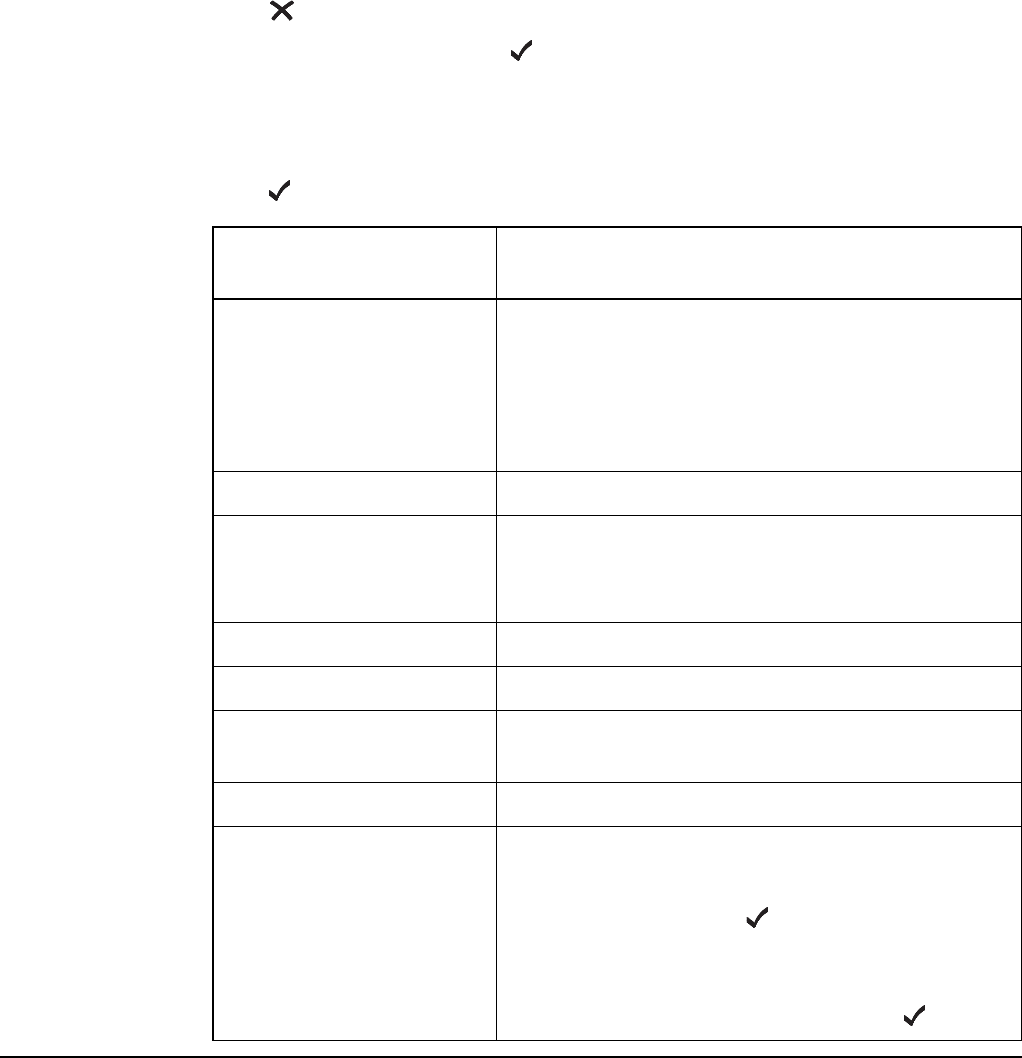
The Network List
128 2110 SSB Transceiver Reference Manual
Programming the Network List
Creating a network
When you create a network, the transceiver prompts you for various details. It is
recommended that you read page 123, Settings in the Network List before you create a
network.
To create a network:
1Press until Main Menu is displayed.
1Scroll to Network, then press .
1Use the List Manager to create an entry (for help see page 97, Creating an entry in a
list and page 52, Entering and editing text).
1Enter the setting information provided in the following table as required, then
press to enter the information.
NOTE In the following discussion, you will need to log in as administrator to see
the Network List (see page 110, Logging into admin level from user level).
If this prompt is
displayed...
Do this...
Scan Network? • select whether the network is scanned or not
NOTE
If you want to scan a voice network for
voice when the Mute Type is set to Selcall,
select Scan voice (see page 61, Muting the
transceiver).
Call System? • select the call system you want to use
Call Detect Time? • increase or decrease the call detect time, or
• scroll to the far left of the line until <default> is
displayed
Sounding Interval? • select the value you want to use
Privacy Mode? • select the mode you want to use
Privacy Password? • enter the password you want to use with the
Privacy Mode
Nominal Preamble? • increase or decrease the nominal preamble time
Channel? • select the channel you want to use
NOTE
If the channel is in a group, select the group
name then press , then select the channel
that you want to use.
If you want to use a group of channels,
select the group name, then hold .

The Network List
2110 SSB Transceiver Reference Manual 129
The new network is created and the List Manager remains open.
1If you want to view the network you have created, press to close the List
Manager.
Renaming a network
When you rename a network, references to the network in other lists are not
automatically updated; you need to go to the Address entry in the Control List to update
any of your station self addresses that refer to the network, and to the Address, NET and
Phone Link Lists to update any entries that refer to the network.
For example, if the network you renamed is used in an entry in the Address List, go to
this entry, find the reference to the old network name, then change it so that the new
name is displayed (for help see page 155, Editing an entry in the Address List). If you do
not update the reference to the network, the transceiver will prompt you to select a
network each time you use the entry to make a call.
Renaming a network is a standard list function. For help see page 98, Renaming an entry
in a list.
Copying a network
Copying a network is a standard list function. For help see page 99, Copying an entry in
a list.
Editing a network
Editing a network is a standard list function. For help see page 99, Editing an entry in a
list.
Deleting a network
Deleting a network is a standard list function. For help see page 100, Deleting an entry
from a list.
Mode? • select the mode for the channel or group of
channels that you want to use
Add another Channel/
Mode?
• select the channel/mode that you want to use
NOTE If you do not want to add another channel/
mode, press .
If this prompt is
displayed...
Do this...

The Network List
130 2110 SSB Transceiver Reference Manual
This page has been left blank intentionally.


